David E. Grogan's Blog, page 2
December 19, 2024
BMC Frank Tyree – Twenty Years in the Navy: From Yankee Station to the Persian Gulf
Navy sailors serve in hotspots around the world. When tense situations develop, one of the first questions on the president’s mind is, “Where are the Navy’s aircraft carriers?” In 1972, when the president needed the Navy to help stop the North Vietnamese Easter Offensive during the Vietnam War, Boatswain’s Mate Chief Frank Tyree, U.S. Navy (Retired), answered the call onboard the aircraft carrier USS Midway (CV-41). He answered the call many more times over the course of his long career, going wherever and whenever the Navy needed him. Yet the Navy is only one aspect of Frank’s public service—he continues to help those in need even today.
Frank came into this world with the military in his blood. His father was a career Army soldier who served two tours of duty in Vietnam. Earlier in his career, he was assigned to the U.S. occupation forces in Japan after World War II, where he met and married a Japanese woman. Frank was born to the couple in February 1953 when his father was stationed at Fort Benning, Georgia. Frank and his parents moved each time his father transferred to a new duty station, but eventually they settled in Salt Lake City, Utah.
Frank attended Magna High in Salt Lake City until his family moved a little farther west, where he attended West High School. When he wasn’t studying, he tried his hand at creative writing and participated on the debate team, taking third place in the state during his junior year. He also managed a gas station at the age of sixteen and worked for another company cleaning buildings so he could earn enough money to purchase his first car, a 1955 Pontiac Chieftain. It all made for enjoyable high school years, but with the likelihood of being drafted on the horizon because of his upcoming graduation and low draft number, Frank knew what he had to do.
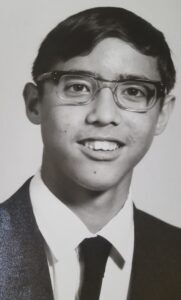 Frank Tyree during his senior year of high school
Frank Tyree during his senior year of high schoolTwo months before graduation, Frank went to a recruiter to enlist in the military. Although his father’s service influenced him to consider the Army, he often dreamed about sailing on a freighter to tropical islands in the South Pacific where warm ocean breezes and beautiful island girls awaited. His dreams won out, so he walked into a Navy recruiting office and told the recruiter he wanted to join the Navy. The recruiter said, “Sure, kid,” and asked Frank what kind of job he wanted. Frank told him he wanted to serve on submarines. Again, the recruiter said, “Sure, kid.” He then signed Frank up for the delayed entry program, which meant his enlistment would not begin until after he graduated from high school.
Frank graduated from West High School in May 1971 and reported for active duty on July 31. His parents saw him off at the Salt Lake City Armed Forces Examining and Entrance Station, with his father rendering him a crisp salute as Frank prepared to depart on a bus for boot camp at Naval Training Center, San Diego. Frank instinctively returned the salute, boarded the bus, and began his Navy career.
Having come from an Army family, Frank found the initial transition to boot camp life easy. For example, he arrived in San Diego with a regulation military haircut, leaving the barbers little to cut off. He also knew he had to wake up early at reveille each morning and keep his gear in good order, so he was as ready as he could be for what lay ahead.
Despite Frank’s preparation, boot camp still posed challenges. Frank learned this firsthand when an instructor determined his rack (bed) was not made tight enough. To make a point, the instructor threw Frank’s mattress—bedding and all—out the window. He then told Frank to get it and bring it back on the double. Frank did as instructed, but when he returned with his mattress, the instructor told him to throw it out the window again. This drill repeated itself several times until the instructor was satisfied he had worn Frank out.
Firefighting training was an integral part of boot camp. During one training evolution, Frank stood on the deck of mockup of a ship with a fire burning below deck. As Frank prepared to extinguish the flames, an instructor yelled, “What’s the eighth general order?” With flames coming out of the hatch from the deck below, Frank’s mind went blank, and he didn’t respond. Again, the instructor yelled, “What’s the eighth general order?” Getting ready to panic as the fire grew larger, Frank remembered and responded, “Report fires—Fire, Fire, Fire!” Finally, the instructor permitted him to put out the blaze. Frank would never again forget the eighth general order.
Frank graduated from boot camp in October 1971 and reported to “A-School” for Personnelman (PN) training. There he learned the administrative skills he needed to process the mountains of paperwork required by Navy commands to account for their sailors and keep their service records up to date. He completed PN training in December and reported as a new seaman apprentice to the USS Midway (CV-41), a massive aircraft carrier commissioned during the final days of World War II. He arrived near the pier where the Midway was tied up late on a foggy night with near zero visibility. When he got close to the pier, he saw the gigantic ship’s bow breaking through the fog. The ship looked so big he was sure he’d get onboard and be lost forever. Still, he managed to check in and began learning the ropes in the ship’s personnel office the next day.
In April 1972, Frank and the other sailors working with him got to test their PN skills when the captain ordered an emergency recall to the ship of all personnel, including those on leave (vacation). North Vietnam had just launched a major offensive, known as the Easter Offensive, against South Vietnam, threatening the country’s survival. As part of the U.S. response, the USS Midway was ordered to deploy to Yankee Station, a location at sea off the coast of North Vietnam where U.S. aircraft carriers routinely operated during the Vietnam War. Its mission was to launch planes on bombing missions in support of Operation Linebacker, which was intended to bring an end to the Easter Offensive by stopping the flow of war supplies to the North Vietnamese forces in South Vietnam. Aircraft from USS Midway and other Navy aircraft carriers, as well as Air Force bombers, participated in the operation, which halted the North’s offensive and eventually helped force the North Vietnamese to negotiate seriously for peace in Paris.
The war proved both real and personal for Frank and his shipmates operating on Yankee Station. On the night of October 24, 1972, a Navy A-6 Intruder returning to the USS Midway crashed as it attempted to land on the carrier after completing a bombing mission over North Vietnam. The plane plowed into aircraft parked on the flight deck, killing four sailors and starting a large fire. The A-6’s bombardier/navigator also died after he ejected from the plane and was lost over the side of the ship. As general quarters sounded, Frank’s repair party reported to the hangar deck—the deck of the ship immediately below the flight deck—where bombs were positioned on dollies in preparation for being loaded onto aircraft. Now the bombs were at risk of exploding because jet fuel poured down from the flight deck onto the ship’s lowered aircraft elevator, which was used to transport aircraft between the flight deck and the hangar deck. One spark could set everything ablaze and detonate the bombs. To keep that from happening, Frank and the other sailors in his repair party pushed the bomb-laden dollies through a curtain of jet fuel raining down onto the lowered aircraft elevator and jettisoned the bombs over the side of the ship. They then walked back through the jet fuel and repeated the process until all the bombs were gone. When Frank finished, he was drenched in jet fuel and traumatized by the crash and the loss of his shipmates.
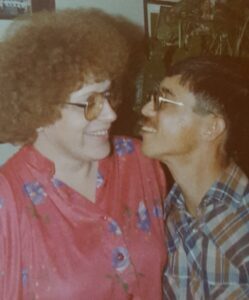 Frank and Sharon Tyree over the 1975 Christmas holiday
Frank and Sharon Tyree over the 1975 Christmas holidayLess than three months later, Frank took an offer to end his enlistment early. He received an honorable discharge in January 1973 and began attending classes at the University of Utah using his GI Bill. After a year, he decided college wasn’t working out and took a job as a truck driver. He also met and fell in love with a woman he met at a party, Sharon Lee Veatch, and they married thirty-nine days later, on November 4, 1975. When they were unable to have children themselves or adopt children because Frank didn’t earn enough money as a truck driver, they agreed Frank should join the Navy again so they could see the world together.
Reenlisting in the Navy proved harder than Frank expected. When he was honorably discharged early from his first enlistment in 1973, he had been given a reenlistment code that made it difficult to reenlist. This was intended to keep him from immediately reenlisting in return for bonuses or better assignments. Now, however, it was five years later, and those restrictions no longer applied. The Navy solved the issue by signing Frank to a two-year conditional enlistment and giving him orders to the USS Mobile (LKA-115), an amphibious cargo ship homeported in Seal Beach, California.
Another condition of Frank’s enlistment was that he was no longer a PN. Instead, he was an undesignated seaman apprentice who had to learn entirely new job skills. Accordingly, when he reported onboard USS Mobile, the ship assigned him to the Deck Division where he learned how to handle the rope lines used to launch and recover the ship’s boats. This was no small feat, as the two types of boats he worked with where fifty-six and seventy-four feet long, respectively.
Frank’s initial assignment was as a line tender, working behind the line handler to make sure the ropes didn’t entangle or injure him. On one occasion when Frank and his line handler were working below the ship’s bridge, the line handler felt ill and went to sick bay, leaving Frank on his own. Frank took over the line handler’s responsibilities, unaware the ship’s captain was watching him work from the bridge. After Frank finished the evolution, a first class petty officer told him the captain wanted to see him on the bridge. Frank reported to the bridge as ordered, wondering what he had done wrong. The captain did not chew him out—quite the contrary. He told Frank he’d been watching him work and asked if he would be willing to serve as the bow hook for his gig. Frank said he would, so the captain directed him to report to the boat group. When he got there, he told the petty officer in charge what had happened and then asked, “What’s a bow hook and a gig?” He soon learned the gig was the captain’s boat, and, as bow hook, it would be his job to keep watch at the boat’s bow and jump ashore with the bow line to secure the boat to the pier.
Working in the boat group, Frank learned everything he could about operating and maintaining the Mobile’s small boats. He worked hard on earning his coxswain qualification, so he would be able to drive the boats himself. That occasion came sooner than expected when an ensign got knocked over the side of the ship in Vancouver and fell into thirty-eight degree water. Frank and another sailor were in the captain’s gig ready to be lowered into the water, but the coxswain had not yet come aboard. With no time to waste, the gig was launched, and Frank took over the controls. He and the other sailor quickly made it to the ensign, who had drifted away from the Mobile in the strong current, and pulled him aboard. They then returned him to the ship, where the ensign was treated for hypothermia but was otherwise unhurt.
After Frank promoted to boatswain’s mate third class, he found himself in charge of the ship’s Second Division and its thirty seamen. This happened on short notice when the petty officer in charge of the division transferred, turning over his responsibilities to Frank one day before the ship’s captain conducted a zone inspection of the Second Division’s spaces. After assessing the spaces himself, Frank divided his sailors into three teams and directed them to get their spaces shipshape before leaving for the day. They finished by 8:00 p.m. and returned early the next morning for the inspection.
Frank escorted the captain through the division’s spaces, and the captain was impressed. However, at the end of the inspection when he turned to leave, he saw someone had spray painted “FTN” on a door, which everyone knew stood for F*** the Navy. The captain turned to Frank and said, “What is this?” Without hesitating, Frank replied, “It means Frank Tyree’s Navy.” The captain smiled and said, “Okay,” and walked out of the space. Frank Tyree’s Navy soon became a common phrase, even adorning the license plates on Frank’s motorcycle and car.
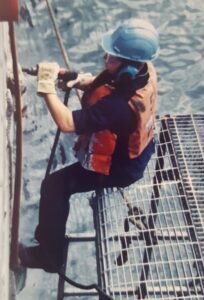 Frank Tyree working over the side of a ship
Frank Tyree working over the side of a shipAs Frank’s tour onboard USS Mobile drew to a close, he received orders to report to the U.S. Navy base in Yokosuka, Japan, known as Fleet Activities, Yokosuka. Accordingly, he detached from the Mobile in September 1984 and moved with Sharon to Yokosuka in November. Frank was assigned as a patrolman with the base’s military police. He also trained and qualified as the base traffic accident investigator.
Frank took his patrolman responsibilities seriously. One traffic stop in particular illustrated his approach. On this occasion, he pulled over a taxi for a traffic violation near a construction site. The driver was a sailor moonlighting to earn some extra money, and he told Frank he would be transferring to the military police to work with Frank in about a month. He then asked Frank if he could give him a break and not issue him a ticket since they would soon be shipmates. Frank explained that was not possible because to a military policeman, integrity was everything. He said if he played favorites, everyone would find out and his reputation would be irreparably damaged. He then gave the driver his ticket. One month later, the driver reported to the military police and began briefing prospective drivers on Japanese traffic laws. He used the story of Frank issuing him a ticket to reinforce the need for safety with Americans getting ready to drive in Japan, promising they would be ticketed if they did not obey the law.
During his time at Yokosuka, Frank investigated over 450 traffic accidents, arrested 90 drunk drivers, and issued over 1,000 tickets. Ten of the traffic accidents he investigated involved fatalities. Since all those fatalities involved alcohol, Frank had zero tolerance for drunk driving and worked hard to keep motorists on the Navy base safe. In fact, his stops for drunk driving included senior officers and even his own boss. For that reason, he built a solid reputation for honesty and fairness.
As the end of his enlistment neared, Frank had to decide whether to stay Navy or return to civilian life. Since it looked like he would be heading back to the USS Midway (which was now homeported in Yokosuka) if he reenlisted, he decided to get out because he did not want to be apart from Sharon during another long deployment. Accordingly, in March 1988, he and Sharon packed their belongings and returned to Salt Lake City.
Once back in Salt Lake City and with no concrete civilian opportunities, Frank and Sharon decided to give the Navy one more try. As Frank had been a boatswain’s mate first class at the time of his discharge, he had the experience the Navy needed. However, to maintain his previous rank upon reenlisting, he first signed with the Navy Reserve and then with the active Navy the following Monday. He then reported for Navy Veteran (NAVET) training at Naval Training Center, San Diego, where he was put in charge of physical training for all the Navy veterans returning with him to active duty. When he found many of those returning had forgotten what it meant to be part of the Navy team, he required the group to run in formation, never outpacing the group’s slowest members. The result was the group began working together as a unit rather than racing to the finish line as a bunch of individual sailors.
After completing NAVET training, Frank reported to the USS Proteus (AS-19), a submarine tender commissioned during World War II and homeported in Guam. Frank was assigned to the rigging locker, which meant he was responsible for properly rigging items to be hoisted by the ship’s massive cranes to and from nuclear-powered submarines. As at Fleet Activities, Yokosuka, he immersed himself in his work until he became the recognized rigging expert. Whenever the repair officer asked him if the rigging was acceptable and he said yes, the repair officer proceeded with the hoist without asking further questions. Similarly, if Frank said the hoist couldn’t be properly rigged for a safe lift, it wasn’t attempted. In recognition of his expertise and his years of Navy experience, Frank promoted to chief petty officer while onboard USS Proteus.
Frank’s expertise came in handy when the Gulf War loomed in January 1991. In anticipation of the start of hostilities, the nuclear-powered submarine USS Louisville (SSN 724) was given seventy-two hours’ notice to depart Guam to head to the Red Sea. The Proteus was charged with getting the Louisville ready to sail. Instead of taking seventy-two hours, Proteus completed the job in just twenty-four, allowing Louisville to reach her destination on time. Louisville then launched cruise missiles in the war against Iraq, becoming the first submarine to do so in combat.
Frank and Sharon lived in base housing on Guam until it came time for Frank to transfer in 1992. This time, Frank received orders for recruiting duty. After completing Recruiting School, he was put in charge of the Navy Recruiting Office in Ogden, Utah. When that office closed, he transferred to the Navy Recruiting Office in Salt Lake City. When it was announced that office would transition to officer recruiting, Frank was put in charge of preparing the office for the transition. During that time, Frank scored a major victory by recruiting a naval reactor engineer from Brigham Young University. Since naval reactor recruits often came from Ivy League schools in the northeast, this was a significant accomplishment for Frank and his office.
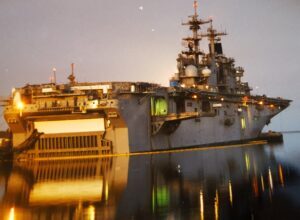 Photo taken by Frank Tyree of the USS Essex during its overhaul in 1997
Photo taken by Frank Tyree of the USS Essex during its overhaul in 1997When it came time for Frank to transfer again in 1994, he accepted orders to the USS Essex (LHD-2), homeported in San Diego. The Essex was a new amphibious assault ship commissioned in 1992 and designed to carry Marines, helicopters, and Harrier attack aircraft. Frank joined the ship in Hong Kong during its first deployment late in 1994. The highlights of the deployment involved rounding up a freighter trying to escape from the United Arab Emirates to Iran and, in January 1995, successfully covering the withdrawal of UN troops from Somalia.
Frank made one final deployment to the Persian Gulf onboard USS Essex commencing in October 1996. In addition to participating in several multinational exercises, the ship and its embarked Marines participated in Operation Southern Watch, enforcing the no-fly zone over Iraq. This meant the ship had to spend Christmas anchored off the coast of Kuwait in the Persian Gulf while the ship’s Marines were ashore. Since the ability to celebrate Christmas was limited ashore, the ship put on a big pageant telling the Christmas story. To make sure everyone could participate in the festivities, the ship’s Marines in Kuwait flew back to the ship in groups for a hot shower, a Christmas meal, and the opportunity to watch the pageant.
Frank had two sailors from the Deck Department participating in the pageant—both were playing the shepherds to whom an angel appeared announcing the birth of Christ. However, when the angel spoke to them, they both forgot their lines and had to improvise. The first sailor said, “Wow, did you see that?” The second, a young sailor with a thick Oklahoma accent and unique way of pronouncing words, responded, “Yeah man. That ‘war’ an angel!”
The two sailors’ unscripted dialogue had a profound impact on Frank. Their words, coming from the heart rather than the script, made the pageant seem even more real. So much so that Frank wrote about the story several years later to memorialize it forever. For him, it was the highlight of his second deployment on USS Essex.
The Essex returned to San Diego in April 1997. After a post-deployment standdown which allowed the returning sailors to spend time with their families, Frank, the leading chief in the Deck Department, helped coordinate a short overhaul. He then had a big decision to make. He had always told himself he would do his twenty years, retire, and spend the rest of his time with his beautiful wife. Although the chain of command tried to entice him with his likely promotion to senior chief petty officer, he decided to hold true to his plan and submit his retirement papers. In his final week, he also earned his Enlisted Surface Warfare Specialist pin, documenting the vast experience he’d gained over the course of his long career.
Frank officially retired in 1998. Although he and Sharon envisioned returning to Salt Lake City, his best friend onboard USS Proteus recommended they come to Springfield, Illinois, instead. This sounded good to Frank and Sharon because Sharon had been diagnosed with multiple sclerosis (MS) in 1980 and the Illinois climate seemed more agreeable to her condition. The move worked and Frank and Sharon have lived there ever since, although Sharon finally succumbed to MS and passed away in 2022 after fighting the disease for over forty years.
Despite retiring from the military over twenty-five years ago, Frank remains deeply connected to his Navy service. Part of his connection is rooted in the events surrounding the crash of the A-6 Intruder onboard the USS Midway in 1972. The loss of his shipmates and the bombs he had to carry through curtains of volatile jet fuel caused him to suffer from PTSD, which he deals with by writing poetry about his service experience. He also paid tribute to his lost shipmates in 2024 when he participated in an Honor Flight for veterans to Washington, D.C. When the Honor Flight veterans visited the Vietnam Veterans Memorial, Frank located all five of his lost shipmates’ names on the wall. Frank is also an active Service Officer with his Veterans of Foreign Wars (VFW) post—first with Post 10302 and later with Post 755. In this role, he assists veterans, their families, and anyone else in need. For example, he’s helped homeless veterans get off the streets and into permanent housing and delivered free medical equipment to those who cannot afford to purchase it on their own. Frank makes himself available to anyone who needs a helping hand.
Voices to Veterans is proud to salute Boatswain’s Mate Chief Frank Tyree, U.S. Navy (Retired), for his years of dedicated service to our country. A proud Vietnam veteran, Frank answered our country’s call during both peacetime and time of war. His service took him to many far-off places around the globe, where he endured long deployments away from family and friends. We thank Frank for all he has sacrificed and for his continued service to his community. Most of all, we wish him fair winds and following seas.
If you enjoyed Frank’s story, please sign up for the Voices to Veterans Spotlight monthly newsletter by clicking here. Once each month, you’ll receive a new written veteran’s story directly in your mailbox. Best of all, it’s free and you can unsubscribe at any time.
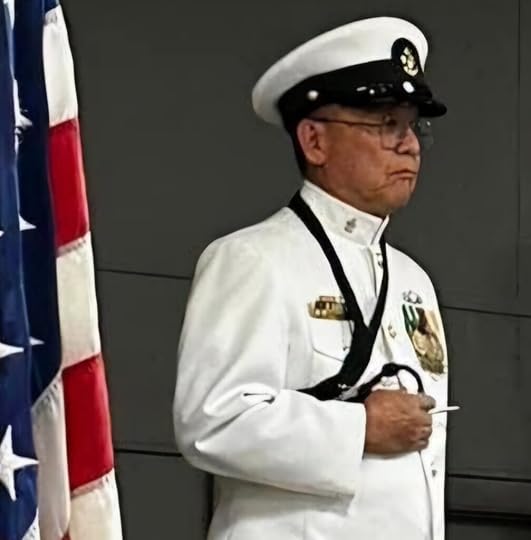 Boatswain’s Mate Chief Frank Tyree, U.S. Navy (Retired), rendering honors in 2024 for a World War II veteran who had passed away
Boatswain’s Mate Chief Frank Tyree, U.S. Navy (Retired), rendering honors in 2024 for a World War II veteran who had passed away The post BMC Frank Tyree – Twenty Years in the Navy: From Yankee Station to the Persian Gulf first appeared on David E. Grogan.
November 6, 2024
Chaplain, Colonel, Marion Reynolds, U.S. Air Force (Ret.) – Faithfully Serving Those Who Serve
Long deployments, work with nuclear weapons, the burden of killing or being killed, and a host of other factors combine to place unique pressures on military members. Fortunately, people like Chaplain, Colonel, Marion Reynolds, Chaplain Service, U.S. Air Force (Retired), feel called by their faith in God to help military members and their families cope with their stress. After serving five years as an enlisted airman, Marion served for twenty-three years as a chaplain, reaching out to airmen where they needed him most. He met with them at the alert facility as they waited for orders on what could be one-way missions. He spoke to them in silos with nuclear-equipped missiles standing at the ready just a few feet away. He consoled them at isolated duty stations around the world whenever they received bad news from home. And, most importantly, he walked in their shoes.
Marion was born in Louisville, Kentucky, in December 1937. His parents divorced when he was five, beginning a series of moves to multiple states he and his younger brother would make over the next ten years as they alternated living with their mother, their father, and other relatives. When Marion was nine, he went to live with his Great Aunt Nellie. She was a very religious person, and she had a profound effect on him. So much so that when Marion turned ten, he was baptized at the Carlisle Avenue Baptist Church in Louisville. He then went to live in Vincennes, Indiana, with his father, stepmother, and their two boys after they returned from working in Europe.
When Marion’s father took a job with the Wabash River Ordnance Works, the family moved to Dana, Indiana, a small town close to the Illinois border. Marion attended his first two years of high school at Dana High before his family moved to Joliet, Illinois, after his dad received a promotion. Marion spent his junior year at Lockport High School in Joliet and, after moving to Plainfield, Illinois, attended Plainfield High School his senior year. Given all the moves, Marion had no time to participate in organized high school activities, but he did manage to hold down a job at a local grocery store during his senior year.
One thing Marion did have time for was his love of aviation. Ever since he was a little boy, he was fascinated by airplanes. He built models with his dad, helping cement their bond. As Marion grew older, his love of aviation turned into a desire to enlist in the Air Force. By the time he graduated from Plainfield High in the spring of 1956, his desire to enlist had become his plan. He spent the summer with his mother and then signed up with the Air Force in October.
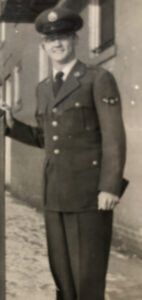 Marion Reynolds on leave in January 1957 after basic training
Marion Reynolds on leave in January 1957 after basic trainingMarion’s Air Force experience began at the Armed Forces Examining and Entrance Station in Chicago. After examinations proved he was physically and mentally qualified to serve and he took the oath of enlistment, he boarded a train for basic training at Lackland Air Force Base in San Antonio, Texas. Although he did well at the training, the aspect of his time at Lackland that affected him most was his interaction with the chaplains. The interaction began when he attended services at the base chapel on Sundays and expanded to other chapel-sponsored events as the weeks went on. The experience reinforced the interest his Great Aunt Nellie began when he was nine years old.
After graduating from basic training, Marion transferred to March Air Force Base outside of Riverside, California. Based on aptitude tests, he had been selected to work in a classified program with the Air Force intelligence community. He spent nine months at March learning his new trade, but, again, the most significant impact came from his participation in base chapel activities, including a single airman’s group. In fact, the impact was so strong, Marion felt called to become an Air Force chaplain.
As Marion’s training drew to a close, it came time to see where the Air Force would send him to put his new skills to use. The program he trained for offered two alternatives: at a base in Germany or at Fort Meade, Maryland. Fort Meade had several advantages if Marion were to pursue becoming a chaplain. First, his uncle was a pastor at a church about seventy miles south of Fort Meade, so Marion could learn what being a pastor entailed by visiting on weekends. Second, he could take on-base evening classes at the University of Maryland to begin fulfilling the educational prerequisites he needed to become a chaplain.
Not knowing which assignment he would get, Marion told himself if his orders were for Fort Meade, that was a clear sign from God he should pursue his dream of becoming a chaplain. Several days before his scheduled departure, he received his orders—he was on his way to Germany. Initially wondering if this meant he was mistaken in his sense of calling, he gradually determined he was still being called to the chaplaincy but would need to satisfy the educational requirements some other way. Then, he and the other airmen heading to Europe boarded a bus to go to the base clinic to get the shots they needed for their assignments overseas. As the bus started rolling, a sergeant ran after the bus and got it to stop. He climbed aboard and announced orders had been changed for ten people, including Marion. He was now on his way to Fort Meade.
Marion arrived at Fort Meade in November 1957. He stayed there for almost four years working on the classified program he’d trained for and promoting to senior airman. He lived in the barracks and, as per his plan, completed two years of college at the University of Maryland. He also visited his uncle’s church on weekends. During one such visit, his uncle introduced him to a young woman they had seen walking across the parking lot while they were talking on the church’s front porch. The woman’s name was Nancy, and she and Marion were married two years later in June 1960.
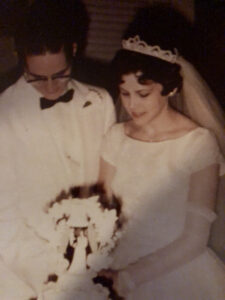 Marion and Nancy Reynolds on their wedding day
Marion and Nancy Reynolds on their wedding dayReady to pursue his calling in earnest, Marion was discharged from active duty in June 1961. He and Nancy moved to Moline, Illinois, so Marion could complete his bachelor’s degree in history at Augustana College in Rock Island, Illinois. Marion specifically picked Augustana because it was a Lutheran school and he wanted to diversify his religious background knowing that once he became a military chaplain, he would be responsible for ministering to servicemembers of all faiths. To keep food on the table, he sold life insurance and worked at the college’s power plant on the 5:00 p.m. to midnight shift. Nancy worked, too, as a certified practical nurse. She also gave birth to their first daughter, Leslie, while Marion was enrolled at Augustana.
After graduating from Augustana College in the spring of 1963, Marion and his family moved to Louisville so Marion could attend the Southern Baptist Theological Seminary. Being back in Louisville allowed him to spend time with Great Aunt Nellie, who was immensely proud her tutelage of nine-year-old Marion had helped turn him into a pastor. Nancy also gave birth to their second daughter, Lauren, during Marion’s time at the seminary.
Marion graduated from seminary in January 1967. He’d already been serving for a year as the pastor of Swallowfield Baptist Church, a small, rural church about sixty miles from Louisville. He worked there on weekends both before and after graduation until he had sufficient pastoral experience to apply to become a military chaplain. After graduation, he moved to Frankfurt to better serve the church. He also worked for the Kentucky Department of Public Assistance, providing him with a steady paycheck. Then, in August 1968, after receiving an endorsement from the Southern Baptist Convention Chaplain’s Commission, Marion got the news he’d been waiting for—he’d been accepted into the Air Force chaplain’s program. He commissioned as a 1st lieutenant that same month and promoted to captain when he came on active duty on November 12.
Although Marion hoped his first assignment would be in Florida near where his mother lived, the Air Force sent him in the opposite direction to Grand Forks Air Force Base in North Dakota. After his previous service, Marion felt like he was coming home when he stepped foot on the base, which served bomber, fighter, tanker, helicopter, and missile squadrons. Others recognized his enlisted experience, too. On Marion’s second day on the base, a first sergeant asked him if he was prior enlisted. When Marion, now a captain, said yes, the first sergeant said, “I thought so when I saw you salute a 2nd lieutenant.”
Marion was one of six chaplains serving on the base. His responsibilities included conducting services at the chapel, counseling airmen and their families, and visiting people at the hospital and other units on base. He also routinely visited the flight line and the alert stations late at night, talking to the aircrews waiting to see if they would get a call to fly a mission in the event of an attack from the Soviet Union. When they were on alert, the aircrews were isolated from their families with nothing to do but think about the possibility of being involved in a nuclear war. Marion’s late-night visits provided a welcome respite from their isolation, boredom, and fear.
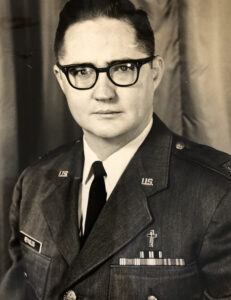 Chaplain Marion Reynolds at Grand Forks Air Force Base in 1968
Chaplain Marion Reynolds at Grand Forks Air Force Base in 1968Grand Forks’ winters were notoriously long and cold. During one of his conversations with an airman on alert, Marion asked what summers were like in Grand Forks. The airman replied, “I’m sorry, I can’t tell you. I slept in that day.” Despite living through two Grand Forks’ winters, Marion and his family had a wonderful time there. When it came time to transfer in the summer of 1970, Marion received orders to Kunsan Air Base, located about 110 miles south of Seoul, South Korea. Because the assignment would last only one year, the tour was unaccompanied. This meant Nancy and the girls would have to remain stateside. Although this was difficult for Marion, everyone assigned to Kunsan Air Base was in the same situation. Accordingly, Marion could relate to what they were experiencing. And, like everyone else at Kunsan, he also felt the constant stress of being so close to North Korea, which could invade its southern neighbor at any time without provocation or warning.
Marion served at the Kunsan Air Base chapel conducting services on Sundays and providing religious education to the base community. Since the chapel was at one end of the base and all the base offices were at the other end, the chaplains used a vehicle to meet with airmen in their workspaces. This worked well until an Inspector General (IG) team visited and needed vehicles, so the chapel had to give its up. To remedy the situation, the base commander let the chaplains go to the base’s junkyard and salvage an old van that had nothing in it but a driver’s seat and an open cargo space behind it. Marion and the other chaplains outfitted the van with two easy chairs. After collecting sandwiches and hot chocolate from the chow hall, they, together with the base security supervisor, drove it to the men standing watch at the guard posts around the base perimeter. At each post, the security supervisor relieved the sentry and his guard dog and stood their watch while the sentry sat in an easy chair enjoying a sandwich, hot chocolate, and friendly conversation. Once warmed in the van, both the sentry and his guard dog returned to their post.
The van proved an instant success until the IG departed and the chapel had to give it up. When the IG team heard about it after their departure, they recommended in their report that the chapel be given a new van, which it was. The only catch was the chapel had to share it with the commander of the 5th Air Force, who used the van to change uniforms in whenever he flew from his headquarters to Kunsan. Fortunately, the 5th Air Force commander only used the van once. The new van even had a sign on its sides, “Chaplain Mobile Office,” and a cross on the grill, both of which were removed when the 5th Air Force commander used the van. Working out of the Chaplain Mobile Office was one of the highlights of Marion’s tour.
Another highlight included the great relationships Marion forged with his fellow chaplains. This often played out in pranks, like the time Marion and a Catholic chaplain attached a Korean firecracker, which would detonate when strings at each end were pulled, to the toilet in their shared living facility. When the senior chaplain later raised the toilet seat, the firecracker exploded harmlessly but with a big boom. Later, when the Catholic chaplain went to take his shower in the same bathroom, he found the hot water knob missing and the bathroom window open, flooding the room with icy cold winter air. The pranks kept morale high and helped the men deal with the separation from their families.
The chaplains also helped others deal with being far from home. They always parked their Mobile Chaplain Office near the mail room after the mail plane arrived, knowing not a day would go by without someone receiving bad news. Marion and the other chaplains were there to listen and to console the recipient, hoping to make the hurt less painful.
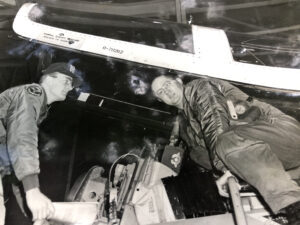 Chaplain Marion Reynolds (right) climbing into an F-101B “Voodoo” for a ride in the jet fighter in 1970
Chaplain Marion Reynolds (right) climbing into an F-101B “Voodoo” for a ride in the jet fighter in 1970Marion’s tour at Kunsan Air Base ended in the summer of 1971. He transferred to Moody Air Force Base in Valdosta, Georgia, where Nancy and their two girls joined him. Marion was one of four chaplains serving at the chapel there. One of his duties—and for all chaplains worldwide wherever assigned—was to assist in making casualty notifications to deceased servicemembers’ families. One late, rainy night, Marion accompanied a unit commander to notify the elderly parents of an officer that their son’s plane had been shot down in Vietnam and that he had been killed. Although the commander conveyed the horrible news, Marion provided comfort and support, not only to the parents, but also to the commander on the way to and from the notification. Always gut-wrenching, casualty notifications such as this were an essential part of Marion’s duties throughout his career.
Marion spent three years at Moody before receiving orders to be the lone chaplain at Morón Air Base in southern Spain. The base, which had the third longest runway in Europe and served as an alternate space shuttle landing site, was inactive but in a caretaker status in case U.S. military dependents or civilians from other places Europe needed a safe haven to escape a natural or man-made disaster.
Marion and his chaplain’s assistant ministered to the roughly 260 people maintaining the base’s buildings and runways and to the sailors operating a Navy communications facility on Morón. Nancy and their two daughters were also there, as were the families of all the base employees. All went well until it came time for Marion and Nancy’s oldest daughter to leave the on-base grade school to go to middle school. The only available option was a boarding school many hours away in Zaragoza, which Marion and Nancy considered no option at all. Accordingly, Nancy started home schooling their daughter, and she was soon joined by other students studying in the chapel library. Although it worked out in the end, reaching the resolution was stressful.
In March 1976, when people in the United States were celebrating the bicentennial, Marion organized a bus trip from Morón to the Friary of La Rábida in Palos de la Frontera, Spain. Christopher Columbus stayed at the Friary during his efforts to convince King Ferdinand and Queen Isabella to finance his first expedition to the New World. The Friary had on display containers with soil and the flags from every country in the Americas. The U.S. flag, however, was stained and ragged, so after the trip, Marion contacted the U.S. consulate in Seville. The result was a second visit to the Friary, this time with a representative from the consulate, to present a new American flag for the display. Afterwards, Marion and the representative celebrated with a meal together with their Spanish hosts.
With Morón Air Base already in a caretaker status, it came as no surprise when the Air Force downgraded the manning at the base so that it no longer included a chaplain. As a result, Marion transferred in the summer of 1977 to Davis-Monthan Air Force Base in Tucson, Arizona, promoting to major enroute. Although the base’s main mission involved flight training for the A-10 “Warthog” attack aircraft, Marion worked primarily with the missile and spotter plane commands. He also visited the airmen manning the Titan II nuclear missile silos located on base because they worked twenty-four-hour shifts and were isolated underground behind massive blast doors. Marion’s talks with the airmen helped them deal with their isolation and their immense responsibility. Marion and his family loved living in Tucson and spent four years there.
In 1981, Marion reported to his next assignment as the base chaplain at Albrook Air Force Station, located in the Panama Canal Zone on the east side of the canal. As the base chaplain, he was responsible for all chapel operations, including all assigned personnel. He and his family enjoyed their time living in Panama’s tropical climate. Adding to the enjoyment, Marion promoted to lieutenant colonel while there.
After three years in Panama, Marion received orders to attend the prestigious Air War College at Maxwell Air Force Base in Montgomery, Alabama. One of only two Air Force chaplains selected to attend, Marion participated in the course along with Air Force rising stars who would lead the service into the future. Working with them side-by-side for a year, Marion conveyed a realistic and positive view of how chaplains could help them accomplish their missions. Similarly, Marion learned about the other class members’ warfare areas and concerns, giving him a strategic view of his own responsibilities. The class also introduced Marion to civilian and military leaders at the national level during trips to Washington, D.C., where he visited the Pentagon, Supreme Court, and Congress. International class members with an entirely new set of experiences further broadened Marion’s perspective. In return, the class offered Marion the opportunity to minister to his classmates.
Marion graduated from the Air War College in the spring of 1985 and transferred to Norton Air Force Base in California to be part of the Air Force IG team of inspectors. His IG responsibilities took him to Air Force facilities around the world, where he helped evaluate and improve their religious programs by making recommendations based on regulatory requirements and his many years of personal experience. One of four chaplains on the IG team, Marion’s philosophy was to help the base religious programs solve problems and improve their effectiveness. Because those being inspected appreciated Marion’s attitude and help, he enjoyed his tour with the Air Force IG.
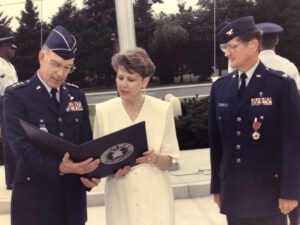 Chaplain Marion Reynolds (right) after Major General Richard E. Hawley (left) presented him with the Legion of Merit at his retirement ceremony. Nancy Reynolds is reviewing the award citation with the general.
Chaplain Marion Reynolds (right) after Major General Richard E. Hawley (left) presented him with the Legion of Merit at his retirement ceremony. Nancy Reynolds is reviewing the award citation with the general.In the summer of 1987, it came time to transfer again. This time Marion went to the Air Force Academy in Colorado Springs, Colorado. He and Nancy, now empty-nesters, lived in a wonderful three-bedroom on-base house, fully immersing them in the academy experience. Now a full colonel, Marion was responsible for the Community Center Chapel, which provided religious support to everyone living or working at the academy except cadets. He still dealt with the cadets during their orientation program and when he and Nancy sponsored individual cadets to give them a substitute family away from home. He also conducted the Christmas Eve service at the Air Force Academy Chapel, which members of the local community were invited to attend.
Marion transferred to his final duty station, the 5th Air Force headquarters at Yokota Air Base in Japan, during the summer of 1989. His boss was the three-star general commanding all forward deployed Air Force units in Japan. Marion, in turn, was responsible for supporting all the chaplains assigned to Air Force bases in Japan. This required him to periodically travel to other Air Force installations to meet with the base chaplains and to ensure they had what they needed to get their jobs done. He also initiated quarterly meetings with civilian missionaries serving in the greater Tokyo area, recruiting and preparing them to assist with the response in the event the base ever suffered a mass casualty event.
While he was at Yokota, Marion required surgery on his nose. Doctors at the Naval Hospital in Yokosuka, Japan, performed the surgery. While he was recuperating, Marion met a Navy corpsman who told him his father had been an Air Force chaplain. Marion asked the sailor his name and he said it was King. As it turned out, Chaplain King had ministered to Marion when he was an enlisted recruit at basic training, influencing him to become a chaplain himself. Marion had also crossed paths with Chaplain King years before during a trip to Kadena Air Base in Okinawa. Meeting Chaplain King’s son was a full circle moment for Marion, connecting the beginning of his Air Force career with the end.
Another notable moment occurred when Marion and Nancy attended a Christmas party hosted by a command doing classified work like the program Marion was involved in when he was an enlisted airman. As part of the festivities, the unit held a drawing to present a five-foot stuffed teddy bear to the lucky winner. The unit’s commanding officer took advantage of Marion’s presence and announced, “To avoid any suspicion about the drawing process, we have asked Chaplain Reynolds to draw the winning name.” Marion did as instructed and, unbelievably, pulled Nancy’s name from the hat. For many years thereafter, the teddy bear lived with Marion and Nancy, guarding their spare bathroom.
Marion retired at Yokota Air Base in February 1992. The 5th Air Force Commander honored him with a formal parade and retirement ceremony. One of the officers making remarks at the ceremony was a chaplain who had been a B-52 navigator Marion visited in the alert shack at Grand Forks Air Force Base over twenty years before. In addition, the officer who served as the Commander of the Troops was the son of a master sergeant Marion served with at Kunsan Air Base. The events were a fitting salute to Marion’s distinguished twenty-eight-year career.
After retiring from the Air Force, Marion and Nancy returned to Arkansas to begin the next chapter of their lives. Two years later, Marion became the Chaplain Coordinator for the Arkansas Baptist State Convention. He was responsible for coordinating with the Convention’s 300 chaplains serving in active duty, reserve, and National Guard military units and throughout the state in such places as hospitals, prisons, fire departments, and police departments. He continued in the position until September 2012, when he began working weekends as a hospital chaplain in North Little Rock. He stayed in that position until it was eliminated and has been volunteering ever since in the hospital’s rehabilitation unit. The hospital badge he wears identifies him not only as a volunteer, but also as a retired military member. When veterans see that on his badge, it immediately breaks down barriers and allows Marion to better encourage them in their recovery.
Voices to Veterans is proud to salute Chaplain Marion Reynolds for his long and distinguished career in the Air Force. Often assigned to remote areas, he went out of his way to bring comfort and a touch of home to military members dealing with isolation and life’s many challenges. His service took him across the globe to three continents, ministering to others and helping them cope with their important military responsibilities. We thank him for all he has done, and for all he continues to do for those recovering from injury or illness, and wish him fair winds and following seas.
If you enjoyed Marion’s story, please sign up for the Voices to Veterans Spotlight monthly newsletter by clicking here. Once each month, you’ll receive a new written veteran’s story directly in your mailbox. Best of all, it’s free and you can unsubscribe at any time.
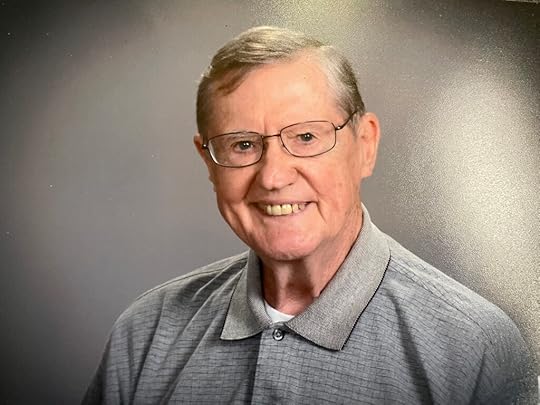 Chaplain, Colonel, Marion Reynolds, Chaplain Service, U.S. Air Force (Retired)
Chaplain, Colonel, Marion Reynolds, Chaplain Service, U.S. Air Force (Retired) The post Chaplain, Colonel, Marion Reynolds, U.S. Air Force (Ret.) – Faithfully Serving Those Who Serve first appeared on David E. Grogan.
October 16, 2024
Specialist Stacy Breithaupt, U.S. Army – Treating Soldiers and Detainees – A Combat Medic’s Story
Military members sign up to serve in whatever capacity their talents allow. Specialist Stacy Breithaupt knew early on she had an aptitude for healthcare, so it was only natural she became a combat medic. Soon she found herself treating soldiers and their families both in the United States and abroad. Then, in 2005, she deployed to Iraq working with detainees at the mammoth insurgent detention center at Camp Bucca. Less than one year later, it would be Stacy on the receiving end of medical care.
Stacy was born in September 1979 in Burton, Michigan, and grew up in typical Midwestern fashion. She was the second oldest of four siblings, all girls. She played sports for Bendle High School and enjoyed roller speed skating. She also earned money by babysitting, working as a cashier at Marco’s Pizza, and serving as a hostess at an Olive Garden restaurant. At that point, Stacy’s life stopped being typical because she had a plan.
Bored with high school during her senior year, Stacy sat for the GED exam in March 1997 and graduated that same month. With her high school degree in hand and influenced by the positive Army experience of her Aunt Teri, she marched to the nearest Army recruiting station. She enlisted in the Delayed Entry Program with an active duty start date of May 1. She was just seventeen years old.
When May 1 arrived and Stacy’s high school friends were sitting in their classes counting down the days until graduation, Stacy’s Army recruiter picked her up at home and dropped her off at the Military Entrance Processing Station (MEPS) in Troy, Michigan. After passing a final physical, taking the oath of enlistment, and spending the night in Troy, she flew to Fort Jackson, South Carolina, to begin her Army career.
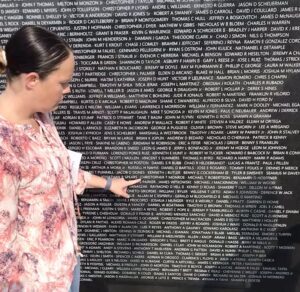 Stacy Breithaupt pointing to Specialist Christopher T. Monroe’s name on an Iraq War memorial
Stacy Breithaupt pointing to Specialist Christopher T. Monroe’s name on an Iraq War memorialBasic training at Fort Jackson brought no surprises. Stacy expected it to be a long and tiring process, and it lived up to her expectations. Still, she did well because she wanted to be there. She already knew how to shoot and was in great physical shape due to her high school sports and speed skating conditioning, so those aspects of her training posed no problems. Her only stumbling block was using topographical maps, a skill she eventually acquired after sufficient practice.
Stacy graduated from basic training just before the Fourth of July. She then began Advanced Individual Training (AIT) as a combat medic at Fort Sam Houston in San Antonio, Texas. There she learned the basic life-saving skills she needed to provide emergency medical care to wounded soldiers on the battlefield. Her job was keep the soldiers alive until they could be transported to medical facilities for more advanced treatment by doctors and nurses. She learned to give IVs, draw blood, manage medical records, administer medications, and triage injured soldiers. To help put what she learned into practice, she worked at the Troop Medical Clinic (TMC) at Fort Sam Houston.
Although Stacy learned quickly and loved every aspect of her training, it did have its drawbacks. Early on, the instructors identified her as having small veins and used her as a training aid anytime they wanted to demonstrate how to perform a difficult blood draw or IV insertion. The hot Texas summer also proved harsh for Stacy since she’d grown up in much cooler Michigan. So much so that three weeks into the course, she had to be hospitalized for three days due to heat exhaustion. For the rest of the training, her instructors repeatedly reminded her to stay hydrated so it wouldn’t happen again.
Stacy graduated second in her class from the combat medic course in October 1997, just one month after her eighteenth birthday. Not only did she qualify as a combat medic, but she also earned her Emergency Medical Technician (EMT) certification. Her performance demonstrated just how much she wanted to be a combat medic.
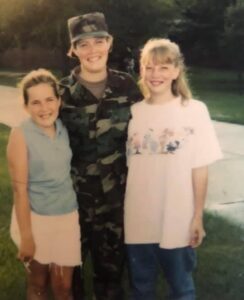 Specialist Stacy Breithaupt with her younger sisters
Specialist Stacy Breithaupt with her younger sistersAfter completing her training, Stacy reported to the 568th Ambulance Company at Camp Humphreys in South Korea. Located forty miles from Seoul and just sixty miles south of the demilitarized zone (DMZ) between South and North Korea, the camp sits on one of the most potentially volatile flashpoints in the world. Adding to the political tension, Stacy initially felt stressed being so far from home and living in a completely different culture. Once she acclimated to her new environment, she settled in and had a great overseas experience.
The 568th Ambulance Company’s leadership played a significant role in Stacy’s successful transition. Not only did they put her to work using her newly acquired medical skills at the Camp Humphreys TMC, but they also gave her flight medical training and assigned her to fly with the “Dustoff” helicopters evacuating injured soldiers by air. The Dustoff work challenged Stacy and made her want to come into work every day, as did her promotion to private second class and eventually private first class. She also worked with Korean soldiers and learned to speak some Korean. She even visited the DMZ and took time to tour other sites in South Korea.
In October 1998, Stacy transferred to the 261st Area Support Medical Battalion (ASMB) at Fort Bragg in Fayetteville, North Carolina. There she provided medical support for the 82nd Airborne Division’s parachute drop zones and the Air Assault School. She also worked at a local civilian hospital to maintain her EMT credentials. She stayed with the 261st ASMB until she transitioned to the Army Reserve in July 1999.
After leaving active duty, Stacy moved back to Michigan near her hometown. She immediately affiliated with the Army Reserve’s 431st Quartermaster Company in Lansing, just over sixty miles away. She drilled with the unit one weekend each month and an additional two weeks each year making sure the company’s soldiers were medically ready to deploy. This meant reviewing medical records to ensure soldiers had all their shots and were up to date on their dental checkups. She also followed-up with appropriate health resources for any soldiers with open medical needs. She did this until July 2003, when her original Army recruiter, now a reservist with the 785th Military Police Battalion, asked her to join his unit to help prepare it for an upcoming deployment to Iraq.
Stacy’s responsibilities at the 785th Military Police Battalion mirrored what she did for the quartermaster company. In addition, she taught the combat lifesaver course for the unit’s soldiers so they would be prepared to get a wounded comrade off the battlefield and to the medical treatment they needed. During these classes, Stacy taught the soldiers basic emergency tactical trauma techniques like administering IVs, applying pressure to wounds and bandaging them, and using tourniquets to stop bleeding.
 Specialist Stacy Breithaupt (right) with two soldiers at Camp Bucca in Iraq
Specialist Stacy Breithaupt (right) with two soldiers at Camp Bucca in IraqAs the time for deployment drew closer, the 785th Military Police Battalion moved from its headquarters in Fraser, Michigan, to Fort McCoy in Minnesota to complete required readiness processing. At the individual soldier level, this involved things like signing powers of attorney, executing wills, and reviewing service records to ensure they were accurate and complete. After Fort McCoy, Stacy and her battalion moved to Fort Dix, New Jersey, to learn the specific skills necessary for their upcoming assignment as military police providing security for the Theater Internment Facility (TIF) at Camp Bucca in southern Iraq. The TIF held Iraqi insurgents detained during the Iraq War and was a dangerous place to work. In fact, while Stacy and the rest of the company were training at Fort Dix, the detainees at the camp took a soldier hostage and rioted. Eventually, U.S. forces brought the situation under control, but not before four detainees were killed and others injured.
The training at Fort Dix was intense. In addition to practicing riot control techniques, the company rehearsed providing security for convoys, safely handling and moving detainees, and managing and providing security for the camp’s Special Housing Unit (SHU). As the company’s medic, Stacy needed additional training to prepare her to provide medical care for detainees. Accordingly, the battalion sent her and the other medical staff for a three-week course at Camp Shelby in Mississippi, where she was the only woman participating in a class of men. That got the course off to an awkward start, as there were no separate accommodations for women and a guard had to be posted outside the restrooms anytime Stacy used them. After four days, the course administrators moved her to a hotel off base and life became easier for everyone. Stacy went on to recertify as an EMT by obtaining her EMT-Intermediate certification, and she earned her Tactical Combat Casualty Care (TC3) designation. After completing the course, she rejoined the battalion still training at Fort Dix.
In May 2005, the 785th Military Police Battalion departed Fort Dix and headed for Camp Bucca. Enroute, the company stopped at Camp Buehring in northwest Kuwait to acclimate to the harsh desert environment. Stacy, now a specialist, and the rest of the battalion finally arrived at Camp Bucca near Umm Qasr in southern Iraq in June 2005.
For the first three months of the deployment, Stacy worked at Camp Bucca’s TMC providing medical care for U.S. soldiers and civilian contractors working at the camp. After that initial period, she assisted the company’s medical officer providing medical care for the detainees in the TIF. This included providing basic emergency care to any detainees who might be injured as well as giving them their medications, conducting blood draws, and administering IVs. She worked across three open-air detainee compounds housing over one hundred detainees each, making tracking and sorting their medications a challenge. Because the detainees were unpredictable and could be dangerous, Stacy had to be alert and ready for anything whenever she worked within the facility.
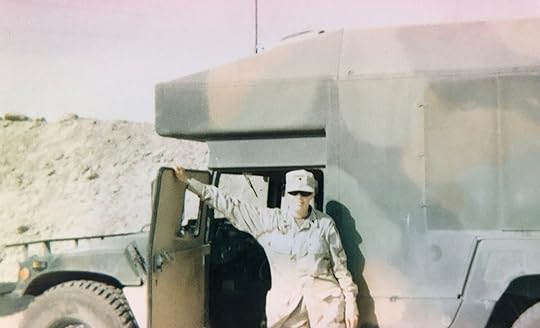 Specialist Stacy Breithaupt on convoy duty in Iraq
Specialist Stacy Breithaupt on convoy duty in IraqIn addition to her responsibilities within the TIF, Stacy participated in convoys transporting detainees between Camp Bucca and the detention facility at Abu Ghraib, located approximately 350 miles away in the vicinity of Baghdad. During these convoys, she rode in an ambulance and had to be prepared to render any medical assistance required, including administering medications the detainees needed to take during the transport. The convoys were always at risk of attack, either by insurgent forces or by improvised explosive devices (IEDs) hidden along the route. To underline the danger, Apache attack helicopters flew above the convoys to ward off would-be attackers. Still, the convoys were vulnerable. In September, two servicemembers from Camp Bucca were killed when their vehicle struck an IED. One month later, on October 25, Stacy lost a good friend, Specialist Christopher T. Monroe, when he was killed during a convoy.
The danger continued even after the convoys reached their destinations. Once, after arriving at Abu Ghraib, Stacy was walking in the camp when a large explosion detonated near the front gate. The force was powerful enough to knock bricks off the wall near where Stacy stood. She also had to deal with a riot at Camp Bucca, where her parked vehicle was destroyed and a detainee escaped. Another time, three detainees managed to dig their way out of the compound. Although they were recaptured, the specter of detainees running loose around the camp kept Stacy on edge.
Stacy also participated in recovery operations when IEDs disabled or destroyed convoy vehicles. When this occurred, wreckers were dispatched to recover the damaged vehicles. If anyone was injured or killed in the attack, Stacy accompanied the recovery team in an ambulance to help treat the injured parties and bring them or any deceased persons back to the camp.
In November 2005, Stacy started feeling run down. She initially attributed her condition to working in the TIF eighteen hours a day, seven days a week, while wearing all the required protective gear in the oppressive Iraqi heat. Eventually, the company sent her to Camp Arifjan in Kuwait, where she was diagnosed with a bacterial infection in her stomach. While still foggy from the anesthetics used during the exam, she was returned to Camp Bucca with antibiotics and directed to go back to work because the battalion needed her.
The antibiotics did not work, and Stacy’s stomach condition worsened to the point where, by the beginning of January 2006, she could no longer eat. Major Grundy, the battalion medical officer she worked for, tried to help, but he didn’t have the necessary testing equipment and therefore had no idea what was causing her symptoms. Still, her command expected her to work although she struggled to make it through each day. When Stacy could take it no more, she told her commanding officer she could no longer work and that if he didn’t send her for treatment, she would be leaving Iraq in a body bag. The battalion finally medevacked her to the Army hospital in Langstuhl, Germany.
When Stacy arrived at the Army hospital, she weighed only eighty-nine pounds. The doctors spent the next week ensuring she was stable enough to transport back to the United States. At the end of January, she was medevacked on a C-130 to Walter Reed National Military Medical Center in Bethesda, Maryland. When she woke up, the command leadership team of the 18th Military Police Brigade was there by her bedside. They wanted to know her perspective on how her condition had been allowed to get to the point it had.
Although Stacy appreciated their willingness to hear her story, she was angry. She felt as though she had taken excellent care of the 785th Military Police Battalion’s soldiers, but when it came to her own health, the command had let her down. Now she just wanted to recuperate and get on with her life as a civilian. The healthcare team at Walter Reed helped make that possible by correctly diagnosing the cause of her condition as an intestinal parasite she had somehow acquired in Iraq. The good news was now that the problem had been identified, it could be treated. That bad news was the condition had been allowed to fester for so long, Stacy sustained permanent organ damage. She spent the next three months at Walter Reed and Fort Dix getting back on her feet. Eventually, she would undergo thirteen surgeries to repair the damage caused by the parasite.
Stacy did not wait for the surgeries before transitioning out of the Army. In fact, she was discharged from Walter Reed on April 1, 2006, and honorably discharged from the Army Reserve on the same day. She then returned to Michigan to continue her treatment through the Veterans Administration (VA).
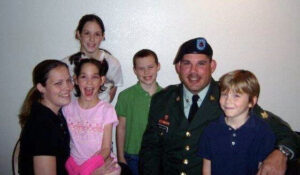 Specialist Stacy Breithaupt (left) with her husband, Sergeant David Breithaupt (in uniform), and their children
Specialist Stacy Breithaupt (left) with her husband, Sergeant David Breithaupt (in uniform), and their childrenAlthough Stacy no longer wore an Army uniform, her association with the Army continued through her husband, Sergeant David Breithaupt. He took active duty orders in June 2007, and Stacy moved with him to Fort Stewart, Georgia. In July 2008—the first time Stacy was healthy enough to work again—she accepted a civilian position as the 92nd Engineer Battalion Family Readiness Support Assistant helping Army family members understand the support programs available to them. She would take similar civilian positions with the 3rd Battalion of the 7th Infantry Regiment at Fort Stewart, the 321st Infantry Regiment at the Army Reserve Center in Winterville, North Carolina, and the 94th Training Division at Fort Lee, Virginia. Stacy finally retired from the Civil Service in 2021. At the time, she was working with the Greenville North Carolina VA. During her Civil Service employment she also earned her bachelor’s degree in business administration.
Stacy and David now live in Michigan. They raised four children together: Caleb, Melissa (who sadly passed away in November 2019), Maegen, and Anthony. Staff Sergeant Anthony Breithaupt followed in his parents’ footsteps and is a Ranger scout in the 101st Airborne Division. Stacy and David enjoy traveling and spending time with family. Wanting to continue her lifelong mission of supporting the military, veterans, and their families, Stacy is an active member of Blue Star Mothers of America.
Voices to Veterans is proud to salute Specialist Stacy Breithaupt for her dedicated years of service to the Army. At great personal cost to herself, she rendered medical care to soldiers and civilians in need both in peacetime and in war. She deployed to Iraq at a crucial time in the Iraq War, rendering medical assistance to friend and foe alike. She then defeated a debilitating illness, only to continue serving Army families in her civilian capacity. We thank her for all her sacrifices and wish her fair winds and following seas.
If you enjoyed Stacy’s story, please sign up for the Voices to Veterans Spotlight monthly newsletter by clicking here. Once each month, you’ll receive a new written veteran’s story directly in your mailbox. Best of all, it’s free and you can unsubscribe at any time.
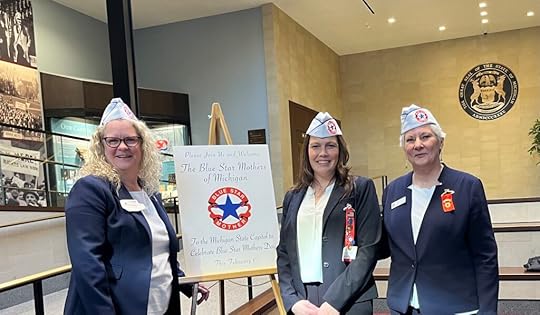 Stacy Breithaupt (center) with other members of the Blue Star Mothers of Michigan
Stacy Breithaupt (center) with other members of the Blue Star Mothers of Michigan The post Specialist Stacy Breithaupt, U.S. Army – Treating Soldiers and Detainees – A Combat Medic’s Story first appeared on David E. Grogan.
September 12, 2024
AW1 Thomas W. Hayes, U.S. Navy Reserve (Retired) – Three Rescues in Two Days
Navy sailors train over and over so they are prepared to do their jobs under any circumstances. Be it peacetime or war, they must be ready to accomplish their missions even at the risk of their own lives. Aviation Anti-Submarine Warfare Operator 1st Class Thomas W. Hayes, U.S. Navy Reserve (Retired), trained as a search and rescue swimmer and deployed aboard aircraft carriers in case he was needed to save downed aircrew from the ocean’s icy waters. Because of his efforts, three aviators lived to fly again another day. This is his story.
Tom was born in November 1953 in Highland Park, Michigan. His father settled there after his hitch in the Air Force during the Korean War, although the family eventually put down permanent roots in East Detroit. Tom and his two younger sisters attended East Detroit High School, a huge school enrolling 3600 students in the top three grades. Tom found his niche in the choir, which he sang with all three years and served as the choir president during his senior year. He also worked at Chatham’s grocery store to keep some spending money in his pockets, but the real headline from his time at high school was he started dating his future wife, Regina Marie Laesch, during his senior year.
Tom graduated from East Detroit High School during the spring of 1972 and began working full time at Chatham’s grocery store as part of the night crew stocking shelves. His mom wanted him to go to college, but Tom knew he wasn’t ready. What he was ready for was getting married, which he and Regina did in 1975. By the summer of 1976, Tom knew he needed more than a career at the grocery store. He discussed his thoughts with Regina and asked her if she would be okay with him joining the military. When she gave him the green light, he headed for the nearest Armed Forces Recruiting Station to see what the military had to offer.
The recruiting station had recruiters from all four services, so Tom decided to talk to the Marines first. He asked the sharp-looking Marine gunnery sergeant (“gunny”) what the Marines could do for him. The gunny stood up and told him he would get to wear the Marine uniform. Tom was looking for more than that, so he made his way to the Navy. Admittedly, the Navy had a leg up on the other services before Tom even walked into the recruiting station. That’s because when Tom was a boy, his family visited a Navy ship tied up along the Detroit River. When the ship got underway for family day, Tom went along because one of the ship’s petty officers was a family friend and they let Tom steer the ship. As if that experience wasn’t enough, the Navy recruiter was a high school classmate of Tom’s. He had joined the Navy right after graduation and was now back in Detroit on recruiting duty.
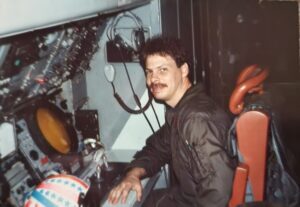 Tom Hayes at his radar station on board a P-3 Orion while assigned to VP-93
Tom Hayes at his radar station on board a P-3 Orion while assigned to VP-93The recruiter asked Tom what he wanted to do if he joined and Tom said he would love to fly. The recruiter told him the Navy had just the job for him – an Aviation Anti-Submarine Warfare Operator or “AW”. He told Tom if he became an AW, he could serve on the big four-engine anti-submarine aircraft known as the P-3 “Orion” and he would never have to serve on a ship. That was music to Tom’s ears because avoiding long periods away from home while deployed on a ship would work best for him and Regina. He told the recruiter if he could make him an AW, he was in.
To seal the deal, Tom passed the initial physical exam and took the Armed Services Vocational Aptitude Battery (ASVAB), a prerequisite to enlisting. After processing the results, the recruiter informed Tom he could not get him the AW job they had discussed, but he could make him an Operations Specialist (OS). Knowing that meant extended time at sea on ships, Tom told the recruiter since he could not make Tom an AW, he was no longer interested in enlisting. The recruiter told Tom to give him fifteen minutes and he disappeared. He returned at the end of the time period and told Tom he’d gotten him the AW job after all. That was all Tom needed to hear and he enlisted in the Delayed Entry Program with an active duty report date of September 22, 1976.
When September 22 arrived, Tom and approximately thirty other new recruits reported as ordered. They were escorted to the train station for the trip to boot camp. As they waited for the train, a Navy petty officer handed Tom a folder with everyone’s name in it. He told Tom since he was the oldest recruit, he was in charge and responsible for making sure everyone arrived safely at Naval Station Great Lakes for boot camp. His Navy career had officially begun.
Tom succeeded at his first tasking as everyone was accounted for when the train arrived at Union Station in Chicago late in the evening. Then they were all herded onto a bus for the final leg of the journey to Naval Station Great Lakes, located about an hour north of Chicago. They arrived early on the morning on September 23 and “hell broke out right away” as the transition from civilian to sailor began.
Tom felt prepared for the ordeal because his father had given him an idea of what to expect upon arrival. Above all else, he told Tom never to volunteer for anything. This rang true when the company commander asked for volunteers to drive his Cadillac. Hands shot up and the company commander selected his volunteers. The chosen few were all smiles until they learned the company commander’s Cadillac was a bucket of water on wheels with a mop for swabbing floors.
Although Tom dodged that bullet, he could not avoid being designated as the Recruit Chief Petty Officer, or “RPOC”, after the recruit in the position before him lost the job for being a jerk. As the RPOC, Tom called the cadence when the company marched around the base between training events and to chow. He also served as the Recruit Division Commander’s primary assistant, responsible for keeping everyone in the company in line. As for Tom’s predecessor, he got what he deserved for being a jerk. As the company marched to the chow hall one afternoon, the jerk and his friend were both targeted by a seagull. With pinpoint accuracy, the seagull dropped a bomb that splattered on both recruits at the same time. Tom describes the event as karma in action.
After graduating from boot camp two weeks before Christmas in 1976, Tom reported to Naval Air Station Memphis for AW “A” school. There he learned the basics of being an Aviation Anti-Submarine Warfare Operator. He also had to pass the Class II swim test. Tom did well in the classroom part of the training, but he especially excelled at swimming because he’d been a swimmer all his life and was already a certified lifeguard and diver. A Navy SEAL chief petty officer administered the swim test and, after he saw Tom swim, took him aside and said, “Son, you’re going to the fleet. They really need swimmers.”
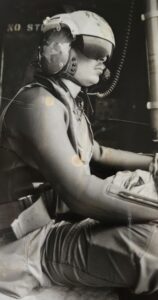 Tom Hayes wearing a wetsuit while flying plane guard on an SH-3 Sea King helicopter
Tom Hayes wearing a wetsuit while flying plane guard on an SH-3 Sea King helicopterThe SEAL chief’s evaluation completely changed Tom’s trajectory. Instead of heading to P-3 ASW patrol aircraft operating only from Navy airfields ashore, now he would be an aircrewman on the SH-3 Sea King helicopter getting underway on ships for long periods away from home. It also meant he would train to be a rescue swimmer, ready to jump from helicopters into the ocean to pluck downed pilots from the water before they drowned.
Tom’s training as an SH-3 helicopter aircrewman began immediately after AW “A” school. First, he spent five weeks attending Search and Rescue (SAR) swimmer school in Jacksonville, Florida. There he learned basic first aid, practiced treading water for long periods, and built his endurance through constant physical training. He also learned skills like getting someone out of a parachute while in the water and rescuing a combative swimmer. For his final exam, he had to jump into a disaster situation where five or six people needed to be rescued. He had to assess each person’s situation, prioritize their rescue, and then use the appropriate technique to successfully rescue each person. The final test kept him working in the water for a full forty-five minutes, but when he emerged, he was a qualified SAR swimmer.
Tom next reported to Survival, Evasion, Resistance, and Escape (SERE) school at Naval Air Station Brunswick, Maine. He spent a week and a half there learning what to do in the event he was ever captured by enemy forces. Although Tom was an experienced outdoorsman because he had gone camping with his father growing up, the entire experience proved a challenge. He was glad when it was over.
After SERE school, Tom reported to HS-1, the SH-3 Sea King helicopter Readiness Air Group (RAG), onboard Naval Air Station Jacksonville. All newly arriving SH-3 enlisted aircrew and officer pilots on the East Coast received their final training there before reporting to a fleet SH-3 helicopter squadron. At HS-1, Tom got his first taste of flying as an aircrewman in a helicopter, accumulating twenty-five hours of flying time. He obtained additional training hours in an SH-3 simulator, but by the time it came time to transfer to an operational squadron in the fleet, he had yet to jump out of a helicopter to conduct a practice rescue.
The reason Tom did not get to conduct a practice jump was because the fleet really needed rescue swimmers. To meet the demand, HS-1 condensed Tom’s training timeline and sent him off to his first permanent duty assignment at HS-15, a fleet SH-3 squadron also located onboard Naval Air Station Jacksonville. This worked out well because he had previously moved Regina to Jacksonville while he was in SAR school. They purchased a mobile home near the base and prepared to welcome their first child in early 1978. Before that, though, the HS-15 “Red Lions” had plans for Tom that would take him far from home.
Those plans involved the squadron and all its personnel, including Tom, deploying on the aircraft carrier USS America (CV-66) on September 29, 1977. Once the ship got underway on the cruise, Tom took his turn working in the ship’s main galley “mess cranking”, doing duties necessary to help feed the America’s 5,000 crewmembers, but the usual six-week assignment for new sailors was reduced to two weeks because the ship needed his skills as a SAR swimmer more than it needed him to wash dishes.
The America put Tom’s skills to the test one night in November 1977 when the ship was conducting flight operations in the Mediterranean Sea. While Tom was flying on an SH-3 conducting a night ASW mission in the vicinity of the aircraft carrier, an F-14 “Tomcat” jet fighter, made famous in the 1986 film Top Gun starring Tom Cruise, tried to land on the ship’s flight deck. The plane’s tailhook caught the arresting wire but the wire failed. Both the pilot and the radar intercept officer (RIO) ejected from the plane before it went over the side, with both men landing in the calm but pitch-black water.
Immediately, the ship put out the call “two men in the water.” Without waiting for direction, Tom took off his helmet and put on his wet suit as the helicopter’s pilot maneuvered the SH-3 to the area where the two men might be. Soon they saw a pencil flair launched from one of the downed crewmembers and the SH-3’s pilot positioned the helicopter for the rescue.
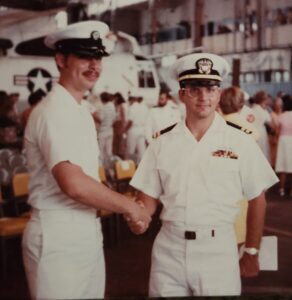 Tom Hayes (left) shaking hands in the HS-15 hangar at Naval Air Station Jacksonville with Lieutenant Stampe (right) after Tom received the Navy and Marine Corps Medal
Tom Hayes (left) shaking hands in the HS-15 hangar at Naval Air Station Jacksonville with Lieutenant Stampe (right) after Tom received the Navy and Marine Corps MedalBecause it was dark, Tom could not see if there was any debris from the F-14 in the water, making it unsafe to jump in. Accordingly, he grabbed onto the helicopter’s rescue hook and was lowered into the water. He then swam to the waiting RIO, Lieutenant Stampe. Just as he had been trained, Tom freed the lieutenant from his parachute and attached him to the rescue hook so he could be lifted into the helicopter. After Lieutenant Stampe was safely onboard, it was Tom’s turn. Then the helicopter flew them both back to the America, where they were checked by medical and found to be in good health. The F-14 pilot was also fine, having been rescued by the SAR swimmer from the SH-3 flying plane guard (the helicopter whose job it was to be ready to rescue downed aircrew during flight operations). For his part in the successful rescue, Tom was awarded a ceremonial shot of brandy. He was also a hero to Lieutenant Stampe’s F-14 squadron, the VF-142 “Ghostriders”.
Less than twenty-four hours later, an EA-6B “Prowler” electronic warfare plane’s jet engines flamed out during its landing approach, causing all three crewmembers to eject into the water. Again, Tom was nearby on an ASW mission in an SH-3 and the pilot moved in for the rescue. Although it was daylight, eighteen to twenty-foot waves made the rescue perilous. As on the previous day, Tom donned his wetsuit and then jumped into the ocean to rescue one of the downed airmen. Despite the high seas, the rescue went perfectly and soon the downed airman and Tom were back in the helicopter. The surprise came when the helicopter’s other aircrewman told him there was another aviator in the water and they had to get him, too.
Tom positioned himself in the door of the helicopter, getting ready to time his jump so he’d land in the crest of a wave. Suddenly, a giant rogue wave came in and the pilot said “whoa!” over the intercom. The helicopter’s other aircrewman thought the pilot said “go” and gave Tom a shove, launching him out of the helicopter. The timing of the shove couldn’t have been worse. Instead of falling a short distance to the crest of the wave, Tom fell sixty feet into the trough making a hard landing. Shaken but uninjured, he swam to the downed aviator and helped the helicopter safely extract him from the water. Soon, the two EA-6B aircrew he rescued joined the one rescued by the plane guard helicopter on the ship and all were cleared by medical. Again, Tom enjoyed his ceremonial brandy. He was also awarded the Navy and Marine Corps Medal for heroism as a result of all three of his rescues. One of Tom’s fellow SAR swimmers remarked he’d been a SAR swimmer for five years and never made a rescue, whereas Tom had been a SAR swimmer for only a few months and had already made three in just two days.
 An SH-3 Sea King helicopter from HS-15
An SH-3 Sea King helicopter from HS-15From a SAR rescue perspective, the rest of the cruise was uneventful. In December, however, Tom learned Regina was having complications with her pregnancy, so he rushed back to Jacksonville to be with her. Fortunately, on January 3, 1978, Regina gave birth to a healthy baby girl, Shanna. With both mother and daughter doing well, Tom had to head back to ship, which he did via Norfolk, Virginia, where he waited for a flight to Italy. In the meantime, he was assigned to shore patrol, escorting sailors who’d gotten into trouble to their disciplinary hearings and courts-martial. After he caught his flight, he rejoined the America in Genoa, Italy. He flew on ASW and plane guard missions on SH-3s for the rest of the cruise and sailed back with the ship to Norfolk in late April 1978 at the end of the seven-month deployment.
Tom and the rest of HS-15 got some well-deserved rest at Naval Air Station Jacksonville, Florida, after the deployment. In addition to spending time with Regina and Shanna, Tom made several trips with his squadron to the Atlantic Undersea Test and Evaluation Center (AUTEC) range in the Bahamas, where the helicopter crews practiced their anti-submarine warfare skills and snuck in some snorkeling time in the beautiful waters around the islands. Soon, though, it came time to begin workups for the next long deployment, this time aboard the aircraft carrier USS Independence (CV-63).
Workups for the USS Independence cruise meant training off the east coast of the United States and in the Caribbean to hone everyone’s skills before heading to the Mediterranean Sea. During the Caribbean training, the USS Independence anchored at Naval Station Guantanamo Bay, Cuba. As this was the height of the Cold War, tensions were always high. So, when “General Quarters, General Quarters – this is not a drill” sounded over the 1MC (the ship’s internal communication system), Tom and everyone else feared the worst. By the time Tom made it to his battle station on the flight deck, though, he learned the reason for the alarm was a fire in one of the ship’s generators. The fire was quickly resolved, and the Independence departed Guantanamo Bay on schedule.
HS-15 and Tom deployed aboard USS Independence to the Mediterranean Sea on June 28, 1979, shortly after Regina gave birth in May to their second child, Thomas. Aside from fascinating port calls in Athens, Greece, and Haifa, Israel, where Tom took tours of various ancient world sites, the deployment was uneventful. He returned with the ship to the United States on December 14, 1979.
After his deployment on USS Independence, Tom made the difficult decision not to reenlist. His original plan for the Navy had been to be part of a P-3 aircrew so he would not have to deploy onboard ships. Instead, he’d already completed two full deployments plus all the related at-sea workup time within the space of three years. So much time away from his young family was tough on everyone, so he and Regina thought it best to tell the Navy goodbye. Accordingly, in September 1980, Tom was honorably discharged from active duty and the family returned to East Detroit.
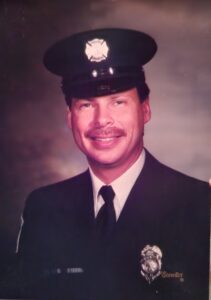 Eastpointe Fire Department Captain Tom Hayes
Eastpointe Fire Department Captain Tom HayesFortunately for Tom, his job at Chatham’s grocery store was waiting for him when he arrived back in East Detroit. This gave him the immediate income he needed to keep his family afloat, but it wasn’t what he was looking for long term. Instead, he set his sights on becoming a fire fighter and began taking classes at nearby Macomb Community College to earn his EMT certification. He also completed firefighter training and worked for the city of East Detroit as a paid-on-call firefighter, which meant he only got paid for the hours he spent fighting fires. This was a prerequisite to becoming a full-time firefighter, which he did for the city of East Detroit in 1983.
Tom also missed his time in the Navy and by coincidence, there was a Navy Reserve P-3 squadron (VP-93) operating just fifteen minutes away at Naval Air Facility Detroit onboard Selfridge Air National Guard Base. The squadron was a perfect fit, offering exactly what Tom enlisted for back in 1976. He would serve as a radar operator on a P-3 with a commitment to drill one weekend each month and two weeks each year. That schedule worked for Regina, too, so Tom enlisted in the Reserves as an Aviation Anti-Submarine Warfare Operator Petty Officer 2nd Class (abbreviated as AW2).
Until Tom became a full-time firefighter, his schedule remained challenging. He worked full-time at Chatham’s grocery store, served as a paid-on-call firefighter for East Detroit, and trained and drilled for his radar operator position at VP-93. He especially enjoyed his time at VP-93 because his shipmates were professionals in every sense of the word and they formed a close-knit group. While part of VP-93, Tom flew on P-3 flights conducting Cold War missions to detect and track Soviet submarines. He also flew on missions supporting the interdiction of drug smugglers in the Caribbean and participated in operations involving Haiti and the former Yugoslavia.
Tom would have stayed at VP-93 forever, but in 1993 the squadron was decommissioned as part of the Base Realignment and Closure Commission (BRACC). Afterwards, he did a short stint with the Barbers Point ASROC (anti-submarine rocket) Augmentation Unit but was bored because it involved mostly classroom work. He then learned another Reserve P-3 squadron, VP-64 out of Naval Air Station Willow Grove in Pennsylvania, could use his radar operator skills. He agreed provided the squadron could send a plane to pick him up for his monthly drills, which it did because it had also enlisted the services of other VP-93 sailors in Michigan now in need of a Reserve home.
 AW1 Tom Hayes (right) being presented with an award at his retirement ceremony
AW1 Tom Hayes (right) being presented with an award at his retirement ceremonyAlthough Tom enjoyed the missions he participated in with VP-64, including a trip to Scotland, he missed the comradery of VP-93. Accordingly, when VP-64 couldn’t guarantee he’d promote to chief even though he was an experienced first class petty officer and had already passed the chief’s exam, he decided it was time to retire from the Navy. He did so in October 1997 after completing over twenty years of distinguished active duty and Reserve service.
Now a civilian, Tom continued with his career as a firefighter for the city of East Detroit, which changed its name to Eastpointe in 1992. He retired a captain in 2011 after thirty years. For the last seven of those years, and extending through 2019, he also served as a rescue diver jumping out of helicopters to save offshore racers after their high-speed boats were involved in accidents. He made his last rescue jump in 2017 at the age of sixty-four.
In 2019, Tom and Regina attended a reunion of those who had served aboard USS America. The reunion was held in Virginia Beach and one of the events involved a visit to the Military Aviation Museum. When Tom and Regina’s bus pulled up to the museum, which includes an operational airfield so the vintage aircraft can fly demonstration flights, two docents came aboard. One asked if anyone on the bus was on the America’s 1977 Mediterranean cruise. After Tom and some other people raised their hands, the docent asked if they remembered the F-14 that went over the side after the arresting wire broke. Tom responded, “Yeah, and I’m the guy who picked up the RIO, a Lieutenant Stampe.” The docent then pointed to himself and said that was him.
Tom and Regina are now retired in Eastpointe, Michigan. They enjoy spending time with Shanna and Thomas and their children, who all live within a day’s drive. Tom also enjoys working part time and playing golf, and is active in the Red Knights Firefighters Motorcycle Club of Michigan.
Voices to Veterans is proud to salute Aviation Anti-Submarine Warfare Operator 1st Class Thomas W. Hayes, U.S. Navy Reserve (Retired), for his many years of dedicated service to our country. Early in his career, he made two deployments to the Mediterranean Sea, repeatedly risking his life to rescue downed aircrew. He then spent the remainder of his career patrolling the oceans for Soviet submarines and interdicting drug smugglers trying to gain access to our shores. For all he has done, and for all he and his family sacrificed on our behalf, we wish him fair winds and following seas.
If you enjoyed Tom’s story, please sign up for the Voices to Veterans Spotlight monthly newsletter by clicking here. Once each month, you’ll receive a new written veteran’s story directly in your mailbox. Best of all, it’s free and you can unsubscribe at any time.
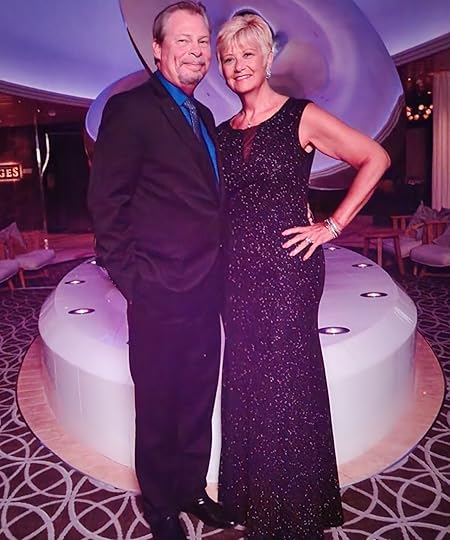 Tom and Regina Hayes
Tom and Regina Hayes The post AW1 Thomas W. Hayes, U.S. Navy Reserve (Retired) – Three Rescues in Two Days first appeared on David E. Grogan.
August 14, 2024
Captain Olena Fergurson, U.S. Army (Retired) – Service, Sacrifice, and Resilience
When men and women join today’s military, they have no way of knowing what sacrifices their service may entail or what fate may have in store for them. Despite this uncertainty, they willingly commit to serving our country, no matter the personal cost. For this reason, they deserve our respect and have earned the right to be called heroes, whether they train troops in Georgia or end up in harm’s way somewhere across the globe. Captain Olena Fergurson, U.S. Army (Retired), is one such hero. After leading troops stateside for years, she volunteered for service in Iraq. Five months later, the C-130 transport plane she was flying in crashed in the Iraqi desert. This is her story.
Olena’s mother and father immigrated to the United States with their parents in the aftermath of World War II. In fact, her mother was born on the ship bringing her from Europe to the United States as it crossed the Atlantic Ocean. Her father, who was from Lviv, Ukraine, came to America via England, and both her parents entered the United States through Ellis Island. They grew up, met, and were married in Cleveland, Ohio, which has a significant Ukrainian American community.
Olena was born in Cleveland in 1970, and her little brother followed three years later. On Saturdays, both attended Ukrainian school to learn about their family’s heritage and Ukraine’s culture, history, literature, and geography. They also learned the Ukrainian language and were fluent in both English and Ukrainian, a skill that would help Olena during her military career.
When it came time for high school, Olena attended Padua High School, a Franciscan high school in Parma, Ohio. She played soccer on a team her father coached in a Ukrainian American Soccer League. She also started working at Dairy Queen when she was sixteen, but the summer job she enjoyed most was working at the Cleveland Zoo. She started out making snow cones but soon promoted to operating a small gift shop by herself. The jobs gave her the spending money and independence she needed to have a little fun throughout the school year.
After graduating from Padua High School in June 1988, Olena enrolled at Cleveland State University in the fall. Her college experience began typically in that she majored in psychology and joined the Sigma Kappa sorority. However, at the end of her sophomore year, she decided to enlist in the Army Reserve, a decision she had thought about for some time. Her uncle, Jon Nych, who had been a Marine in Vietnam, was a major influence on her, but the primary reason she enlisted was the pride she and her parents felt about being U.S. citizens. America opened her doors to Olena’s family and allowed them to escape the Bolsheviks taking over Ukraine after World War II. For them, American citizenship was better than winning the lottery – it offered opportunity and a chance to live in freedom. Olena saw her enlistment as a way to say “thank you” to America on behalf of her and her parents. Military service was something she was passionate about.
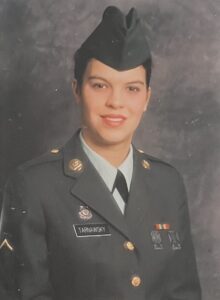 Private Olena Tarnawsky (Fergurson)
Private Olena Tarnawsky (Fergurson)Olena knew she could participate in ROTC while attending Cleveland State and be commissioned an Army officer upon graduation. However, she also wanted to serve as an enlisted soldier, working her way up through the ranks and having all the same experiences as the soldiers she would someday lead as an officer. The Army had the solution – the Simultaneous Membership Program (SMP). The program allowed Olena to join the Army Reserve and attend basic training and Advanced Individual Training, then return to school to finish her degree and earn her commission through ROTC. The SMP had the added benefit of paying Olena for her reserve duties and helping her accumulate retirement points, but the program’s main benefit was it furthered Olena’s goal of serving her country in the Army.
Olena formally enlisted as part of the SMP on May 29, 1990. Then, instead of beginning her junior year at Cleveland State in the fall, she reported on August 15 for basic training at Fort McClellan in Anniston, Alabama. The timing was significant because just thirteen days before, on August 2, Operation Desert Shield began as the United States started building up forces in the Middle East in response to Iraq’s invasion of Kuwait. Olena had previously convinced her parents not to worry about her Army commitment because the United States was not at war when she enlisted. Now, with war on the horizon, her parents were concerned for her safety. In contrast, Olena hoped she could complete her training in time to contribute to the U.S. war effort.
Basic training at Fort McClellan began with in-processing in a large auditorium. Afterwards, the new recruits were issued their uniforms and their bed linens. They also had to go through an initial physical fitness screening, which Olena passed with flying colors. She had started running and working out in preparation for basic training at the time she enlisted, so she was in great shape by the time she arrived. Her physical conditioning, coupled with coming from a strict Ukrainian Catholic family, prepared her well for the challenges she would face and she excelled.
Still, basic training was no walk in the park. Like her male counterparts, Olena trained on the M16 rifle, did KP (“kitchen police”), learned how to use a bayonet, and had to crawl through the mud under barbed wire while live fire whizzed overhead. During one pugil stick training event, Olena was randomly paired to fight against her best friend. Initially, they were afraid to hit each other, but after the drill sergeant told them everyone would have to do pushups if they did not fight hard, they beat each other mercilessly with the giant Q-tip like batons until the drill sergeant was satisfied. No one had to do pushups.
Olena graduated from basic training in October 1990. Her mother and her Uncle Jon surprised her by showing up at the ceremony, making it even more meaningful. After graduation, Olena went directly to Advanced Individual Training (AIT) at Fort Jackson in Columbia, South Carolina. While she had hoped to go directly into the medical field, the timing was wrong and she could not get a slot. Instead, she became an Administrative Specialist with a Military Occupational Specialty (MOS) designation of 71L. As an Admin Specialist, her job would be to perform clerical functions for whatever command she was ultimately assigned to.
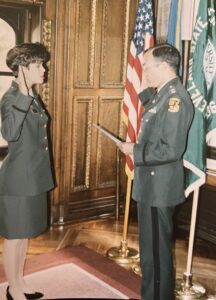 Olena Fergurson being commissioned at Cleveland State University as a new 2nd lieutenant
Olena Fergurson being commissioned at Cleveland State University as a new 2nd lieutenantNear the end of December 1990, Olena completed AIT and reported as a newly minted private (E-2) to her first reserve command, the 256th General Hospital in Cleveland, Ohio. The command’s location allowed Olena to return to Cleveland State University for the 1991 spring semester while drilling one weekend each month and two weeks out of the year with her reserve unit. In addition, she enrolled in Cleveland State’s Army ROTC program, paving the way for her to become a commissioned officer. This meant she pulled double military duty, drilling with the 256th General Hospital and training with Cleveland State’s ROTC unit. Furthermore, when the 256th General Hospital needed her, she had to miss classes and learn her college course material on her own. She also took an active role in the transition of the 256th General Hospital to the more mobile and responsive 256th Combat Support Hospital (CSH). Finally, during the summer break between her junior and senior years, she attended Army Basic Leadership Skills training in the field at Fort Bragg, North Carolina, as part of her ROTC requirements. While these obligations made her last two years of college more challenging, Olena was fully committed to both her education and the Army. She did whatever it took to make everything work.
Olena graduated from Cleveland State on May 28, 1994, with a bachelor’s degree in psychology. On that same day, she traded in her sergeant stripes for an officer’s commission as a 2nd lieutenant (O-1) in the U.S. Army Reserve. Her position at the 256th Combat Support Hospital changed, too. Instead of being an enlisted Admin Specialist, she was now the hospital’s Admin Officer, known as the “S1” in Army parlance. That meant she was responsible for managing all the hospital’s administrative functions and for leading the Admin Department’s enlisted soldiers.
In January 1995, Olena took a break from her duties at the 256th Combat Support Hospital to attend the Officer Basic Course (OBC) at the Army Medical Department (AMEDD) school at Fort Sam Houston in San Antonio, Texas. There she learned the fundamentals of being an officer in the Army’s Medical Service Corps. More specifically, she learned the administrative side of Army healthcare, including how to oversee patient care and how to run hospitals and other medical units. Once she completed the training in late April 1995, she was officially designated a Health Services Administration Officer.
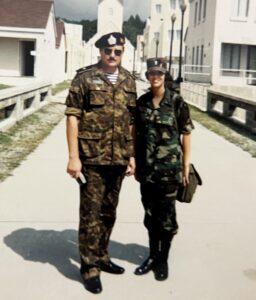 Rear Admiral Nikolay Kostrov with 2nd Lieutenant Olena Fergurson
Rear Admiral Nikolay Kostrov with 2nd Lieutenant Olena FergursonIronically, Olena’s first assignment after OBC had nothing to do with her newly earned qualifications. The assignment stemmed from a message her mother received from a colonel at the Pentagon about two weeks before Olena’s OBC course ended. After confirming Olena’s fluency in Ukrainian, the colonel asked Olena’s mother to have Olena call him as soon as she completed the OBC course. This she did and she soon found herself assigned for a month as an interpreter for Rear Admiral Nikolay Kostrov of the Ukrainian Naval Infantry, whose unit was participating in a Partnership for Peace exercise with U.S. Marines at Camp Lejeune, North Carolina.
Once her interpreter assignment ended, Olena returned to the 256th Combat Support Hospital. In addition to her normal duties as the hospital’s Admin Officer, she represented the command in the Army Ten-Mile Race for both 1995 and 1996 and assisted with physical exams and blood draws at the Louis Stokes Cleveland Department of Veterans Affairs Medical Center. Then in 1996, her language skills again proved useful as she was asked to be an interpreter for a military intelligence unit in Sterling Heights, Michigan. She drilled with the unit for two years and in her off time began working on her master’s degree in education and counseling at Cleveland State University. She completed her assignment with the military intelligence unit in 1998 and transferred to the Individual Ready Reserve (IRR) to give her a full year to complete her master’s degree. She earned her advanced degree in May 1999 after completing her thesis and the required clinical work.
With her new degree in hand and now a 1st lieutenant (O-2), Olena received active duty orders to report to Womack Army Medical Center at Fort Bragg, North Carolina, in August 1999. There she served as a healthcare administrator working alongside doctors and nurses to provide quality medical care to soldiers and their families. She remained in this assignment through the turbulent days after the September 11, 2001, terrorist attacks on the World Trade Center towers and the Pentagon. In 2003, she received orders to report to the hospital on MacDill Air Force Base in Tampa, Florida, and subsequently to Fort Buchanan and Camp Salinas in Puerto Rico to help prepare members of the Puerto Rico National Guard for deployment to Afghanistan.
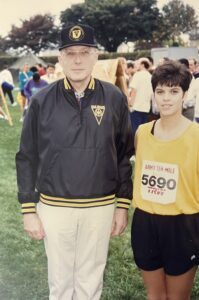 Chief of the Army Reserve Command with 2nd Lieutenant Olena Fergurson after the Army Ten-Mile Race
Chief of the Army Reserve Command with 2nd Lieutenant Olena Fergurson after the Army Ten-Mile RaceAfter her assignment in Puerto Rico, Olena went off active duty and returned to Cleveland. To maintain her reserve affiliation, she drilled with the 785th Military Police Battalion in Fraser, Michigan, and promoted to captain (O-3) shortly after beginning her assignment as the unit’s Medical Service Corps Officer. At the same time, the U.S. was engaged in wars in both Afghanistan and Iraq and needed officers to support the war efforts. As a result, in 2006, Olena again received active duty orders for duty at Womack Army Medical Center at Fort Bragg. She was subsequently considered for deployment with a civil affairs and psychological operations command (CAPOC) unit in either Iraq or Afghanistan, but AMEDD would not allow her to leave her current assignment. Accordingly, she continued to work at Womack Army Medical Center, including teaching and certifying combat life saver skills to 1600 troops preparing to deploy to Iraq. She remained at Fort Bragg until her active duty period ended in 2007.
After her assignment at Womack, Olena heard the Army Materiel Command at Fort Belvoir, Virginia, needed officers for work in Iraq. Olena volunteered and her request was approved. She reported to Fort Belvoir on January 2, 2008, and prepared to deploy for a year as an individual augmentee (IA), which meant she would deploy as an individual for a specific job in Iraq rather than deploy as part of an intact unit. After about a month of training for her new job as a Logistics Support Officer (LSO), she boarded a flight to Ali A Salim Air Base and Camp Buehring in northwestern Kuwait where she completed in-processing. Then she flew on a C-130 transport plane from Ali A Salim to Baghdad in Iraq, where she worked at Camp Slayer.
Olena’s responsibilities at Camp Slayer were significant. As an LSO, she was responsible for making sure the Combatant Commanders had everything they needed to support their troops. To do this, she prepared statements of work for contractors like Kellogg, Brown & Root so they could fulfill the Combatant Commanders’ requirements. Examples of projects she worked on included constructing dining hall facilities, expanding containerized housing units, and arranging major repairs to shower facilities. Many of the items involved significant quality of life issues for the troops, who were conducting their missions in the harsh Iraqi desert environment.
In June 2008, Olena agreed to relieve a fellow LSO in Kuwait for a few days and then return to Baghdad to continue her work. She and thirty-three other passengers took off around noon from Baghdad International Airport in a C-130 transport plane. About sixty seconds into the flight something went wrong and three of the airplane’s four engines lost power as the aircraft struggled to gain altitude. The pilot tried to put down the plane’s landing gears but there was insufficient time for them to extend all the way.
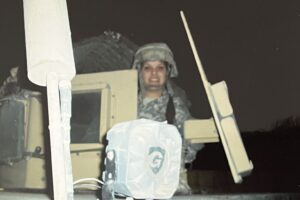 Captain Olena Fergurson returning to Camp Slayer as part of a convoy from Forward Operating Base (FOB) Constitution in Iraq
Captain Olena Fergurson returning to Camp Slayer as part of a convoy from Forward Operating Base (FOB) Constitution in IraqOlena, who had always had an intense fear of flying, noticed the face of one of the plane’s crewmembers cringe and his hands tighten their grip on his seat. She felt the plane going down and thought it must have been hit by an insurgent anti-aircraft missile. Suddenly, the giant plane slammed onto the ground doing around 160 knots (184 mph). Because the landing gears had not fully extended or locked in place, they thrust upwards when the plane hit the ground, splitting apart the floor of the cargo bay where all the passengers were seated. Gear flew about and pummeled the passengers as the plane slid across the Iraqi desert. Olena looked at pallets at the rear of the cargo bay and feared they would break loose and crush everyone still strapped into their seats, but they held fast. Then everything went eerily silent.
At first, the crew could not open the cargo bay doors because they were jammed. Olena saw a fire as she looked around, as well as sand that had entered the plane through its cracked underbelly. She thought they would be trapped inside and burn. The crewmembers finally pried the doors open and all thirty-four stunned passengers and four crewmembers escaped from the downed aircraft.
No one knew exactly where they were other than they were in hostile territory outside Baghdad’s Green Zone with only four small weapons. The crew set up a defensive perimeter and soon saw Iraqis approaching with a white flag – they turned out to be the Iraqi police. Then Apache helicopters started flying overhead to protect the area and everyone knew they would be safe. Miraculously, no one was killed in the crash.
Once ground forces were flown in to protect the crash site, Olena and the other passengers were flown on Blackhawk helicopters to Sather Air Base on the west side of Baghdad International Airport. Although Olena displayed no apparent injuries, she complained of a very bad headache. This did not raise concerns at the time and she was returned to her workplace at Camp Slayer.
Olena picked up her duties where she left off before the flight, but it soon became clear the injury she suffered was more than just a headache. Each day, she progressively began to display more and more symptoms consistent with traumatic brain injury (TBI). Not recognizing the symptoms’ cause or implications, Olena’s command sent her back to Army Materiel Command headquarters at Fort Belvoir, where she worked for two months as her symptoms continued to worsen. Finally, a medical professional at the base clinic traced the origin of the symptoms to the crash and Olena was sent to Walter Reed National Military Medical Center in Washington, DC, where the diagnosis of TBI was confirmed.
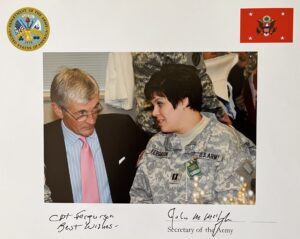 Secretary of the Army John M. McHugh speaking with Captain Olena Fergurson at the Pentagon
Secretary of the Army John M. McHugh speaking with Captain Olena Fergurson at the PentagonTo address her TBI, Olena was transferred to the Warrior Transition Unit at Walter Reed. Over the next two years, she received treatment for her injuries, including physical therapy, occupational therapy, and multiple surgeries on her neck and spine, and had the opportunity to work at the Defense Threat Reduction Agency (DTRA). The ordeal also gave her the opportunity to meet other wounded warriors at Walter Reed and Army leaders at the Pentagon (including the Secretary of the Army), all of whom inspired her and helped her forge the positive attitude she needed to navigate some of the toughest days of her life. She and other wounded warriors even got to attend President Barrack Obama’s inaugural ball in January 2009. Finally, in December 2009, Olena was released from the Warrior Transition Unit. She subsequently retired from the Army Reserve in November 2010 after over twenty years of distinguished service and began her life as a civilian.
Although Olena’s Army days are behind her, she continues to support the U.S. military. She actively participates in Post 24 of the Ukrainian American Veterans and Chapter 8 of the Ukrainian National Women’s League of America. As she looks back over her service, she is proud of what she accomplished and the crucial role women play in today’s military, sacrificing and serving in every capacity to further our nation’s defense. She is also proud of her resilience after being seriously injured in the C-130 crash in Iraq, doggedly sticking with her treatment and therapy programs until she overcame her injuries. She hopes her story will serve as a light to others who have suffered similar trauma, offering a promise of hope that they, too, can overcome their injuries. In that sense, Olena’s life fulfills a dream she had of pursuing a doctorate to counsel military members struggling with life’s complex issues, albeit through a slightly different means than a PhD.
Voices to Veterans is proud to salute Captain Olena Fergurson, U.S. Army (Retired), for her many years of dedicated service to our country. Over her twenty-year career, she helped countless soldiers and their families get the medical care they needed and ensured units deploying to Iraq and Afghanistan had the medical training they required. When the Army needed officers to serve in Iraq, she willingly volunteered to go into harm’s way. She survived a major plane crash in hostile territory and pulled herself through a long and difficult recovery period, only to continue serving veterans in her community. We thank Olena for all she has done and wish her fair winds and following seas.
If you enjoyed Olena’s story, please sign up for the Voices to Veterans Spotlight monthly newsletter by clicking here. Once each month, you’ll receive a new written veteran’s story directly in your mailbox. Best of all, it’s free and you can unsubscribe at any time.
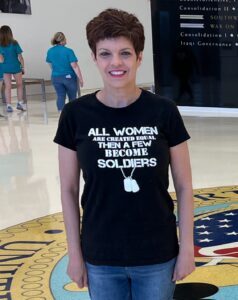 Captain Olena Fergurson, U.S. Army (Retired)
Captain Olena Fergurson, U.S. Army (Retired) The post Captain Olena Fergurson, U.S. Army (Retired) – Service, Sacrifice, and Resilience first appeared on David E. Grogan.
July 17, 2024
Private First Class Raymond Jubera, U.S. Marine Corps – A City Boy Helps Make History
To some, it seems our lives are pre-ordained. They believe where we are from and whether our parents are rich or poor may well determine how we will turn out in life. Private First Class Raymond Jubera didn’t believe that. Instead of letting life control him, he took control of his life and was “all in” with the decisions he made. As a result, he participated in history rather than just reading about it in a newspaper. This is his story.
Ray’s grandfather immigrated from Mexico and made his way north until he settled in Dassel, Minnesota, where he worked on sugar beet farms. When his sons were old enough, they worked on the farms, too. However, Ray’s father tired of the farms and moved to Chicago in search of greater opportunity. There he found a job at a factory, got married to Ray’s mother who had moved to Chicago from Texas, and started a family.
Ray was born in July 1955 and had three brothers and three sisters. Although both his father and mother worked, they only earned enough money to put food on the table and a roof over their heads. Still, the family was close-knit, and the kids had fun playing baseball and football in the streets out in front of their home.
As Ray grew older, the neighborhood grew tougher and more dangerous. The public schools were integrating and racial tensions were high. The schools struggled to deal with the issues, making learning difficult for the students. Frustrated, many of Ray’s peers dropped out. Ray was frustrated, too, but he wanted to graduate from high school. He knew, though, that wasn’t going to happen if he stayed in Chicago, so he took the extraordinary step of asking his aunt and uncle in Minneapolis, Minnesota, if he could come to live with them and finish high school there. When they agreed, he said goodbye to his family and headed north in the summer of 1973 to start his senior year of high school at a new school.
Roosevelt High School in Minneapolis was everything Ray dreamed a high school should be, like something out of a movie. Instead of the bare minimums in everything Ray had grown accustomed to at his school in Chicago, he found sports teams and activities aplenty. Unfortunately, because he had to catch up on some missing credits to graduate on time, he couldn’t take advantage of any of them. While other seniors were able to go home early because they already had the credits they needed to graduate, Ray attended school each day from start to finish. He also attended classes two nights a week and, as if that schedule wasn’t rigorous enough, worked on the off nights and on weekends at a Sears shipping and receiving center.
Ray’s hard work paid off when he graduated from Roosevelt High School in June 1974, the first of his family to earn his high school diploma. Grateful to his aunt and uncle for having taken him in but not wanting to impose further, he moved in with his cousin. The move was a package deal because his cousin’s husband managed a landscaping company and Ray started to work for the company laying sod. He also flirted with attending the University of Minnesota in the fall, but college was not his top option because his family had always emphasized hard work rather than the luxury of a college education.
One option his family did have experience with was military service. Ray’s father fought in the Korean War and one of his uncles on his mother’s side served in World War II. Even closer, Ray’s older brother, Ruben, had joined the Marines and was currently on active duty. Ray looked up to Ruben, who was a year-and-a-half older than him. He also admired the Marines, which he considered the most elite U.S. military service. Above all, Ray loved the United States and all that it stands for. Accordingly, when the summer of 1974 landscaping season ended, Ray visited a Marine Corps recruiter and enlisted for two years.
Ray reported for active duty on September 19, 1974. He flew from Minneapolis to San Diego, California, to attend boot camp at Marine Corps Recruit Depot (MCRD) San Diego. The expected yelling started as soon as the sergeants met the newly arriving recruits at the airport. “Get on the bus, get on the bus!” they shouted. The busload of recruits arrived at MCRD San Diego around 2:30 a.m. The initiation began immediately with the recruits marching to the barbers, who were waiting with clippers in hand to shave everyone’s head. Ray and the other recruits started laughing at the change, all having arrived just minutes before with shoulder length hair and now all were essentially bald. The sergeants brought the laughter to an abrupt end, ordering the recruits to line up and stand at attention. Anyone who so much as flinched brought the ire of a drill sergeant down on them and pushups until their arms could do no more. Ray and the other recruits learned quickly if they were going to make it through boot camp, they had to follow orders to the letter.
The physical training at boot camp proved Ray’s biggest challenge. When he lived in Chicago with his parents, he was known as “Little Ray”, measuring in at 5’7”, 160 pounds. In Minneapolis during his senior year, he grew two inches and gained a lot of weight eating his aunt’s abundant cooking. Now one drill sergeant made it his personal mission to get Ray in fighting shape, pushing him with extra exercise. When the platoon waited in line for chow, stopped by the administrative offices to get paperwork done, or visited the clinic to get their medical checks, the drill sergeants had Ray and the other recruits doing pushups, squat thrusts, and other exercises until they were exhausted. Early on before Ray could see how fit he was becoming, he started to wonder whether he had made a mistake by enlisting in the Marines.
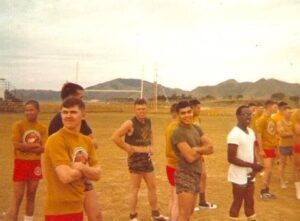 Ray Jubera (arms crossed in the middle of the photo) with other Marines at PT on Okinawa
Ray Jubera (arms crossed in the middle of the photo) with other Marines at PT on OkinawaSoon, the constant exercise and the drill sergeant’s extra attention proved Ray had not made a mistake. Upon first arriving, he took his initial physical fitness (PT) test, running three miles in twenty-eight minutes, doing ten pullups, and completing forty sit-ups in two minutes. At his final PT test, Ray completed the run in just seventeen minutes, did thirteen pullups and over sixty sit-ups. Twelve weeks of boot camp enabled him to get into the best shape of his life and he was proud of his accomplishment. Later in life he would run two Chicago Marathons, something he is sure would not have been possible without his Marine Corps training instilling in him the commitment to never give up.
Some of Ray’s training, including M16 rifle training, occurred at Camp Pendleton, located about forty miles north of San Diego. There Ray observed newly minted Marines continuing their training after having graduated from boot camp. They looked sharp in their uniforms and marched with such precision that they inspired Ray to work hard at everything he did so he could one day join their ranks. Back at MCRD San Diego, he also watched planes take off from nearby San Diego International Airport and looked forward to the day when he would be a new Marine onboard one of those flights heading to his first permanent duty station.
Graduation day finally arrived shortly before Christmas in 1974. Having successfully completed the arduous three-month ordeal, including qualifying as a Sharpshooter with the M16 rifle, Ray had earned the privilege of being called a Marine. Not everyone who started boot camp with him made it to the finish line. Of the eighty-five original members in his training platoon, only about sixty graduated. Those who didn’t make it dropped out for a variety of reasons, including not being able to meet the physical standards, medical issues, and having a bad attitude. Ray was both relieved and proud to learn he had what it takes to be a Marine.
Because Ray enlisted for just two years, there was never any doubt what his MOS (Military Occupational Specialty) would be – infantry. Other MOS’s required additional training, but a two-year enlistment offered insufficient time for the Marine Corps to train a new Marine and then recoup its investment. For Ray, that meant a month of follow-on infantry training at Camp Pendleton, where he would now be one of the polished new Marines being observed by recruits training at the rifle range. The infantry training involved learning small unit tactics in the field, including live-fire weapons training. It also meant getting to experience liberty off base for the first time and enjoying time at the on-base Enlisted Club.
Upon completion of infantry training, Ray received orders to his first operational unit, Alpha Company of the 1st Battalion, 4th Marines (1/4 Marines), located on Okinawa, Japan. Now it was his turn to board a plane some other recruit at MCRD San Diego might be watching take off. Once he arrived on Okinawa, he was assigned as a rifleman with Alpha Company’s 2nd Platoon. He could not believe things had happened so quickly. He had graduated from high school in June 1974 and now, less than a year later, he was an eighteen-year-old city boy from Chicago stationed halfway around the world on the historic island of Okinawa.
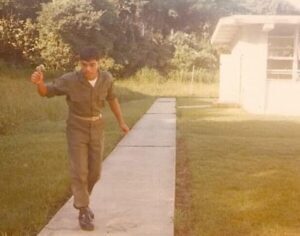 Ray Jubera shortly after his arrival in Okinawa
Ray Jubera shortly after his arrival in OkinawaRay’s first goal upon arrival was to fit into his platoon. Everyone else in the platoon had been together for over three months, so Ray didn’t know anyone and had to earn everyone’s trust. He started by making friends with another Marine from Chicago. His circle of friends grew from there as he spent time training with his unit. That training came to an end in April 1975 when Ray’s company commander told his Marines to pack their gear and prepare to go to war.
The situation was dire, indeed. South Vietnam had been able to hold out against North Vietnamese attacks after the United States ceased military operations in South Vietnam in March 1973. However, by mid-April 1975, the North Vietnamese Army was approaching the outskirts of Saigon and preparing for the final assault. Having waited too long to order an evacuation of the remaining U.S. citizens from South Vietnam and the closure of the U.S. Embassy, the U.S. government began to position Navy ships off the coast to facilitate the rescue of U.S. citizens. Far more challenging was the need to extract South Vietnamese citizens who had been loyal to the United States throughout the Vietnam War. Given the North Vietnamese massacre of thousands of South Vietnamese citizens in Hue during the Tet Offensive in 1968, all South Vietnamese citizens who had assisted the United States faced uncertain futures if left behind. Consequently, they and those Americans they worked for pleaded with the U.S. government to help them escape.
This is where Ray and the rest of Alpha Company entered the picture. Loaded for combat as part of Operation Frequent Wind, they boarded a U.S. Navy ship to help conduct the rescue operation in mid-April. Once they arrived off the coast of South Vietnam, Ray recalls several times embarking helicopters in full combat gear and heading for shore, only to do a U-turn and return to the ship or another ship without action. The ships sailed close enough to shore that Ray could see the beach and even hear mortar rounds blowing up in the sand. Then junks, sampans, and other small boats laden with South Vietnamese refugees started to make their way out to the ships. Not knowing what to expect, Ray and his fellow Marines were posted around the main deck of their ship to provide security in the event something bad transpired when the refugees were brought aboard. Fortunately, all the rescues were peaceful, but Ray had to be ready in case anything happened.
Initially, only a few refugee boats made their way to Ray’s ship. Once they came alongside, they boarded the ship from a ladder with a platform near the water providing access to the main deck. All the refugees, including men, women, and children, were brought aboard, processed, and provided food and shelter. When it became clear ashore the small boats offered a way to reach the Navy ships and the ships were taking refugees onboard, the flow of refugee boats increased exponentially. Each ship took onboard as many refugees as possible, then departed to offload them onto another ship or at the U.S. Navy bases at Subic Bay in the Republic of the Philippines and Guam. Before their ship departed, Ray and Alpha Company would transfer to another ship to provide security so it could take the departing ship’s place in picking up refugees. Ray remembers serving aboard several ships during the rescue operation, including the USS Blue Ridge (LCC-19) and the USS Duluth (LPD-6).
Although Alpha Company’s role in the final chapter of the Vietnam War ended with the conclusion of the evacuation of South Vietnamese refugees, Delta Company of the 1/4 Marines still had a role to play. On May 15, 1975, Delta Company successfully boarded and recaptured the SS Mayaguez after it had been seized by Khmer Rouge forces just three days before. Other Marine and Air Force units simultaneously fought a heated battle with the Khmer Rouge on Koh Tang Island off the coast of Cambodia, withdrawing from the island by the end of the day after sustaining heavy casualties.
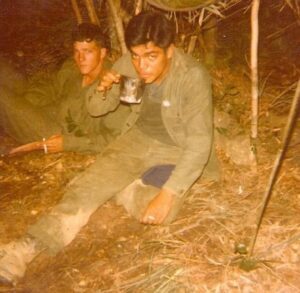 Ray Jubera (drinking coffee) and another Marine taking a brake during an exercise in the Philippine jungle
Ray Jubera (drinking coffee) and another Marine taking a brake during an exercise in the Philippine jungleAfter completing the evacuation operations, Ray and Alpha Company were transported by ship to Subic Bay. They trained at the Marine Amphibious Unit (MAU) Camp known as Upper MAU, where they learned and practiced jungle warfare tactics. This included conducting patrols in the jungle with all their gear, participating in exercises where they had to successfully navigate between points on a map, and engaging in exercises with other units playing roles as adversary forces.
One day as Ray was waiting in line at the Upper Mau chow hall, a Marine attached to an aviation unit exited the facility and saw Ray waiting in line. After seeing Ray’s name tag, he went back inside and re-emerged a few moments later with Ray’s brother, Ruben! It was an emotional reunion as Ray hadn’t seen his brother in two years. After they embraced and got over their astonishment at having run into one another, Ruben told Ray he had a plan. He told Ray to put in a request to his company commander for a three-day pass, explaining he had just run into his brother. Ruben would do the same thing. Ray did as instructed and unbelievably, Ray’s company commander approved the request even though Alpha Company was still technically on standby in the event they were needed again for events in Vietnam. The brothers spent three days in Manila and had the time of their lives, with both returning to their respective units rejuvenated.
After completing their initial jungle warfare training, Alpha Company’s commander informed the company they would be embarking a ship to go on a cruise. He told them there were two kinds of cruises, “training floats” where the unit trained at various places throughout the cruise, and “liberty floats” where the ship visited various foreign ports and the Marines got to enjoy liberty ashore. This cruise, he was happy to report, was a liberty float. That meant their sole mission was to serve as goodwill ambassadors for the Marine Corps and the United States ashore. This they did and Ray took full advantage of port visits in Hong Kong, Singapore, Taiwan, and Malaysia. He especially enjoyed touring the countries and learning as much as he could about their people, culture, and food during their seven-day visits to each location.
Alpha Company returned to Subic Bay and Upper Mau at the conclusion of the liberty float to continue their jungle warfare training. Then around September 1975, the unit returned to Okinawa to formally end its deployment. At this point, many Alpha Company personnel, including the commanding officer, reached the end of their tours and transferred to other units. Ray’s orders ran through January 1976, which now worked to his advantage through another coincidence with his brother.
Learning Ray was back in Okinawa, Ruben reached out to him and suggested another meeting because he was now at the Marine Corps Air Station in Iwakuni, Japan. He again told Ray to put in a request to his company commander for a three-day pass, explaining Ruben was in Iwakuni and this would be the last time they would be able to see one another since Ruben was getting ready to transfer back to the United States. Ray’s new company commander approved the request, perhaps not aware of Ray’s similar three-day pass in the Philippines. Ruben’s commanding officer did the same, and thanks to tickets Ruben was able to obtain, the brothers attended Expo ’75, a World’s Fair that just happened to be occurring on Okinawa during the second half of 1975.
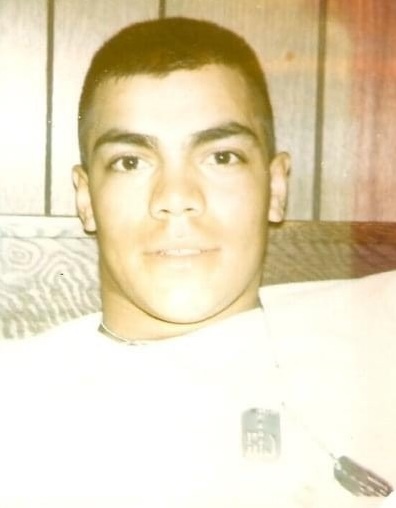 Ray Jubera relaxing at Camp Pendleton after returning from Okinawa
Ray Jubera relaxing at Camp Pendleton after returning from OkinawaRay’s tour with Alpha Company of the 1/4 Marines came to an end in January 1976. He returned to Camp Pendleton in California and was assigned to a platoon with other Marines who had less than a year of their enlistments left. He served out his remaining time performing guard duty at the armory and at other facilities around the camp requiring heightened security. During this time, some high school buddies he hadn’t seen in three years visited him from Chicago. Ray gave them a tour of the base and they had a great time together, but they simply could not relate to Ray’s decision to become a Marine. Ray, on the other hand, could not imagine his life without his Marine Corps experience. He’d seen and done things other people only dream about and his service gave him discipline and pride. He marveled at how a city boy like him had gotten to play a role in world events like the evacuation of refugees from Vietnam after the fall of Saigon.
Despite loving his time in the Marines, Ray decided not to reenlist because he wanted to return home to his family and friends. Accordingly, he received his honorable discharge from the Marines on September 1, 1976, after two years of dedicated service. By yet another coincidence, Ruben received his honorable discharge on the same day in Millington, Tennessee. At Ruben’s suggestion, Ray flew to Memphis and met up with Ruben. The two then drove to Chicago and rented an apartment together. Ray used his GI Bill to attend school and earn a certificate in law enforcement, while Ruben decided to move to Minnesota to be with their family, which had moved back there after Ray joined the Marines.
Now on his own, Ray accepted a job as a security guard at the Norwegian American Hospital in Chicago. Not only did he work there for thirteen years, but he also met his wife, Rose, there and they have been married forty-three years and counting. Ray eventually left the Norwegian American Hospital in 1991 to work for the Aviation Police at O’Hare International Airport. He stayed there for twenty-seven years, retiring as a lieutenant in June 2018. Ray and Rose are now enjoying retirement together in Chicago, spending time with their three children, eight grandchildren, and three great-grandchildren. Finally, Ray participated in an Honor Flight to visit Washington DC in September 2023 in recognition of his service to our country in the Marine Corps.
Voices to Veterans is proud to salute Private First Class Raymond Jubera for his exemplary service in the Marine Corps. His service took him to the waters off the coast of South Vietnam, where he provided security for U.S. Navy ships helping South Vietnamese refugees escape from the conquering North Vietnamese army. After the Marines, he continued a life of public service through a long career in law enforcement. We thank him for all he has done and wish him fair winds and following seas.
If you enjoyed Ray’s story, please sign up for the Voices to Veterans Spotlight monthly newsletter by clicking here. Once each month, you’ll receive a new written veteran’s story directly in your mailbox. Best of all, it’s free and you can unsubscribe at any time.
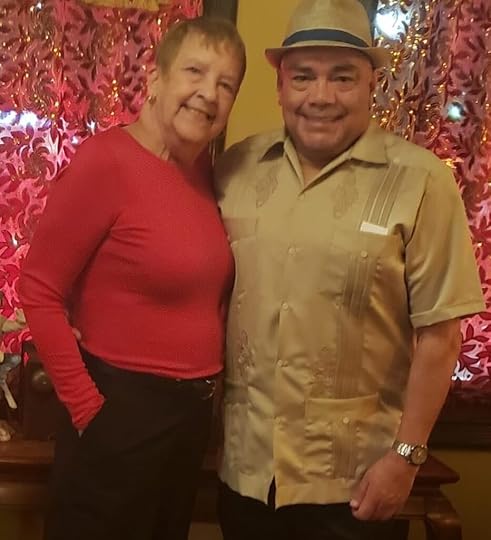 Rose and Ray Jubera
Rose and Ray Jubera The post Private First Class Raymond Jubera, U.S. Marine Corps – A City Boy Helps Make History first appeared on David E. Grogan.
June 19, 2024
Specialist 4 Thomas Steffl, U.S. Army – Drafted for Service in Vietnam
By definition, the draft is disruptive. It yanks people out of their communities and commits them to military service, usually during time of war. Such was the case for Specialist 4 Thomas Steffl, who was drafted for service in the U.S. Army after graduating from college in 1965. His commitment took him to Vietnam, where he maintained communication wires and defended base camps during 1966 and 1967. He then returned to the United States and got his life back on track, working hard to earn a slice of the American dream for his family. This is his story.
Tom was born in 1943 and grew up in and around Echo, Minnesota, located about 125 miles west of Minneapolis. His parents were poor and his dad struggled to keep things together, so they moved around at first until they started sharecropping on land owned by Tom’s uncle. Life was basic, as their farmhouse didn’t have indoor plumbing or even running water until Tom’s sophomore year of high school. Given Tom’s father’s struggles, Tom and his brother played an oversized role in keeping their farm afloat.
When Tom wasn’t working on the farm, he attended school. He transferred to Echo High School during his freshman year, where he played football and basketball and ran track, but his favorite sport was basketball. Although the school was tiny and the basketball playoffs at the end of the season were not divided by the size of the school, Echo High School put together a strong team which made a run deep into the state tournament. The experience added excitement to Tom’s small-town life.
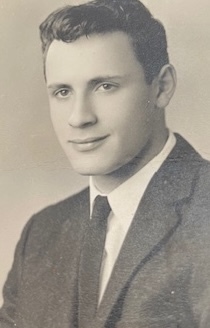 Tom Steffl’s graduation photo from Echo High School
Tom Steffl’s graduation photo from Echo High SchoolTom graduated from Echo High School in May 1961, finishing tenth in a class of twenty-two seniors. In the fall, he enrolled in Minnesota State University at Mankato, where he studied business administration. He worked his way through college because that was the only way he could afford to attend. As graduation neared in 1965, some of Tom’s friends decided to take a trip to sign up for the Minnesota National Guard, which would protect them from the draft. For some reason that escapes him now, Tom declined to go. It was a decision he would soon regret.
Tom graduated from Minnesota State University at Mankato in May 1965 and received his draft notice soon thereafter. As directed, he reported to the Armed Forces Examination and Entrance Station in the Federal Building in downtown Minneapolis for his final physical and entrance processing. Although he had a college degree, he was drafted into the Army’s enlisted ranks, swearing an oath to support and defend the Constitution on October 20, 1965. He spent that night in a hotel with another draftee and they departed the next morning by train to begin their Army training.
On October 21, 1965, Tom and the other draftee arrived at Fort Leonard Wood, located about 140 miles southwest of St. Louis, Missouri. Tom soon realized he was older than all the other draftees because he had completed four years of college. The drill sergeants noticed too, making him the platoon’s recruit sergeant after his predecessor lost their confidence and the respect of the other recruits. This meant Tom had to march the platoon from event to event during the training day, perform various administrative functions, and make sure all the trainees in his platoon were where they needed to be when they needed to be there.
In addition to his leadership responsibilities, Tom had to participate in the recruit training just like everyone else. He excelled at the physical training because he’d kept himself in good shape after high school and college. He also enjoyed the rifle training with the M14, having been an avid hunter growing up. What he did not enjoy was “KP” (kitchen police), which he occasionally had to work in the wee hours of the morning. Already sleep deprived from the grueling training schedule, Tom found KP duty could sometimes test his limits. He discovered this when someone cut in the chow line and Tom put him in his place after losing his temper. All in all, though, Tom felt like the extra four years he had on the other draftees made it easier for him to handle the yelling and the pressure, so he made it through Basic Training with relative ease.
After graduating from Basic Training, Tom rolled directly into Advanced Individual Training (AIT), which was also at Fort Leonard Wood. There he earned his qualifications for his Military Occupational Specialty, or “MOS”, as a field wireman. This meant he would be responsible for installing, maintaining, and repairing communications wires and equipment wherever the Army assigned him. Tom found this ironic because he was afraid of heights and his new job required him to climb telephone poles. In fact, one of his tests required him to scale a telephone pole wearing cleats that he dug into the side of the pole as he climbed. When he reached the top, he had to strap himself onto the pole so he could safely work on the wires. Once strapped in, his instructors wanted him to catch and throw a basketball, which he refused to do, believing he’d already proved he could work on the poles. His instructors agreed and gave him a passing score on the test.
Near the end of AIT, a sergeant formed up the thirty-six members of Tom’s AIT training platoon and announced five members would be going to Vietnam and the rest would be going to Germany. He started calling out the names of the five going to Vietnam in alphabetical order, which gave Tom some comfort as he thought the sergeant would have five names before he made it to the s’s. He was wrong, and soon he heard the sergeant call his name. He was on his way to Vietnam.
Tom’s route to Vietnam took him from Fort Leonard Wood to McChord Air Force Base near Tacoma, Washington, where he stopped to await his follow-on flight. While there, he witnessed the caskets of soldiers killed in Vietnam being unloaded from an airplane. The sight was both scary and emotional, and brought home to Tom the distinct possibility he might not make it back to the United States alive. For the first time, he started to mentally prepare himself for the possibility.
In May 1966, Tom boarded a flight at McChord Air Force Base, which took him and other replacement soldiers to Saigon. His first observations were the heat waves rising off everything in the baking sun, the unique sweet smell in the air, and helicopters buzzing around from place to place. Since he was a replacement soldier filling in wherever the Army needed him, he didn’t know where he was going at first. As he waited for his assignment, he went to church. Afterwards, he learned he was being sent to Nha Trang, but that soon changed to the base camp at Cu Chi, located about twenty-five miles northwest of Saigon.
To get to the Cu Chi base camp, which was the headquarters for the 25th Infantry Division, Tom loaded on a helicopter together with his gear and prepared for the ride. The crew chief instructed him to sit on his helmet in case a stray bullet came their way. They took off, flying just over the treetops and landed safely in Cu Chi. Tom checked in with his unit and learned from the others who had been there for a while that the area had been quiet. He also learned they had work for him right away, so he dove right in, hanging wires on poles. As he did, a mortar round came in and hit the compound. He quickly got down from the pole and went into a bunker for shelter.
Once it was safe, Tom headed to a latrine capable of accommodating two people. He sat next to a big guy who recognized him as someone new. The veteran soldier asked Tom where he was from. After hearing Tom’s answer, he promised Tom his time in Vietnam would go by quickly and that he would be okay. Tom appreciated the reassurance and asked who the older soldier was. It turns out, he was Tom’s commanding officer. Tom never forgot his commanding officer’s kindness and appreciated him taking the time to calm the nerves of the unit’s newest arrival.
During Tom’s time at Cu Chi, he did more than just work with communications wires. He soon took over responsibility for the movie projector, showing movies for the soldiers to watch each week. This only lasted a couple of months, though, because he was replaced when the projector kept breaking down. His successor, and his predecessor for that matter, fared no better as the reason for the breakdowns was not operator error. Instead, it was just that the equipment was old and in need of replacement. Until that happened, projector operators would continue to be appointed and replaced.
As with the other junior enlisted soldiers at the base camp, Tom spent a lot of time filling sandbags. Once filled, the sandbags were stacked around the barracks and other buildings to absorb any shrapnel from enemy rocket or mortar attacks. Another responsibility Tom took very seriously involved standing duty and receiving target coordinates over the radio from units in the field asking for artillery support. He would carefully write down the coordinates so they could be relayed to an artillery unit, which would use them to fire at the target. The job required attention to detail because U.S. and allied units might be very close to the enemy units being targeted. A small mistake in recording the coordinates could result in significant friendly casualties.
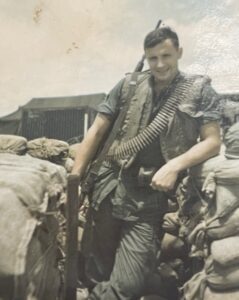 Specialist 4 Tom Steffl in Vietnam
Specialist 4 Tom Steffl in VietnamTom also stood guard duty to ensure the Viet Cong did not penetrate the perimeter of the base. Normally, this meant manning a post on the base perimeter. Out in front of the post was a machine gun, which Tom could use to repel any would be attacker. Behind him was a bunker where he could take cover in the event of a rocket or mortar attack or get some rest when the other soldier with him manned the machine gun.
Not all the danger Tom faced came from the enemy. On one occasion, Tom was assisting a mortar crew. When the mortarman dropped the round into the tube, instead of launching at high speed toward the enemy, if flopped out of the tube and landed about three feet away. Everyone scrambled to clear the area, fearing it would detonate. Fortunately, the round turned out to be a dud.
On another occasion, the base camp wasn’t so lucky. Something set off a Claymore mine, killing a soldier. Shrapnel from the explosion pierced the top of the tent where Tom was at the time, but no one inside was injured. Tom went outside after the blast and saw the soldier who had been killed being carried away on a stretcher. The incident reminded Tom he could be killed at any moment even though he wasn’t outside the wire patrolling in the jungle.
About midway through Tom’s tour, he promoted to specialist (E-4) and transferred from Cu Chi to the Army airfield at An Khe, known as Camp Radcliff. The camp was located about 330 miles northeast of Saigon and close to the coast. Although off-duty soldiers were permitted to go into An Khe, Tom preferred to stay in the camp because he didn’t want to take any unnecessary chances. He preferred instead to enjoy a beer or two in his tent and play pinocle with the other soldiers who were counting down the days until their departure.
Tom had good reason to be concerned about straying away from the safety of the base. One day he witnessed U.S. aircraft dropping napalm in the jungle nearby, while enemy rocket propelled grenades hit the base. Although the engagement was over almost as soon as it started, it helped convince Tom of the wisdom of playing pinochle with his friends.
While at An Khe, Tom promoted to sergeant (E-5). He was upset, however, that one of the soldiers who worked for him did not promote, so he took matters into his own hands and promoted him. This did not sit well with Tom’s commanding officer, who not only removed the soldier’s unauthorized promotion, but also busted Tom back to specialist (E-4). It was a lesson Tom would not forget.
Tom eventually earned three days of R&R (rest and relaxation) in Vung Tau, a city located about 100 miles southeast of Saigon on the coast of the South China Sea. The great food and drink and the pristine beaches provided Tom with a welcome diversion from the war. After three days, he returned to his unit and his normal duties.
Toward the very end of Tom’s tour, he was transferred south to the vicinity of Black Virgin Mountain in Tay Ninh, located about fifty miles northwest of Saigon near Vietnam’s border with Cambodia. The mountain had a Marine communications facility located at the top, but the Viet Cong controlled the mountain’s slopes and the surrounding countryside. Tom’s unit was located with U.S. artillery components at the base camp.
With many Viet Cong operating around Tay Ninh, guarding the base camp perimeter at night was scary and it was easy to get spooked. Every sound coming from the jungle sent shivers down Tom’s spine because the noises sounded like Viet Cong guerrillas sneaking up to infiltrate the camp. Reports that the Viet Cong were preparing to attack the base camp put Tom and everyone else even more on edge. At one point, the warnings of an impending attack became so strong that Tom and the other soldiers were ordered to dig protective foxholes around the camp perimeter. The event stands out for Tom not only because of the fear of a possible Viet Cong attack, but also because he was repeatedly bitten by red ants as he dug his foxhole.
So he would be able to reload quickly when the attack came, Tom set out the magazines for his M16 in his foxhole. In the middle of the night, a soldier somewhere on the perimeter fired his weapon and Tom and the rest of the camp opened fire at the phantom foe lurking somewhere in the black jungle. After about three minutes, all was quiet. Tom was then instructed to go out into the jungle with two men from the communications team to set up a listening post. They ran a communications wire about twenty-five yards outside the camp and called in once they were all set up. Much to Tom’s relief, they were told to come back inside the camp perimeter. A few days later, Tom joined other soldiers on a patrol outside the wire. They set fire to a cache of rice they believed belonged to the Viet Cong before returning to the base camp.
About ten days prior to Tom’s scheduled departure from Vietnam, the artillery units at the camp helped repel an attack on their position by blasting the woods around them. The fight lasted fifteen minutes and Tom saw some of the casualties. Upset he was in such a precarious position days before he was scheduled to go home, Tom convinced his sergeant to allow him to join a convoy to Cu Chi that had just left the compound. The sergeant jumped into a jeep and told Tom and two others to hop in and they sped off to catch the convoy. Along the way they had to veer around an unexploded mortar round in the road and, once they caught up to the convoy, stop to change a flat tire. Although it was a nerve-racking ride, they made it to the base camp at Cu Chi safely. Now all Tom had to do was wait out his last few days for his flight back to the United States.
Waiting proved harder than it seemed, especially when some of Tom’s buddies suggested they grab a few drinks and head over to the nurses’ quarters to meet some nurses. The MP’s caught them, and Tom found himself standing at attention in front of his captain having to answer for his actions. He told Tom he wasn’t going to do anything formal because Tom was so close to going home. He did, however, direct Tom to go back to his tent and stay out of trouble until his departure.
Vietnam had one last send off for Tom before he departed in May 1967. The night before he left for Saigon, the base camp was hit by mortars. Tom jumped into a bunker and hoped he wouldn’t get hit just as he was getting ready to leave. He made it, and the next day, he caught his flight back to the United States.
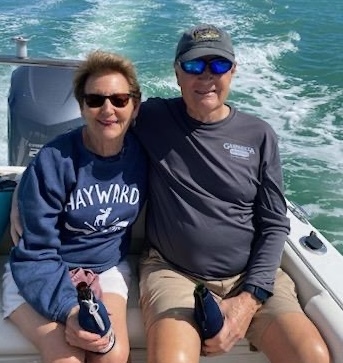 Tom and Cindy Steffl
Tom and Cindy StefflOnce onboard the flight, the pilot welcomed everyone and instructed them to pull their shades down. He also told them there were plenty of sandwiches, beer, and sodas to enjoy on the way home. As the flight approached the coast of the United States, Tom opened his shade and saw the U.S. coastline. He still feels strong emotions when he thinks about that moment today.
Tom spent the last six months of his obligated service working for a Sergeant Major at Fort Benning, Georgia. The Sergeant Major tried to convince Tom to reenlist, but Tom wanted to get out. He did just that, receiving his honorable discharge on October 19, 1967. His first order of business was to return to Minnesota, where he went to work as an accountant for a few months with two computer companies. He also met a young woman, Cindy, at a party, and they were married. Afterwards, Tom started selling insurance, eventually launching his own company after gaining ten years of insurance experience at the corporate level.
Tom and Cindy are now semi-retired and love spending time with their family. They have one son, Christopher, who runs the family’s insurance business, daughter-in-law Tanya, and two grandchildren. Tom still stays plugged into the family business because he really enjoys the work, but he’s content to let his son have the reins.
Voices to Veterans is proud to salute Specialist 4 Thomas Steffl for his two years of wartime service in the Army. He answered our nation’s call as the Vietnam War escalated and served in harm’s way. He then returned to the United States, raised a family, and started a successful career, epitomizing the citizen soldier. We thank him for his service and wish him fair winds and following seas.
If you enjoyed Tom’s story, please sign up for the Voices to Veterans Spotlight monthly newsletter by clicking here. Once each month, you’ll receive a new written veteran’s story and a new podcast directly in your mailbox. Best of all, it’s free and you can unsubscribe at any time.
The post Specialist 4 Thomas Steffl, U.S. Army – Drafted for Service in Vietnam first appeared on David E. Grogan.
May 15, 2024
Master Sergeant Mark Zulawski, U.S. Marine Corps (Retired) – I Gave It My All
Some people expect instant success in life without first laying the necessary groundwork. However, success is often an iterative process, as we try new paths and approaches, all the time refining our skills. Master Sergeant Mark Zulawski, U.S. Marine Corps (Retired), spent ten of his almost twenty-one years in the Marine Corps learning the warfare, personal, and leadership skills necessary to make him a successful recruiter and senior enlisted leader. During the course of his career, he deployed twice, helped develop the Marine’s mechanized infantry capability, and most of all, recruited countless new Marines into the Corps. This is his story.
Mark was born in Buffalo, New York, in September 1957 but his family later moved to what was then farmland in the town of Cheektowaga, now an inner-ring suburb of Buffalo. His father was a Korean War Army veteran and a butcher by trade. His mother was primarily a stay-at-home mom for Mark and his older sister and younger brother, although she did work part-time in the deli section of a nearby Save-on-Meats grocery store.
Mark attended West Seneca East Senior High School in West Seneca, New York. He played football all four years, starting as a fullback on the varsity team beginning with the second half of the first game during his sophomore year and continuing until he graduated. In recognition of his leadership on and off the field, he was named captain during his senior year. He also tried playing baseball, but his role was limited to designated runner because his speed allowed him to steal bases and score. Where his speed really mattered was on the varsity track team, where he ran the 220-yard dash and anchored the 880-yard relay team. He was the fastest runner on the team in both races, despite being unable to practice with the team because once he turned sixteen, he worked in the meat section of the same Save-on-Meats grocery store where his mother worked. Instead, he ran on his own after work and on weekends but asked his boss for time off to run in the meets.
As with all high school seniors, Mark had to decide what he wanted to do after graduation. He initially planned on attending and playing football for Upper Iowa University. However, when he visited the university, the football coach said he was not eligible for a scholarship during his freshman year and would have to prove his worth to the team before being considered.
About this same time, a Marine Corps recruiter called and asked if Mark had received the information he had sent him. Mark said he had and that he was interested in speaking with him. The recruiter followed up and they met at the recruiter’s office. Mark told him about his Upper Iowa University visit, including a part about having a few beers while there and getting sick afterwards. The recruiter leveled with Mark and said he would have a tough time making it in college because he didn’t have self-discipline. He promised if Mark joined the Marines, he would develop the self-discipline he needed.
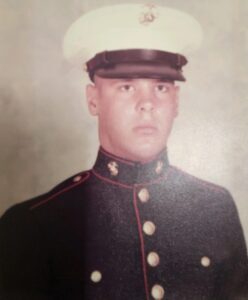 Mark Zulawski at boot camp
Mark Zulawski at boot campThat was the message Mark needed to hear and he decided to enlist in the Marines in April 1976, two months before graduation. He enlisted in the Delayed Entry Program, which permitted him to choose a start date after he graduated from high school. To formalize the arrangement, Mark reported to the Buffalo Military Entrance Processing Station (MEPS). There, after signing the enlistment paperwork, he passed an initial physical and took the oath of enlistment. He then finished the school year at West Seneca East High School, graduating in June 1976.
Mark returned to the Buffalo MEPS in September 1976 when it came time for him to report for active duty. After passing another physical to make sure he was still fit for duty, he and the other Marine recruits reporting with him took a flight from Buffalo to South Carolina, enroute to the Marine Corps Recruit Depot at Parris Island for boot camp. Once Mark arrived, he and the other new recruits marched to a Quonset hut to begin in-processing. This included getting yet another physical, receiving his uniforms, getting a haircut, and being assigned to Platoon 296. The drill instructors also introduced themselves to the new recruits, making it clear the first words out of their mouths for the next twelve weeks were to be “Yes, sir,” and “No, sir”. But the real fun did not begin until they completed two days of in-processing. Then, “all hell broke loose.”
Perhaps because he knew boot camp was what he needed and because he had prepared beforehand by running and lifting weights, Mark liked boot camp. It paralleled football practice in many ways, requiring him to do his best in every drill from the moment he woke up until the time he closed his eyes at night to sleep. And no matter how good his best was, the drill instructors demanded more.
One place where the strict boot camp rules were relaxed ever so slightly was the chow hall. There the recruits could chat quietly with the recruit sitting directly across from them, but no one else. Taking advantage of this, Mark always sat across from his best friend, Frank Labordie, so they could catch up during their meals. One day, they made the mistake of continuing their conversation as they were returning their food trays to the dishwashing area and one of the drill instructors, Staff Sergeant Lambert, heard them. After berating them both, he told them to remind him of their offense later so he could deal with it appropriately, promising to “bend and thrust them to death.”
Believing Staff Sergeant Lambert would forget, Mark and his friend said nothing about the infraction and laid low. The approach seemed to work until they were preparing for a footlocker inspection by the platoon gunnery sergeant (“Gunny”). All of a sudden, they were summoned to the quarterdeck ASAP. Both men ran as fast as they could to the quarterdeck, but when they arrived, they were told they had not come fast enough and to go back and do it again. This repeated itself several times until Staff Sergeant Lambert was satisfied. Mark and Frank then had to face each other and say they hated each other, and were told when they saw each other, to run away. Finally, they had to do bend and thrusts until they were exhausted.
With their infraction paid for, Mark and Frank returned for the footlocker inspection. Mark knew he was doomed because the morning events had left him insufficient time to prepare. When the Gunny reached Mark’s footlocker, Mark was still dripping sweat from his runs to and from the quarterdeck and the bend and thrusts. The Gunny looked at Mark’s footlocker and, finding it not up to Marine Corps standards, dumped the upper tray onto the floor. At this point, Mark’s only thought was “what the hell have I gotten myself into.”
Mark soon got over the event and excelled at boot camp. He also really admired Staff Sergeant Lambert, who he believed was doing his best to make them all outstanding Marines. Mark also believed Staff Sergeant Lambert picked on the recruits he liked to help drive them to their full potential, so he didn’t mind Staff Sergeant Lambert’s attention even though it might be unpleasant at times. Other recruits had more difficulty adjusting to the training, with a couple dropping out and a couple more even trying to escape Parris Island.
One aspect of boot camp Mark particularly excelled at was the physical conditioning, which helped him get into the best shape of his life. For the physical fitness test (PFT), he did 80 sit-ups in under 2 minutes, 20 dead-hang pullups, and ran 3 miles in 18:20, scoring 298 out of a possible 300 points (a perfect score required running the 3-mile course in 18:00 or under). He would achieve this score on the PFT every time he took it for the rest of his career.
After the initial “breakdown” phase of bootcamp, the training shifted to the rifle range for two weeks. By the end of rifle range phase, Mark and his fellow recruits could put an M16 round through a six-inch circle at both 200 and 300 yards. At 500 yards, they could consistently hit a target the size of a milk can. Once the recruits completed their weapons training, they moved on to the final phase of boot camp, where they were given some privileges like being able to grow their hair a little on top and blouse their trousers. Although these privileges were small, they helped Mark and the other recruits see the light at the end of the boot camp tunnel.
Graduation finally came on December 21, 1976, and Mark was officially designated a Marine. He had done exceptionally well, always giving 110% at everything he did. His drill instructors recognized this, making him a squad leader while he was there. Frank Labordie had also done well, being named the platoon’s honor graduate. All that was behind them now, though, as they prepared to head to their first assignment.
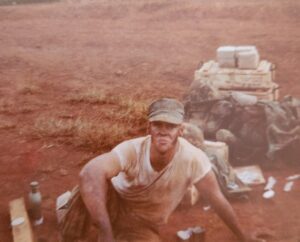 Mark Zulawski in the field in Hawaii
Mark Zulawski in the field in HawaiiMark’s initial assignment was with the 1st Battalion, 8th Marines (1/8 Marines), located at Camp Geiger, a satellite facility of the Marine Corps Base Camp LeJeune complex in North Carolina. Before he reported for duty, he had ten days leave to spend with his family in Buffalo. His father, who was not pleased when Mark announced he was enlisting in the Marines, beamed when Mark showed up all spit-and-polished in his Marine Corps uniform. So did his high school sweetheart, Doreen Czajka, whom he had known since fifth grade and been dating since his freshman year. After the leave passed by much too quickly, Mark said his goodbyes and departed for Camp Geiger toward the end of January.
Now a private first class (E-2), Mark checked in with the 1/8 Marines as they were preparing to deploy. This meant nonstop training, including a series of forced marches, each one longer than the one before. Mark excelled at all these activities and was selected as the Marine of the Month for March 1977. By April, the battalion had progressed from ten-mile marches to a twenty-five-mile march during the course of a single day. After the twenty-five-mile march, Mark’s Company Gunny asked him if he’d like to go to Hawaii. The only issue was the orders would have a short turnaround time, so he would have to depart soon. That sounded like an opportunity Mark couldn’t refuse, so he agreed to transfer to Hawaii.
Mark arrived in Hawaii in June 1977 and reported to his new command, the 1st Battalion, 3rd Marines (1/3 Marines), located at Marine Corps Air Station (MCAS) Kaneohe Bay on Oahu. Although a mortarman by training, he was assigned to the Headquarters and Services (H&S) Company, which provided administrative and logistical support for the other companies in the battalion. He also promoted to lance corporal (E-3) as a result of his previous selection as Marine of the Month at the 1/8 Marines at Camp Geiger.
Just as had been the case with the 1/8 Marines, the 1/3 Marines were preparing for an upcoming deployment as a Battalion Landing Team (BLT). This meant the battalion would deploy aboard Navy ships to be ready to go ashore in response to contingencies anywhere in the western Pacific (WestPac) in support of U.S. interests. Should no contingencies arise, the battalion would train with U.S. partners and allies in the region.
As the time for the March 1978 deployment neared, Mark learned no one could take leave in the thirty days leading up to the deployment. This was a problem because he and Doreen had already scheduled their wedding for February 18, 1978, and all the arrangements had been made. Mark went to his company Gunny and explained the situation. The Gunny went to bat for him and he was permitted to return to Buffalo for his wedding and to spend time with his new bride. He then rejoined his battalion in time for its deployment.
Mark and the rest of the H&S Company and their equipment loaded aboard the USS Cleveland (LPD-7) on March 25-27 at Pearl Harbor. Together with the USS San Bernadino (LST-1189), Cleveland set off for WestPac on April 1 after conducting some local operations. About ten days later, the two ships rendezvoused with the USS Tripoli (LPH-10) in the vicinity of Wake Island. Mark’s company and other elements of the BLT then cross-decked over to the USS Tripoli and continued their deployment aboard that ship. The Tripoli subsequently anchored in Subic Bay, allowing Mark some liberty time ashore. It then departed Subic Bay on May 6 for a port visit in Singapore, after which it returned to the Philippines, where the BLT spent the next several months at the Upper MAU (Marine Amphibious Unit) Camp training in the jungle environment around Subic Bay.
Prior to the deployment, Mark had been moved to the H&S Company armory, where he was responsible for checking weapons in and out, making sure they were cleaned, and addressing any weapons needing repair. He performed this function during the deployment, too, because the Marines in the company spent time at sea taking care of their weapons and used them while ashore during training and exercises. When at sea, Mark and his fellow Marines also spent time in the classroom, studying unit tactics and catching up on other required training.
The BLT leadership team took notice of Mark’s strong performance during the deployment and summoned him and other high achieving Lance Corporals to a meritorious promotion board. One at a time, Mark and the others had to appear before a board consisting of the Battalion Executive Officer (a major), company commanders (captains), and first sergeants (E-8s). They asked them questions about Marine Corps general orders, their military occupational specialty (MOS), and various other subjects. They obviously liked Mark’s answers because they meritoriously promoted him to Corporal (E-4).
 Mark Zulawski’s first reenlistment joined by Doreen and new son Mark Jr.
Mark Zulawski’s first reenlistment joined by Doreen and new son Mark Jr.When it came time to leave the Philippines, Mark and his company boarded the USS New Orleans (LPH-11) for the return trip to Hawaii. The New Orleans arrived in Pearl Harbor at the end of September 1978, bringing Mark’s deployment to an end. His first order of business upon return was to find and furnish an apartment so Doreen could join him, which she did after about a month. They lived in Kailua on Oahu’s east coast, not far from MCAS Kaneohe Bay. They stayed there for about nine months until they progressed to the top of the wait list for base housing and then moved on base for the rest of their tour. Living on base was especially convenient because it was expensive to live out in town, the on-base commissary and exchange made shopping easy, and Doreen was able to get a job with a branch of the Bank of Hawaii located right on base.
Soon after Mark and Doreen moved on base, it came time for Mark to deploy again. This time was particularly difficult because Doreen was pregnant, making it hard to say goodbye. Even worse, due to several unexpected delays, Mark said goodbye only to return in a day or so and then had to say goodbye again when the cause of the delays was rectified. This time, Mark’s company deployed on the USS Duluth (LPD-6), which departed Pearl Harbor in early August 1979.
Mark got to see much more of WestPac on this cruise, with the Duluth making stops for port calls or exercises in Okinawa (Japan), Subic Bay (Philippines), Sydney (Australia), New Caledonia, Fiji, and Hong Kong. The most memorable event during the deployment occurred in Philippines, when Mark was playing rugby as a member of the battalion rugby team. The team had arranged for a game against a team of New Zealanders, and they were practicing in advance of the game on a helicopter landing zone on a hill because it offered a large level area. At one point, the rugby ball sailed into the trees adjacent to the field and Mark ran in after it. What he did not realize was just inside the trees was a cliff and he ran right over the edge, plummeting down through the trees thirty to forty feet before hitting the ground. He woke up in the back of a Gamma Goat (an off-road semi-amphibious vehicle) on his way to the hospital. Once there, the battalion commander visited him to see how he was doing. Miraculously, his only injuries were some sore ribs and he was otherwise okay.
Just as he had done during his first deployment, Mark excelled in all his duties and the battalion’s leadership took notice. Again he appeared before a promotion board and was meritoriously selected for sergeant (E-5). He was then moved to the battalion’s armory to supervise three qualified armorers because he had the experience and leadership skills the battalion was looking for, even if he didn’t have the small arms repairer/technician MOS.
The deployment was tough for Mark because he wanted to communicate with Doreen to hear how she was doing. At the time, however, the only ways to communicate were by letter, which took a long time, or telephone, which was very expensive. Occasionally, he could make a call via AUTOVAN, which was a military phone system that would allow him to speak with a base operator in Hawaii, who could then patch him through to his wife. Because AUTOVON calls could cut off at any time, Mark always began his calls with “I love you” and “Goodbye”. He and Doreen would then talk for as long as the connection would allow. Most of the time, though, he had to save up his money to make a call at a place in the Philippines that charged a flat rate of twenty dollars for a call.
As the deployment wound down, Doreen’s due date drew near. Rather than require Mark to sail back on the ship, the BLT designated him as part of the advance team to return to MCAS Kaneohe Bay two weeks early to prepare for the BLT’s return. Mark then flew back from the Philippines, arriving a day and a half before Doreen gave birth to their first son, Mark Jr. He also got to spend more time with his new family because now that he had deployed twice within a single tour, he was considered no longer deployable. Accordingly, he was shifted to the 2nd Battalion, 3rd Marines (2/3 Marines), where he began to train on the new M224 60mm mortar.
Mark didn’t spend much time with the 2/3 Marines because by the end of 1980, it was time to reenlist and transfer to a new duty station. In return for reenlisting, he was given orders for Inspector and Instructor (I&I) duty with the 3rd Battalion, 25th Marines (3/25 Marines) in Buffalo at the Marine Corps Reserve Center. The 3/25 Marines was a Reserve battalion, so its members drilled one weekend each month and two weeks out of every year. Mark, however, was part of a cadre of active duty Marines assigned to the unit who worked full time, providing training and administrative and logistical support to the Reserve unit.
Mark, Doreen, and Mark Jr. departed Hawaii on January 1, 1981, and checked in with India Company of the 3/25 Marines in February. Mark’s primary responsibilities were in the armory preparing the company for embarkation when it came time to deploy, but he also assisted with administrative work and reenlisting prior service Marines into the unit.
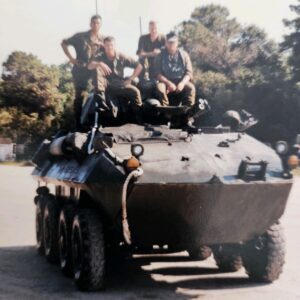 Mark Zulawski (front left) and his team on a Light Armored Vehicle (LAV)
Mark Zulawski (front left) and his team on a Light Armored Vehicle (LAV)Overall, Mark enjoyed I&I duty. The active duty staff typically worked Monday through Thursday and took a half-day off on Fridays as compensation for having to work all weekend during drill weekends. They also had a competitive bowling league on Thursday, which helped keep morale and camaraderie high. The tour was, however, marred by a personal tragedy. Mark and Doreen lost their second baby after a he contracted a blood virus, making an emergency C-section necessary two months before his due date. He survived only eighteen hours.
In October 1983, it came time for Mark to transfer again after having promoted to staff sergeant (E-6). This time he reported to Fox Company of the 2nd Battalion, 6th Marines (2/6 Marines) at Camp Lejeune, North Carolina. He got the job after the first sergeant he worked for on I&I duty in Buffalo transferred to the 2/6 Marines as the new Sergeant Major and made a by-name request for Mark. He reported to the unit just after the 2/6 Marines returned from Beirut, Lebanon, having filled in behind the Marines killed during the terrorist attack on the Marine Barracks in Beirut on October 23, 1983.
Mark’s job in Fox Company was infantry platoon sergeant. As he was a mortarman, he had to learn his new responsibilities though on the job training. He also learned Doreen was pregnant again, which made both him and Doreen nervous after the loss of their second baby. Adding to the stress, the battalion was getting ready to deploy again. Knowing about Mark’s second baby, the battalion’s Sergeant Major stepped in and arranged for Mark to be exempted from the deployment so he would be home when it came time for Doreen to give birth. Instead of deploying, Mark served as an instructor at the Non-Commissioned Officer (NCO) Academy for six months, teaching new corporals about leadership, infantry tactics, navigation, and other important topics. Mark and Doreen’s second son, Derek, was born in 1984 while they were at Camp Lejeune.
A unique opportunity presented itself as a follow-on assignment after the NCO Academy. The Marine Corps was developing a new mechanized infantry unit around the similarly new Light Armored Vehicle (LAV). The LAV was an eight-wheeled armored reconnaissance vehicle mounting a 25mm chain gun in a turret. It could carry six Marines in addition to its crew of three and could operate on all sorts of terrain, including through streams and rivers. Mark got the call to be part of the new unit, which required him to train on the vehicles for two months at Camp Pendleton in California.
After completing the training, Mark reported to his new assignment as the platoon sergeant for Charlie Company of the 2nd LAV Battalion at Camp Lejeune. The unit was so new, the company did not have any LAVs assigned when Mark reported. Eventually, the LAVs arrived, as did a cadre of Marines just out of boot camp to learn how to operate with them.
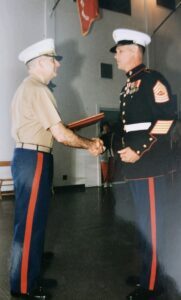 Master Sergeant Mark Zulawski (right) at his retirement ceremony
Master Sergeant Mark Zulawski (right) at his retirement ceremonyMark’s platoon had four LAVs, each manned by a driver and a turret gunner. Mark was the third crewmember in his LAV and the platoon’s lieutenant would be added to one of the others except the platoon didn’t have a lieutenant yet. In fact, Mark served as the platoon commander until a lieutenant arrived three to five months later. Mark particularly enjoyed working with the new Marines out of boot camp because they were excited about being there and didn’t yet have any bad habits he’d have to teach them to break. They learned to how to fight the vehicles by convoying them to Fort Benning, Georgia, where they practiced tactics on the Army base’s diverse terrain. After six weeks at Fort Benning, Charlie Company returned to Camp Lejeune, ready to employ their new weapons’ capability.
Although it was exciting getting to work with the brand new LAVs, it did have one downside. The battalion’s commander treated them like new cars, insisting they be maintained in a spotless condition, both inside and out, even though they were intended to operate under combat conditions in the field and got dirty. This meant Mark and his platoon had to keep the LAVs in display-ready condition after every use. To ensure this was done, the battalion commander personally conducted inspections, always rolling under the vehicles on a dolly to make sure no dirt or mud lurked on the underside of the vehicles.
In 1986, Mark’s assignment with the 2nd LAV Battalion came to an end. For his follow-on tour, he accepted orders for recruiting duty, having arranged for an assignment in his hometown of Buffalo. First, he needed to complete twelve weeks of Recruiter School in San Diego. Then he moved his growing family to Buffalo where he started an amazing eleven-year recruiting run.
Mark began his assignment working at Recruiting Station Buffalo, where a Gunny he’d worked with during his I&I assignment at the Reserve Center asked for him by name. The Gunny made the right choice, as recruiting turned out to be in Mark’s blood. Deciding from the beginning to always be transparent and truthful with the recruits, their parents, and school officials, he quickly earned everyone’s trust and confidence.
Over the course of his eleven years recruiting in Buffalo, he worked at the main Recruiting Station in Buffalo, as well as the recruiting substations in Olean, Hamburg, Dunkirk, West Seneca, and Warren (Pennsylvania). During different periods over the eleven years, he served not only as a recruiter, but also as a recruiter instructor, the Non-Commissioned Officer in Charge (NCOIC) of the recruiting substations at Buffalo, Olean, and Hamburg, and the Operation Chief for the Buffalo Recruiting Station responsible for processing waivers and planning. He was so successful that he was meritoriously promoted to Gunny Sergeant and later promoted to Master Sergeant (E-8). He earned numerous accolades for meeting or exceeding recruiting mission goals, including NCOIC of the Year, Recruiter of the Month (several times), and Recruiting Substation of the Month (several times).
Although Mark made recruiting look easy, it was not. At times he was up at 4:00 a.m. to get applicants he recruited at Olean to the Buffalo MEPS by their 6:00 a.m. report time. Often, he worked until 8:00 p.m. or 9:00 p.m. meeting with recruits or their parents. He attended job fairs and endured his share of rude behavior, but he always kept his eye on mission accomplishment and gave recruiting his all. He somehow also managed to make time for his family, and Doreen gave birth to their third son, Matthew, in 1987.
Recruiting also proved stressful. Each month, Mark either had to meet personal recruiting quotas or office quotas, depending upon his position at the time. Meeting the quotas required more than just getting a recruit to sign the enlistment paperwork. To count, the prospect had to be a quality recruit, meaning they had to meet or exceed certain criteria and successfully graduate from boot camp. Recruit washouts anywhere along the way had to be made up for, and Mark was evaluated using an established formula on the quality of the recruits he enlisted.
Mark experienced this firsthand with the very first recruit he enlisted. After signing up the recruit and waiting for the recruit’s report date, Mark learned the recruit was burned to death in a car accident. Horrified by tragic death, Mark nonetheless had to work hard to find another recruit to replace the one who was killed because he did not make it successfully through the Delayed Entry Program.
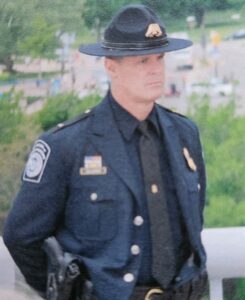 Mark Zulawski with U.S. Customs and Border Protection
Mark Zulawski with U.S. Customs and Border ProtectionIt was the positive stories, however, that kept Mark going. He loved helping young men and women who needed direction and discipline in their lives, or who came from terrible life situations, get on the right path. One prospect Mark recruited at Olean told Mark he had changed his mind and didn’t want to go through with his enlistment. Mark’s commanding officer thought it best to discharge him and find another prospect to make up for the loss. Mark chose instead to talk to the recruit to see what the problem was. He gave the recruit a few extra days to report for active duty, which was all the recruit needed. He went on to be the honor graduate from his boot camp class and qualified for duty at the U.S. Embassy in China.
After completing eleven years of recruiting in Buffalo, as well as twenty years, eight months, and eight days in the Marine Corps overall, Mark retired on June 1, 1997. He initially parleyed his recruiting skills into selling cars at a Ford dealership, but traded that job in for a short stint as the driver for a New York state assemblyman. Not liking that job at all, he applied for and was accepted by the Post Office, serving first as a journeyman filling in for people on vacation or sick leave, and later as a full-time worker at the Central Park Post Office.
Mark worked at the Post Office for three years until a surprise opportunity came his way. When he was still selling cars for the Ford dealership, one of his customers brought him an application for the Custom Service’s Veterans’ Recruitment Appointment Program. Mark applied but heard nothing further and assumed he did not get the job. Two years later when he was working for the Post Office, the Customs Service offered him a position. He accepted and began work on January 2, 2001. After attending Law Enforcement Training in Glencoe, Georgia, he worked for the Customs Service and its successor, U.S. Customs and Border Protection, at the Port of Buffalo for seventeen years. He finally retired with over forty years of distinguished federal service on June 1, 2018, although even then he continued to work parttime until March 2023 helping conduct interviews for new hires.
Today Mark lives with Doreen in Lancaster, New York, spending time with their three sons and five grandchildren and taking care of their two horses and their dog. As he looks back over his life and career, he is sure beyond a doubt that he owes any success he’s had in his life to the Marine Corps. His self-discipline, his leadership skills, and his ability to present information confidently to large groups of people all stem from his time as a Marine. In short, the Marine Corps made him the person he is today.
Voices to Veterans is proud to salute Master Sergeant Mark Zulawski, U.S. Marine Corps (Retired), for his forty years of dedicated federal service. Not only did he deploy whenever and wherever the Marine Corps needed him, but he also changed countless lives by opening the doors to leadership and discipline through service in the Marines. Not stopping there, he continued his life of service with the U.S. Postal Service and U.S. Customs and Border Protection. For all he has done, and for all the sacrifices he and his family have made, we wish him fair winds and following seas.
If you enjoyed Mark’s story, please sign up for the Voices to Veterans Spotlight monthly newsletter by clicking here. Once each month, you’ll receive a new written veteran’s story directly in your mailbox. Best of all, it’s free and you can unsubscribe at any time.
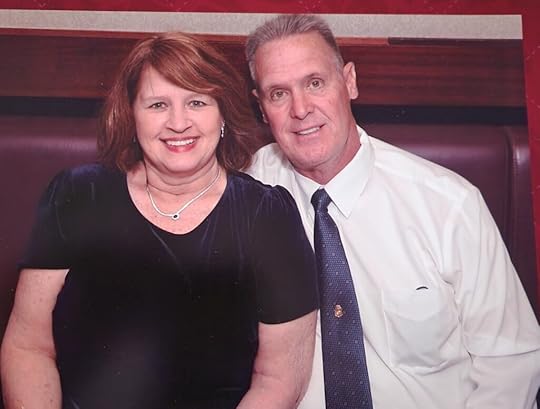 Mark and Doreen Zulawski
Mark and Doreen Zulawski The post Master Sergeant Mark Zulawski, U.S. Marine Corps (Retired) – I Gave It My All first appeared on David E. Grogan.
April 17, 2024
CTT2 Thomas Elling, U.S. Navy – Deploying to Two Theaters as a Navy Cryptologic Technician
The active duty and Selected Reserve Navy consists of almost 394,000 officers and enlisted sailors all doing their part to make the U.S. Navy the most powerful maritime force the world has ever seen. Most of the active and reserve sailors have traditional jobs, manning the ships, submarines, and aircraft that patrol on, under, and above the world’s oceans 24 hours a day, 7 days a week, 365 days a year. Others, like Cryptologic Technician Technical Second Class (CTT2) Thomas Elling, provide niche warfare services critical to the success of the more traditional operating forces. Whether part of the active or reserve forces, they are highly trained, technologically advanced, and must always be ready to fill high-priority billets. Thomas Elling made two critical deployments, providing signals intelligence to U.S. Navy and Special Operations forces, helping project U.S. military power and resolve abroad. This is his story.
Tom was born in 1995 in Smithtown, a small town of about 116,000 people located on the north shore of Long Island, New York. When he was still a toddler, his parents moved to Tonawanda, New York, a suburb of Buffalo. His father was a district manager for the Buffalo News. The paper was a family affair, as Tom’s mother had a Buffalo News paper route, delivering papers to homes early in the morning. Once she completed her route each day, she worked a full-time job at a local hospital. This grueling work schedule allowed Tom’s mom and dad to raise Tom and his two younger sisters in a typical middle-class Buffalo suburban environment.
Tom began his high school studies at St. Joseph’s Collegiate Institute, an all-boys Catholic school in nearby Kenmore, New York. He enjoyed the school because it expanded his horizons beyond Tonawanda by introducing him to boys from all around the area. Halfway through his sophomore year, he transferred to a public school, Kenmore West Senior High School. He played hockey all through his first three years, not only for both his high schools, but also on a traveling team and during the summer on his neighborhood’s streets. He also enjoyed playing guitar and an occasional round of golf, and did everything he could to earn spending money, including working at restaurants as a dishwasher, working in the meat department at a local grocery store and in a department store, and cutting lawns.
Things changed during Tom’s senior year when he began to take classes at Erie Community College in addition to his high school courses. The added course load meant he could no longer play hockey, but it allowed him to graduate from Kenmore West Senior High School a semester early in January 2013. He continued taking classes at Erie Community College during the spring of 2013 and then enrolled at the State University of New York (SUNY) at Fredonia beginning in the fall of 2013. He had a great time at SUNY Fredonia but his grades did not, so at the end of the spring semester the university suggested he try something else for a while.
Knowing his spring semester would be his last, Tom began searching for options. He had always admired President John F. Kennedy, so he considered the Peace Corps and the military. When he asked his mother for advice, she agreed the military was a good option. The guys he lived with at college reinforced this choice as both were Iraq War veterans. They suggested Tom join the Army Reserve so he could earn and take advantage of the GI Bill to pay for his college education whenever that might resume.
The transition from SUNY Fredonia back to Tonawanda proved difficult. Tom’s parents had recently split up, so Tom had nowhere to go. He ended up sleeping on his grandparent’s sofa for the summer as he finalized his plans. In late July or early August 2014, he took the plunge. He initially visited a Marine recruiter and then an Army recruiter, but quickly recognized those were not the services for him. His next stop was a Navy recruiter and they clicked. Tom had also been in touch with a high school friend who’d joined the Navy and become a Cryptologic Technician (CT), which sounded interesting to Tom. And, because Tom scored high enough on the Armed Services Vocational Aptitude Battery (ASVAB), the Navy recruiter could promise Tom a job as a CT once he completed the necessary training pipeline.
 CTT2 Tom Elling standing in front of the submarine USS Croaker (SSK-246) and the light cruiser USS Little Rock CL-92 (CLG-4) at the Buffalo and Erie Country Naval & Military Park
CTT2 Tom Elling standing in front of the submarine USS Croaker (SSK-246) and the light cruiser USS Little Rock CL-92 (CLG-4) at the Buffalo and Erie Country Naval & Military ParkConvinced he was on the right path, Tom signed up for the Navy Reserves on August 31, 2014. Instead of reporting for duty immediately, though, he enlisted in the Delayed Entry Program, which gave him a start date at the end of March 2015. In the interim, he attended meetings once each month with other recruits in the Delayed Entry Program. At the one-to-two-hour meetings, they heard speakers, did some drills, and learned information to help ease their transition from civilians to sailors at boot camp.
When the end of March 2015 finally arrived, Tom was ready. He reported to the Buffalo Military Entrance Processing Station (MEPS) and took the oath of enlistment, making his commitment to the Navy official. Then, after spending the night at a local hotel with the recruits from all four services awaiting transportation to their initial training, Tom and another Navy recruit boarded a plane at Buffalo International Airport heading for Chicago. From there they went to the Great Lakes Naval Training Center just north of Chicago to begin boot camp.
Tom found boot camp relatively easy. He knew what he had to do and was both physically and mentally prepared for the training. He also wanted to do anything that could help him make rank as fast as possible, so he volunteered for and became his company’s Assistant Recruit Chief Petty Officer (AROC). As the AROC, he was responsible for assisting the Recruit Chief Petty Officer in maintaining the company and for calling the cadence when the company marched from place to place.
The days at boot camp were long but the weeks were short. Tom spent a lot of time mopping floors and doing pushups, as did all the recruits. Overall, though, he found it a positive experience. He got to eat as much as he wanted and wrote letters home once a week, which was more than he expected. On the downside, it was early spring in Chicago, so the weather brought lots of rain and wind and a damp piercing cold unlike what he was used to in Buffalo.
Graduation finally arrived on May 31, 2015, and Tom’s mother and two sisters flew to Chicago to attend the ceremony. Afterwards, Tom headed for his follow-on training, Cryptologic Technician Technical (CTT) “A” school, in Pensacola, Florida. As a CTT, Tom would be responsible for operating systems that collected signals intelligence, controlling systems capable of jamming adversary radars and weapons systems, and providing technical and tactical guidance to U.S. forces based upon signals intelligence. CTT “A” school began Tom’s training in this highly specialized field, focusing mainly on the fundamentals of radar.
Although Tom had to learn a lot of new information at “A” school, including some complex mathematics, going to school in Pensacola had its perks. Most important, once his class qualified for Phase II liberty, they could go off base to explore the city’s restaurants and bars and area beaches. And, unlike the late spring weather in Chicago, Pensacola’s weather remained beautiful for Tom’s entire stay.
Tom graduated from the seventeen-week CTT “A” school in October 2015 and returned to Buffalo for duty. Since he had enlisted in the Navy Reserve rather than the active duty Navy, he reported to the Navy Operational Support Center (NOSC), which provides administrative support to Navy reservists. He began drilling there one weekend each month, but since the NOSC didn’t have anything for CTTs to do, Tom spent the bulk of his time each drill period doing odd jobs like sweeping and maintaining the facility. Finally, after three or four months of marking time, the Defense Intelligence Agency (DIA) saw Tom was available for orders and recruited him for an assignment with an intelligence unit in Rome, New York. That meant traveling to Rome, about 190 miles away, for each month’s drill weekend.
Tom’s assignment at DIA turned out to be similar to his situation at the NOSC because there was nothing for him to do but odd jobs and reviewing PowerPoint presentations. Bored, Tom started to pursue options for obtaining active duty orders so he could put his CTT training into practice. This resulted in him being assigned in 2016 to the next level of CTT training, “C” school. The training, which was also located in Pensacola, took Tom twenty-six weeks to complete. He also promoted to Petty Officer Second Class (E-5), which when combined with his CTT job classification or “rate”, is abbreviated as CTT2.
In October 2016, Tom finally found what he was looking for when he received one-year active duty orders as an individual augmentee to a Joint Special Operations Command (JSOC) located at Fort Bragg, North Carolina. As the JSOC was primarily comprised of reservists from all four services who joined the unit as individual augmentees, the newly formed team trained together for several months before deploying to Djibouti on the Horn of Africa for nine months.
Tom and the rest of the JSOC initially departed for their deployment on a U.S. Navy “rotator” flight originating in Baltimore, Maryland, and eventually arriving in Addis Ababa, Ethiopia. From there they caught an Ethiopian Airlines flight to Djibouti. They set up shop onboard Camp Lemonnier, the only permanent U.S. base located in Africa.
Tom found every aspect of the deployment exotic. From the sights, sounds, and smells of the city, to living in a predominantly Muslim country, to the intense African heat, it was all new and incredibly different from life in the United States. Even the sky was different with thousands of stars visible to the naked eye since there was far less ambient light, their impact made even more discernible when viewed through night vision goggles. When Tom’s team exercised with the Kenyan military and their older equipment like UH-1 Huey helicopters, it was as if they were transported back in time fifty years. In fact, much of Tom’s experience in Djibouti seemed that way, which made it all the more enjoyable.
The living quarters the JSOC used were basic huts with few electrical outlets, shared bathroom and shower facilities, and limited Wi-Fi availability. Tom didn’t mind, though, as it was what he expected in a forward deployed area. Life seemed simpler and Tom could focus on work and hanging out with his friends. He also had plenty of good food, a gym to workout in, and a ping pong table to challenge his buddies. Occasionally, they would even be permitted to have a beer day where they could relax in between missions and socialize over a cold beer or two.
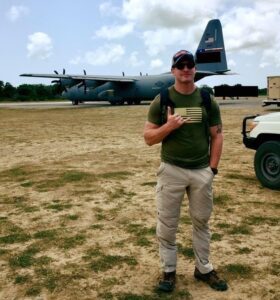 CTT2 Tom Elling at Camp Simba in Kenya
CTT2 Tom Elling at Camp Simba in KenyaTom’s job at the JSOC was Airborne Systems Operator. That meant he helped the JSOC conduct intelligence, surveillance, and reconnaissance operations in support of U.S. forces operating in the U.S. Central Command and U.S. Africa Command areas of responsibility. He enjoyed the work and the people he worked with, as they had become tight during the deployment workups and on the deployment itself. Every mission he flew was an adventure.
One opportunity Tom always looked forward to during missions was landing in Somalia to refuel, especially around breakfast. He would contact the air traffic controller ahead of time and ask her to send out food and drinks for the crew while the plane was being serviced. It provided a nice break in the mission, although the heat in the back of plane when it was on the tarmac could be stifling. By the time the plane took off again, every inch of Tom’s clothing would be soaked through with sweat.
In addition to his in-flight responsibilities, Tom served as the team’s driver from the base camp to the airfield, which proved a challenge at first because the Land Rover he drove had a manual transmission. Once he mastered it, though, he enjoyed driving the stick shift. He also learned two important Swahili phrases, “Jambo” and “Asante”, so he could greet and thank the guards at the airfield, which they seemed to appreciate.
During his free time, Tom made an effort to see African wildlife. When he ran by the river near the base camp, the area would be filled with baboons. He had been told not to make eye contact with them or they might attack, so he looked toward the sky whenever they came near. Occasionally he and his buddies drove out in the bush to what had been a watering hole for hippos before it dried up. When they drove by villages, local kids would run after the Land Rover hoping some candy or trinkets might be tossed their way. Tom also bought some handmade souvenirs from a local woodcarver, including a giraffe for his mother, an elephant, and a short staff with an intricately carved lion’s head.
When the nine-month deployment came to an end, Tom and the rest of the members of the JSOC retraced their steps to the United States, flying back on the Navy “rotator” flight from Addis Ababa to Baltimore via a number of regularly scheduled intermediate stops. He was excited to get home to see his family, but soon his life fell back into his pre-deployment routine, now made more boring since he’d experienced the adrenaline and camaraderie of a deployment with special operations forces.
As soon as Tom started drilling again with his Reserve unit at the NOSC in Buffalo, he let everyone know he wanted to transition from the Reserve to the active Navy so he could do other than odd jobs hoping something good would come along. His unit heard his request and got him one-year active duty orders to the Navy Information Operations Command (NIOC) in Hawaii. The orders were perfect because the NIOC needed a CTT, although they involved a relatively quick turnaround after Tom’s return from Djibouti.
Tom reported to NIOC Hawaii, located onboard Joint Base Pearl Harbor-Hickam, in September 2018. He was assigned to the Cryptologic Direct Support Element, focusing primarily on electronic signals intelligence. This meant he helped interpret information gained from electronic signals emitted from things like radars, weapons systems, and aircraft, although his first three months at the NIOC were devoted to working with the administrative staff trying to fix a pay problem resulting from his transition to active duty. That meant he was in Pearl Harbor on the seventy-seventh anniversary of the attack on Pearl Harbor. He spent the day aboard the USS Arizona Memorial running American flags up and down the staff so they could be used to commemorate the anniversary of the attack.
Once Tom’s pay problem was resolved, he deployed during the first week of January 2020 for six months to Yokosuka, Japan, to work onboard the USS Blue Ridge (LCC-19), the flagship of the three-star admiral commanding the U.S. Seventh Fleet. Tom’s sponsor was a female sailor who picked him up at Tokyo’s Narita International Airport, about a three-hour drive from the Blue Ridge in Yokosuka. They finally arrived onboard the ship late at night, but because Tom was assigned to male berthing, his sponsor could not escort him all the way to the compartment. Instead, she got him close and gave him the directions he needed and then sent him on his way. As he had never been on a ship before, he promptly got lost and wandered around carrying his heavy sea bag until he finally found the right place. Worn out after the long trip, he grabbed an open rack and went to sleep. The next day when the other sailors in the berthing compartment saw Tom had reported onboard, they welcomed him and helped him get acclimated to the ship. Then that night, they took him to the Honcho (“Honch”) bar district of Yokosuka and made sure he had a great time.
Thus began Tom’s time onboard USS Blue Ridge. During the day, he stood watch and familiarized himself with the equipment he would use once the ship got underway. He also ate three meals a day and worked out, and then at night went out to the Honch with his new friends to have some fun. The cycle repeated itself every day until the Blue Ridge finally got underway later in January.
Being the Seventh Fleet’s command ship, the USS Blue Ridge had some wonderful port visits scheduled and Tom looked forward to all of them. However, after the ship made calls in Okinawa, South Korea, and Thailand, COVID-19 hit and the ship’s remaining port calls were cancelled. Instead of visiting exotic ports in the western Pacific, Tom and the rest of the crew at one point spent seventy-two consecutive days at sea without a port call, breaking the ship’s previous record of sixty-four days set in 1972 as American involvement in the Vietnam War drew to a close. For Tom, that meant working seventy-two consecutive days without a break.
One highlight of the cruise occurred when the Blue Ridge crossed the equator. Tom recalls the water being completely still, just like reported by sailors on sailing ships caught in the doldrums. As crossing the equator is a significant milestone in a sailor’s career, the ship held a raucous two-day crossing the line ceremony (much like a fraternity initiation), where uninitiated “pollywogs” like Tom became “trusty shellbacks” after appearing before King Neptune’s court. Tom participated in the ceremony after coming off a twelve-hour overnight watch, so it proved challenging for him to make it all the way through to the end. After the ceremony, Tom received an official certificate signed by King Neptune documenting his trusty shellback status.
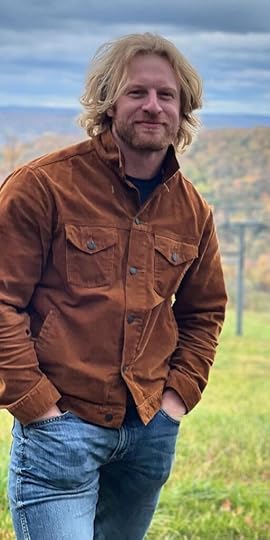 Tom Elling
Tom EllingThe Blue Ridge finally returned to its home port in Yokosuka in June 2020. Since Tom was only assigned to the ship for the deployment, he said goodbye to his friends and returned to NIOC Hawaii at Joint Base Pearl Harbor-Hickam. Now at the end of his one-year NIOC Hawaii active duty assignment, he had to decide what was next. He heard he could be sent to an aircraft carrier for a nine-month deployment, but after having just completed a similar assignment onboard USS Blue Ridge, he was not at all excited about that option. He also learned he had been picked up for conversion to the full-time active duty Navy, so he returned to Buffalo to complete the necessary paperwork and identify his next assignment.
That next assignment turned out to be providing direct signals intelligence support to U.S. submarines, which meant Tom had to report to Pensacola for additional training in January 2021. Although he completed the required training, he did not report for his follow-on assignment because he did not want to be vaccinated for COVID-19. Accordingly, he was assigned to the Region Legal Service Office Southeast Detachment Pensacola Legal Assistance Office, helping Navy attorneys provide legal services like powers of attorney, wills, and notaries to sailors and their families at Naval Air Station Pensacola. Finally, in November 2022, Tom and the Navy parted ways when Tom was discharged with an Honorable Discharge in recognition of his many years of service to the Navy.
After his discharge, Tom returned to Kenmore, New York, where he took a sales job with an industrial supply company. He worked there for about six months until an apprenticeship opportunity opened through IBEW Local 41, offering him the opportunity to become an electrician. Tom jumped at the chance and was accepted in May 2023. He remains in the program today and really enjoys the work. He is looking forward to becoming a fully qualified electrician.
Voices to Veterans is proud to salute CTT2 Thomas Elling, U.S. Navy. Never satisfied to simply mark time, Tom volunteered to deploy twice to the far off reaches of the globe, processing signals intelligence in support of U.S. operating forces. The information he provided helped ensure mission accomplishment and kept U.S. forces ready for any contingency. We thank him for his service and wish him fair winds and following seas.
If you enjoyed Tom’s story, please sign up for the Voices to Veterans Spotlight monthly newsletter by clicking here. Once each month, you’ll receive a new written veteran’s story directly in your mailbox. Best of all, it’s free and you can unsubscribe at any time.
The post CTT2 Thomas Elling, U.S. Navy – Deploying to Two Theaters as a Navy Cryptologic Technician first appeared on David E. Grogan.
March 20, 2024
AW1 Carl F. Mottern, U.S. Navy Reserve (Retired) – Dedication and Hard Work Pays Off
Everyone has dreams for their life – things they would like to achieve. For most, translating those dreams into reality is the difficult part. It takes hard work, dedication, and sometimes a little luck. Without those elements, dreams stay just that. Aviation Anti-Submarine Warfare Operator First Class Carl F. Mottern, U.S. Navy Reserve (Retired), wouldn’t let his dreams die. When others dropped out because the barriers seemed insurmountable, Carl redoubled his efforts and kept at it, never giving up. His determination made leaders take notice and drove him to success as a search and rescue swimmer and Naval aircrewman. This is his story.
Carl’s father, Frank Mottern, was a crew chief on a B-24 Liberator bomber during World War II. An ear drum condition prevented him from going overseas, so he served in a training role at the Aerial Gunnery School located at Harlingen Air Base in south Texas. Desiring duty overseas, Carl’s father remarked “we fly as high in Texas as they do in Europe”, but the Army Air Corps wouldn’t listen. Finally, in 1945, Army physicians declared his father’s ear drum cured, and he was transferred to Chanute Field in east-central Illinois for B-29 Superfortress crew training. When the war ended with the surrender of Japan September 2, 1945, his training stopped.
After his discharge from the Army Air Corps in March 1946, Carl’s father returned to Tonawanda, New York, where he found the Bell Aircraft plant he’d worked at during 1942 and 1943 in a stand down. Accordingly, he took a job in 1949 with the Tonawanda Chevrolet Engine Plant, where he worked until he retired in 1985. Carl’s mother, Helgi Halling, was a war refugee from Estonia. Her family fled Estonia after the Soviet Army arrested her father, an officer in the Estonian Army. She and her remaining family members arrived in New York onboard the transport ship General C. H. Muir (AP-142) in 1947. She eventually worked her way to Buffalo, where she met and married Carl’s father.
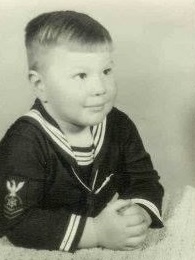 Carl at age 2 in a Navy sailor’s outfit
Carl at age 2 in a Navy sailor’s outfitCarl was born in April 1957 in Tonawanda, the first of three children. He attended Kenmore West Senior High School and played junior varsity baseball and club hockey, but he particularly enjoyed the photography club after taking a photography class at school. He also worked throughout his high school years because he wanted his own pocket money. He started with a paper route and moved on to become an emergency dishwasher for the Your Host family restaurant chain, filling in for full-time dishwashers when they called in sick. On weekends, that meant sometimes pulling the 11:00 p.m. to 7:00 a.m. shift, even though he was too young to work those hours. He also worked for Federal Meats, a high-end Buffalo deli with locations in Tonawanda, Buffalo, and nearby Niagara Falls.
By the time Carl reached his senior year, he knew what he wanted to do after high school. He’d heard his father’s and his godfather’s flying stories for years, so he knew his career had to involve flying. He’d also watched Navy helicopters recover astronauts returning from space after their capsules splash landed in the Atlantic Ocean, which he thought looked exciting. His first inclination was the Air Force, but the Air Force could not guarantee he would get a flying job if he enlisted. That left the Navy, so in the fall of his senior year in 1974, he marched to the Navy recruiting office in Tonawanda and told the recruiter, Petty Officer Randy Wulf, “I want to join the Navy right now.”
This was fast even for the recruiter, who first had to verify Carl was a qualified candidate by administering screening tests and determining if he was physically qualified. When everything checked out, he arranged for Carl to take the Armed Forces Vocational Aptitude Battery (ASVAB) test and get a more thorough physical, and then drove him home. Carl’s mother saw him get out of the recruiter’s car and once he got in the house, asked him who dropped him off. Carl told her it was a Navy recruiter and that he’d joined the Navy, to which she replied, “You’ll quit that like you’ve quit everything else.” By chance, Carl’s dad pulled into the driveway after work and walked in on the conversation. Carl’s mom told him, “Guess what Carl has done? He’s joined the Navy.” Without missing a beat, Carl’s dad replied, “Good for him. If I were twenty years younger, I’d join with him.” With that, the matter was settled – he had his parents’ support.
As the enlistment process continued, Carl passed his physical and completed the ASVAB test. He was afraid he had not scored well on the test because he was not good at math, but he did well, nonetheless. When Petty Officer Wulf relayed the ASVAB results to him and asked him what he wanted to do in the Navy, Carl suggested Photographer’s Mate, abbreviated “PH”, because the job involved his two loves, photography and aviation. Petty Officer Wulf told him photography was a dead-end job because there was a glut of PHs as a result of the post-Vietnam War drawdown. He suggested as an alternative Naval Aviation Anti-Submarine Warfare Operator, abbreviated “AW”, which would guarantee Carl flying duty. That sounded great to Carl, so on December 20, 1974, he signed the enlistment paperwork at the Military Entrance Processing Station (MEPS) in Buffalo and was sworn into the Delayed Entry Program. That program allowed him to select a future date after his high school graduation to report for active duty. Wanting to enjoy the summer of 1975 still as a civilian, he selected September 8, 1975.
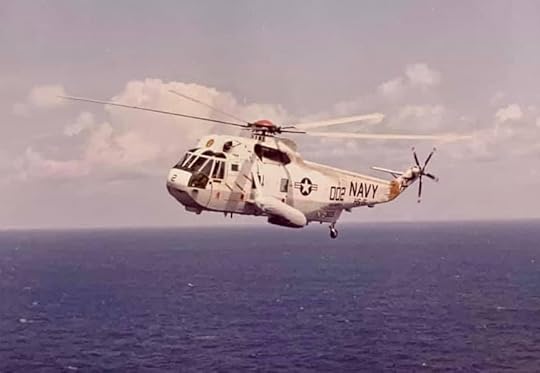 An SH-3 Sea King helicopter from HS-15 flying over the Virginia Capes Operating Area in the spring of 1977
An SH-3 Sea King helicopter from HS-15 flying over the Virginia Capes Operating Area in the spring of 1977Carl graduated from Kenmore West Senior High School in June 1975. He spent the summer having fun, including going out with a girl he’d met during his lunch breaks at Federal Meats, Veronica “Ronnie” Capello. Together they went to concerts, movies, and ball games, packing in as much time together as they could. Then, on September 8, he said goodbye and flew from Buffalo to Chicago for boot camp at Recruit Training Command on board Naval Station Great Lakes, just north of Chicago. He arrived in the middle of the night, so his in-processing did not begin until the next morning.
When morning arrived, Carl and the other new recruits were escorted to the galley for breakfast. While waiting in line, he heard someone behind him hurling insults about guys from Kenmore. Unable to ignore it any longer, Carl turned to see who was verbally assailing him and saw a friend, Don Wojnar, who had graduated from high school but had joined the Navy a month before Carl. Don would have a long career in the Navy, eventually retiring as a Chief Petty Officer (E-7).
Carl found boot camp relatively easy, primarily because he wanted to be there. Others did not, evidenced by Carl’s company shrinking in size from about ninety members at the beginning of training to around seventy-five at the end. Still, it was not all rosy. During one inspection, Carl’s company commander, a former boxing champion, smacked him so hard it knocked his jaw out of place. Carl said nothing about it, hoping it was an isolated incident, but he never forgot it. Either did his company commander because at graduation he announced to the company while looking directly at Carl, you can file a complaint if you think you’ve been abused, but that means you’ll just have to stay here longer. Carl had no intention of doing either, so he let the incident pass.
Carl graduated from boot camp on Friday, November 7, 1975. His parents drove from Tonawanda for the ceremony and spent the weekend with Carl touring the city of Chicago. When they started their trek back to New York, they got caught in the same winter storm that sank the Edmond Fitzgerald on Lake Superior on November 10, as did Carl, who remained onboard Naval Station Great Lakes until November 13. Carl then took leave to fly home to visit Ronnie and spend some more time with his parents before he had to report to his next duty station. As he walked through Chicago’s O’Hare Airport in his Navy uniform, a man working at a shoeshine station asked Carl if he wanted a shine. With money in his pockets and feeling like the richest man in the world, he sat down for a shoeshine and basked in the reality that someone else was shining his shoes for the first time since he’d arrived at boot camp.
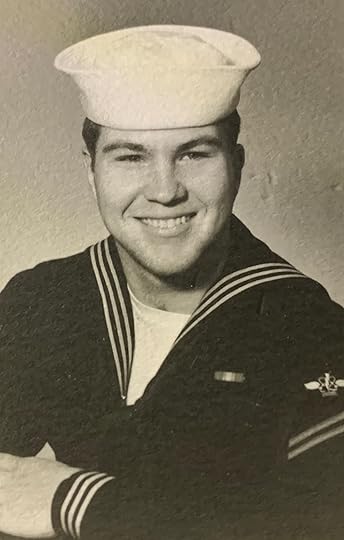 Airman Apprentice Carl Mottern at Naval Air Station Memphis
Airman Apprentice Carl Mottern at Naval Air Station MemphisAfter spending two weeks at home, Carl reported to AW “A” school in late November 1975 onboard Naval Air Station Memphis in Millington, Tennessee. There he began to learn about the science of detecting and attacking enemy submarines lurking beneath the oceans’ surface. Each week he learned new material and had to pass a test on Friday to continue in the training. Unexpectedly, his difficulty with math caught up with him because the curriculum included working with the formulas necessary for fighting submerged submarines, equations for calculating radar parameters and capabilities, and salinity computations to determine how sound propagates through ocean water. Although he failed some of the Friday tests, he was determined to succeed, so his instructors permitted him to retake the necessary classes until he had sufficient command of the material to pass the Friday exams.
Carl was not the only person retaking some of the course work. There were also Iranian students in the class who had repeatedly taken the classes and were so well-versed in the material, they tutored the American students during the week. On Friday, though, they failed the tests because they did not want to go back to the Shah’s navy in Iran. As long as they remained in the school, they were permitted to stay in America, and some of the students took full advantage of that option. The Iranian students’ fears were well-founded, because less than three years later, the Shah of Iran was overthrown during the Iranian Revolution.
Carl graduated from “A” school on March 25, 1976. For his follow-on assignment, he requested duty on helicopters rather than fixed wing aircraft because he wanted to do rescues at sea like the rescue swimmers he’d seen recovering astronauts on television. His determination proved convincing, and he received orders to HS-1, the SH-3 Sea King helicopter Readiness Air Group (RAG) training squadron located onboard Naval Air Station, Jacksonville, in Jacksonville, Florida.
Wanting to save his leave so he could marry Ronnie later in the summer, Carl reported directly to HS-1 from Millington without taking any time off. He arrived before the next round of training was to begin, so he was escorted around to meet the instructors. When one of the instructors, a First Class Petty Officer (E-6), asked where he was from, Carl told him Tonawanda. The instructor replied, “I jumped off the Grand Island Bridge there!” Carl remembered his father commenting about the event when he was about six years old, stating “some nut jumped off the Grand Island Bridge.” Now Carl knew the nut – he was Petty Officer Al Sloniker. He’d done it on a bet and had friends in a boat on the Niagara River below the bridge waiting to pick him up. He was arrested afterwards, but had since channeled his desire to jump in the water into a career as a Navy Search and Rescue (SAR) swimmer. He and Carl hit it off and became lifelong friends.
Although Carl had his heart set on becoming a SAR swimmer, he had a lot of skills to master first. To begin with, he was not an experienced swimmer, so he struggled through the first class. At the end of instruction, he had to pass a practical SAR swimming exam where he was dropped into a rescue scenario with various victims. He had to prioritize those he helped and then use the correct procedures in doing so. He failed, as did about forty percent of his class. The difference between Carl and most others was he was committed to success. As with the “A” school math classes, he convinced a board of instructors he wanted to be a SAR swimmer and would put in the necessary work to make it happen. The board gave him another chance.
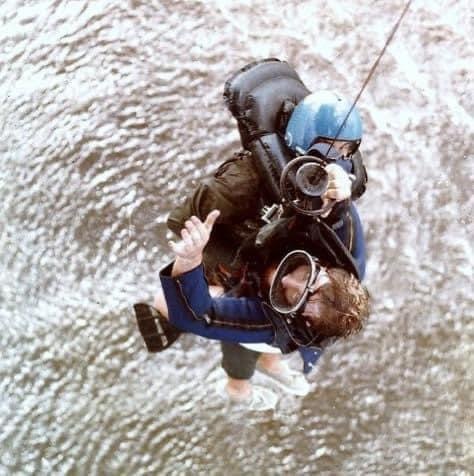 Carl Mottern (wearing a diver’s mask) being hoisted into an SH-3 Sea King helicopter with a Navy pilot after conducting a training rescue in the St. John’s River
Carl Mottern (wearing a diver’s mask) being hoisted into an SH-3 Sea King helicopter with a Navy pilot after conducting a training rescue in the St. John’s RiverWhen the next SAR class started, Carl sat up front. The instructor, Petty Officer Sloniker, addressed the class and said, “Do you see this guy in the front row? It’s Carl Mottern. He’s here because he wants to be here. I know he will pass with flying colors.” Petty Officer Sloniker’s faith in him gave Carl all the boost he needed. Not only did he pass the practical exam with flying colors, but he also did so on the part of the SAR test he had not taken before. When he finished on June 11, 1976, Petty Officer Sloniker told him, “Congratulations, you are a SAR swimmer.” It was one of the proudest moments of Carl’s life. The training then culminated with a live SAR exercise jump into the St. Johns River. Not only was it Carl’s first live SAR jump from a helicopter, but it was also his first ride in a helicopter period!
Carl had just one day to celebrate before heading off with his SAR classmates and some newly arriving pilots to Naval Air Station Brunswick, Maine, for Survival, Evasion, Resistance and Escape (SERE) training. This training taught Carl how to react in the event he was ever captured by enemy forces. It began with his cadre’s arrival at a camp where they learned they had been captured by the People’s Republic of North America. Carl was tossed onto a flatbed truck with another prisoner landing on top of him. That prisoner was a big Naval Academy football player whose size and weight made it hard for Carl to breath. Once they arrived at their destination, the captors slapped Carl and the other prisoners around, blew smoke in their faces, stripped them naked and put them in a cell, and deprived them of both sleep and food. The ordeal seemed so real, soon all the prisoners forgot it was training. At the end, they were all lined up in formation and told to turn around toward the camp’s guard tower. As they did, an American flag unfurled downward and the Star-Spangled Banner began to play. There was not a dry eye among the participants – they had survived!
Again, Carl had little time to celebrate. After a hot meal at the Naval Air Station Brunswick galley, Carl and the other trainees returned to HS-1 in Jacksonville to begin the flight phase of their training. Now Carl studied anti-submarine tactics and learned how to use the SH-3 Sea King helicopter’s sonar and radar equipment by practicing on simulators. He put what he learned into practice by flying on SH-3s off the coast of Florida in the Mayport operating area (OPAREA), using the helicopter’s radar to detect ships and dropping sonobuoys and dipping the sonar sensor in the ocean to detect and track submerged submarines. During the flights, his instructors set off inflight emergencies by doing things like tripping circuit breakers to teach him the correct way to respond and not to panic. They drilled him with verbal questions to ensure he knew his responsibilities and equipment inside and out. He also learned to control the helicopter from the rear station and practiced ditching procedures in case the helicopter had to make an emergency water landing.
The training was intense and participants were not permitted to take leave until they had completed all elements. That created a slight problem for Carl as he had proposed to Ronnie and their wedding date, August 21, 1976, was fast approaching. When Carl could wait no longer, he put in special request chit to ask off for Friday, August 20. His instructor, AW1 Larry Bryant, who had himself survived a helicopter crash at sea earlier in the summer, reminded Carl leave was not authorized during training periods. He also reminded Carl if the Navy wanted Carl to have a wife, the Navy would have issued him one. Yet despite that hard exterior, Petty Officer Bryant had a soft spot and authorized Carl’s leave. Accordingly, Carl flew to Buffalo after work on Thursday, August 19, got married on Saturday, August 20, and brought Ronnie back to live with him on Sunday, August 21. Then it was back to training on Monday morning!
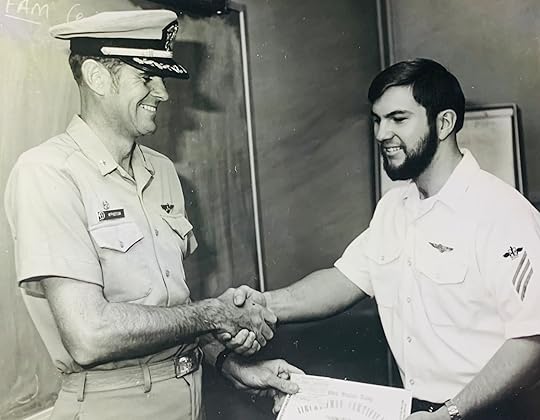 Commander Roger McPherson (left) presenting Airman Carl Mottern (right) with his Naval Aircrewman wings
Commander Roger McPherson (left) presenting Airman Carl Mottern (right) with his Naval Aircrewman wingsOn November 5, 1976, Carl completed the last phase of his training and was officially designated a Naval Aviation Anti-Submarine Warfare Operator. He was now authorized to wear the wings of a Naval aircrewman on his uniform, which Ronnie pinned on him at the ceremony. Then, with his training complete, he walked across the hangar to his first operational SH-3 Sea King squadron, the Red Lions of HS-15. He was assigned to the Aircrew Division, working for the division chief, AWC Ken Muller. Chief Muller told him, “I hate to tell you this, but before you can start work in the division, you’ve got to work in the 1st Lieutenant’s Division. You’ll be thankful for this later.”
Working in the 1st Lieutenant’s Division was another way of saying the new guys must pay their dues. Carl and another new arrival, Airman Joe Brill, had to work in the coffee mess, clean toilets, mop and wax floors, and generally keep the squadron spaces looking good. Occasionally, AWC Muller would grab Carl and take him for a flight just to give him a break. Finally, when Carl’s time was up, he returned to the Aircrew Division and was ready to go.
The first opportunity for Carl to do just that came in January 1977 when he was selected to crew one of three helicopters training at the Atlantic Undersea Test and Evaluation Center (AUTEC) range off the coast of the Bahamas. There the three helicopters got to practice finding and chasing submarines and even dropping exercise torpedoes to simulate an attack. After each day’s flights, they returned to the base on Andros Island where they enjoyed snorkeling, scuba diving, fishing, great seafood, and even a few beers.
With that training under their belts, Carl and the other HS-15 helicopters and crews were ready to start working up on the aircraft carrier USS America (CV-66) in preparation for the ship’s next deployment. As the America was getting ready to come out of the yards in Portsmouth, Virginia, and the squadron was in Jacksonville, Carl and some of the other members of the squadron flew as part of an advanced party to Virginia to board the ship there. When Carl saw the ship at the pier for the first time, it was so giant he was sure he would get lost onboard. Soon, though, he settled into a routine as he became familiar with the ship and how to live onboard.
Once the ship got out to sea, all the fighters and reconnaissance aircraft flew onboard to begin refreshing their carrier landing and takeoff skills. Included among those aircraft were the SH-3 Sea Kings from HS-15. On the second day of flight operations, Carl was in a helicopter flying some distance away from the America conducting plane guard duties. That meant if an aircraft crash landed in the water, Carl’s helicopter would be the first responder responsible for rescuing the downed pilot and aircrew. During a break in the flight operations cycle when no planes were flying, the America suddenly called “man overboard.”
Carl could feel the adrenaline in his veins. Here he was, in only his second day at sea, and he was going to have to go into the icy Atlantic Ocean to rescue a sailor if they were lucky enough to find him. He slipped into his wetsuit as the SH-3’s pilot guided the helicopter to where the sailor should be. When they spotted him, the pilot brought the helicopter down to within ten feet of the water and Carl jumped in the save him.
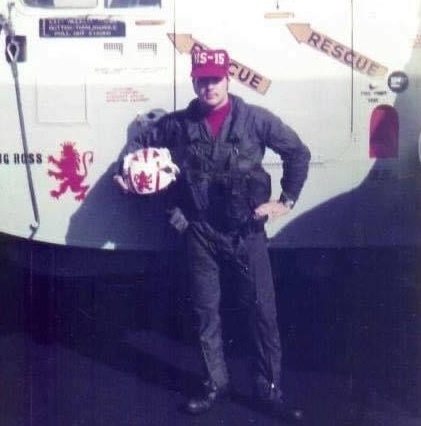 Carl standing next to an HS-15 Sea King helicopter onboard the USS America (CV-66) in Rio de Janeiro in June 1977
Carl standing next to an HS-15 Sea King helicopter onboard the USS America (CV-66) in Rio de Janeiro in June 1977When Carl found him, he turned out to be “Oscar”, the dummy used in man overboard drills. Surprised but thankful, Carl helped hoist Oscar onboard the helicopter for the return flight to the America. Once onboard, Carl was taken to sick bay to make sure he was okay, especially after being exposed to the elements. There he was told the ship’s commanding officer, Captain Robert B. Fuller (a former POW in Vietnam), said he had done a great job and that since he had successfully conducted a simulated rescue, he was entitled to a simulated brandy (had it been a real rescue, he would have received a real brandy).
The America continued workups throughout the spring of 1977 until it sailed to the southern Atlantic Ocean to conduct operations with the Brazilian Navy. This was exciting for Carl for several reasons. Not only did he get to conduct helicopter operations throughout the period from June 10 through July 19, but he also got to visit Rio De Janeiro and Salvador in Brazil and become a “Shellback” after participating in the crossing the line ceremony when the ship crossed the equator. Carl earned his Shellback certificate, signed personally by Captain Fuller, which he still proudly displays. As if that wasn’t enough, he promoted from Airman (E-3) to Petty Officer Third Class (E-4) on June 16 in recognition of the significant experience he’d gained through his training and operations with the squadron.
Once the America returned to Norfolk and HS-15 returned to Jacksonville on July 19, Carl took two weeks leave. That’s when he found out Ronnie was pregnant with their first child. Unfortunately, on September 29, he had to depart on America again, this time for a six-month deployment to the Mediterranean Sea. Although this was a peacetime deployment, the Cold War with the Soviet Union kept tensions high, especially during interactions with Soviet forces. This occurred in early October, when Soviet Tu-95 “Bear” bombers harassed U.S. ships operating in the Atlantic. Because Carl and HS-15 were at the pointy end of the spear when it came to locating and defending against Soviet submarines, they had to be at the top of their game twenty-four hours a day, seven days a week.
As the incoming aircraft carrier to the Mediterranean Sea and the U.S. Sixth Fleet, the America assumed operational responsibilities from the outgoing aircraft carrier, USS Independence (CV-62) on October 8, 1977. As part of the turnover, HS-15 launched a helo with Photographer’s Mate Jeff Dubose onboard to get a photo of the two massive aircraft carriers anchored near each other in the Bay of Cadiz off Rota, Spain. Also in the photo was the USS Detroit (AOE-4), a supply ship previously commanded by the CO of the America, Captain Fuller. As Carl was the squadron’s camera custodian, Jeff DuBose gave him a copy of the photo.
Over Christmas, one of Carl’s best friends in the squadron, Tom Hayes, took leave to be home with his wife who was ready to give birth. With his own wife now eight months pregnant, Carl wished Tom good luck and told him to send a telegram when the baby was born. During the first week of January 1978, the squadron CO tracked Carl down and told him his wife had a baby girl. Carl was concerned because that would be almost a month early. He looked at the telegram and discovered it was Tom’s new baby, not his, and told the CO. When the CO again tracked Carl down in February to tell him his wife had a baby girl, he smiled and asked Carl if he had the right baby this time.
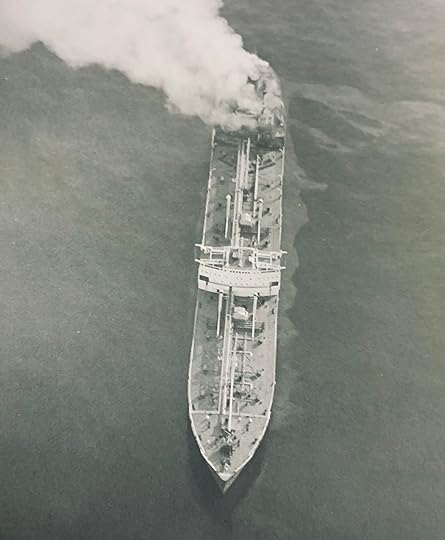 Photo taken from Carl Mottern’s Sea King helicopter of the Indian tanker Jagat Padmini on fire in the Mediterranean Sea in January 1978
Photo taken from Carl Mottern’s Sea King helicopter of the Indian tanker Jagat Padmini on fire in the Mediterranean Sea in January 1978About the same time Tom’s telegram arrived, HS-15 flew supplies to a burning Indian merchant ship, the Jagat Padmini. The freighter was carrying naphtha, a highly combustible petroleum product. Carl’s helicopter flew right over the burning ship taking photos, a dangerous mission considering the ship could have exploded at any moment. On January 9, the crew of the Jagat Padmini had to be evacuated by the USS Nimitz (CVN-68), the USS South Carolina (CGN-37), and the USS Bigelow (DD-942), with the USS Nimitz losing a helicopter in the process. Fortunately, no one on the helicopter was killed.
A distinguished visitor, an Assistant Under Secretary of the Navy related to then-President Jimmy Carter, also visited the ship during the deployment. When it came time for him to be flown off the ship to visit the USS Howard W. Gilmore (AS-16), a submarine tender in La Maddalena, Italy, Carl was part of the aircrew on one of the two HS-15 helicopters flying the mission. Once they landed at Naval Support Activity La Maddalena and boarded the tender, Carl and a crewmember from the other helicopter, AW3 Chris Webber, went to the galley to get some chow. While standing in the chow line, Carl saw a friend of his from high school, Electronic Technician Third Class Joe Cmor, who grew up just three blocks from Carl’s house. After eating, Carl and Chris, who were wearing their green flight suits, walked around the tender. As they did, they saw a submarine tied up alongside the Howard W. Gilmore and decided to see if they could get a tour.
In pursuit of their tour, they crossed over to the submarine, the USS Skipjack (SSN-585). When they arrived on the quarterdeck and made their request, the watch summoned a Lieutenant Junior Grade (O-2), who saw their green flight suits and assumed they were officers. He signed them in and personally gave them a complete tour of the submarine from bow to stern, excluding the nuclear spaces. When the submarine’s CO returned from a meeting onboard the tender with the distinguished visitor, he came across the Lieutenant Junior Grade and asked who the visitors were. The young officer responded, “these are the Secretary’s pilots and I’m giving them a tour.” The CO immediately recognized the officer’s mistake and looked at Carl and Chris and smiled. Then he told the Lieutenant Junior Grade, “When these pilots have left the boat, you come see me right away.” Once back at the helicopters, Carl and Chris told their story and it spread like wildfire. Even the squadron’s CO approached them in the ready room onboard America and jokingly asked about how they had impersonated officers.
Two days after the La Maddalena trip, Carl got a great opportunity for some time ashore. One of the HS-15 helicopters had needed some repair work at the Aircraft Intermediate Maintenance Detachment (AIMD) in Naples, Italy. Carl was selected to be part of the aircrew that would pick it up and fly it back to the ship. That meant launching from the carrier on a twin-engine C-1A “Trader” and landing in Naples, where they picked up the helicopter. They then flew it to Naval Air Station, Sigonella, on Sicily, where they waited until they could fly the helicopter back out to the America. While they were waiting, they took a trip up Mt. Etna, Sicily’s active volcano, and stayed in a luxury hotel, the Excelsior.
Two weeks after Carl’s daughter, Regina, was born, Carl’s CO approached him and told him his daughter was ill and he needed to go home. Carl left the ship and flew out of Palma, weaving his way back to Buffalo, where his wife and daughter were staying during the deployment. Once it was clear his daughter would fully recover, Carl said goodbye to Ronnie and rejoined the America in Naples.
When it came time to head home, the America turned over its operational responsibilities to the next newly arriving aircraft carrier, the USS Forrestal (CV-59). The America and the other ships in her battle group then sailed back across the Atlantic, arriving in Norfolk, Virginia, on April 25, 1978. Carl and HS-15 returned to Naval Air Station, Jacksonville, where Ronnie and Regina joined them. During this post-deployment period, operations were relaxed, with time for squadron bowling teams and softball teams. Carl also continued to practice SAR rescues in the St. John’s River and participate in anti-submarine exercises on the AUTEC range in the Bahamas. HS-15 even hosted a British helicopter squadron visiting the United States aboard the British aircraft carrier HMS Ark Royal (R09).
Finally, it came time to begin working up for the next deployment. This time, HS-15 would deploy onboard the aircraft carrier USS Independence (CV-62), the ship from which the America had assumed operational responsibilities in the Mediterranean Sea in October of 1977. In preparation for the deployment, Carl and HS-15 participated in the ship’s workups, which meant conducting exercises and flight operations in the Caribbean.
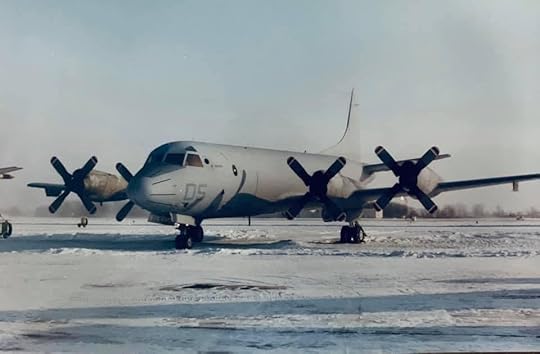 A P-3B Orion at Naval Air Facility Detroit in January 1994
A P-3B Orion at Naval Air Facility Detroit in January 1994Carl never felt at home on the Independence. The ship was older than the America and had less space for HS-15. The squadron had inadequate storage to stow its equipment and sailors were constantly getting their personal gear stolen. The theft problem was significant enough to keep Carl from bringing his camera onboard because he was afraid he would lose it. As a result, he has no pictures documenting his time onboard the Independence.
As the ship’s June 1979 deployment to the Mediterranean Sea neared, Carl had to make a reenlistment decision. Because Ronnie did not like living in Jacksonville – she wanted to move north – Carl reenlisted in return for orders to VP-8, a P-3 Orion squadron located at Naval Air Station Brunswick, Maine. This meant once he transferred, he would no longer be flying on SH-3 Sea King helicopters, but instead on the long-range four-engine Lockheed anti-submarine and surveillance plane used by the Navy since the 1960s. Before he could begin his new assignment, he had to deploy with HS-15 on Independence until his transfer date arrived.
That changed in June when HS-15’s Executive Officer (XO) approached Carl and told him he did not have to make the deployment. The XO said Carl had worked hard at the squadron and had earned the right to stay behind. While this was welcome news because he would not have to leave Ronnie and Regina, he also felt guilty because it would leave his squadron short-handed. Carl’s XO told him not to worry about that – the squadron would make it work. He then bid Carl farewell and sent him on temporary duty to HS-1, where he would work until it came time for him to report to VP-8 in Brunswick.
Carl’s welcome at HS-1 did nothing to alleviate his guilt. When he checked in with the personnel chief, the crusty sailor announced HS-15 was “dumping its trash” on him. He then called the Operations Officer and said “I’m sending you someone to take care of for a while”, which turned out well for Carl because the Operations Officer was a former shipmate from HS-15. The Operations Officer gave Carl some real work, including flying as the sole crewmember for pilot trainees and serving as aircrew for fifty pilot trainee water landings (the SH-3 Sea King helicopter has a boat hull fuselage that permits water landings). The fiftieth trainee water landing was Carl’s last flight on a U.S. Navy helicopter.
In September 1979, Carl began the training pipeline that would eventually take him to VP-8. That meant reporting to the P-3 training squadron, VP-30, in Jacksonville to learn about his new aircraft. He arrived a few days after his son, Michael, was born on September 4, 1979. His training focused on radar so he could serve as a radar operator onboard the P-3, instead of being a sonar operator and rescue swimmer as he had been on the SH-3 Sea King. He completed his training on Friday, December 14, 1979, the same day HS-15 arrived back in Jacksonville after its six-month deployment on the Independence. That night, Carl and Ronnie hosted a big party for all of Carl’s returning shipmates. The movers came the next day and Carl, Ronnie, Regina, and baby Michael started the 1,300-mile drive to Brunswick, Maine, with an intermediate stop in Buffalo for the holidays.
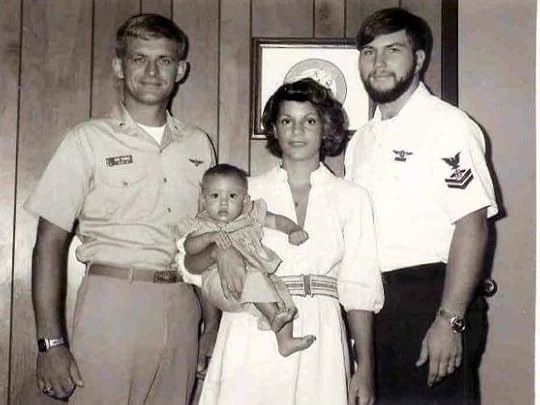 Carl Mottern (right) at his promotion to Second Class Petty Officer, together with his wife Ronnie, their daughter Regina, and Commander Robert Hanke (left)
Carl Mottern (right) at his promotion to Second Class Petty Officer, together with his wife Ronnie, their daughter Regina, and Commander Robert Hanke (left)Carl checked into VP-8 on January 7, 1980. Although he and Ronnie really liked Brunswick, Carl’s tour did not go as well as it could have. To begin with, Carl was now a senior Second Class Petty Officer (E-5) who had done all his time on helicopters. Due to his seniority, he passed up all those junior to him even though their experience was on the four-engine P-3. This created resentment among the junior sailors. To alleviate the situation, Carl was assigned to the training division, which proved to be a good fit. He also got to deploy on a P-3 to Rota, Spain, and Lajes, Portugal, just before Christmas, hunting Soviet diesel submarines in the Mediterranean and ballistic missile submarines in the Atlantic. The deployment was fun except it created resentment among the enlisted aircrew because the officers had arranged for their wives to meet them in Lajes, while the enlisted aircrew had no such opportunity. Carl, for example, spent Christmas in 1980 in Lajes reading a book in his barracks room.
Carl’s youngest child, Frank, was born in March 1981 when Carl was home on a four-day “R&R” break from a deployment to Rota. The baby was born prematurely, so Carl asked for permission to remain in Brunswick to help Ronnie with their newborn and their other two children. When his XO in Rota denied his request, Carl returned to Rota with his crew. He also retrieved a request to extend with the squadron and tore it up. When his XO questioned his actions, Carl told him it was clear to him the squadron did not value him or his family. He avoided the XO from that point on.
Carl completed his tour with VP-8 and then looked for shore duty in Brunswick so he could stay at home with his family without having to deploy for a few years. His detailer, however, told him nothing like that was available. Seeing no other viable options, Carl told his detailer he would take orders as a recruiter provided he could be guaranteed an assignment in Buffalo, New York. Always short on recruiters, the detailer jumped at Carl’s offer and sent him to Buffalo on recruiting duty in January 1982 after he completed Recruiting School in December 1981.
Recruiting duty proved brutal. Although Carl was an excellent recruiter, the pressure to make monthly recruiting goals never ended. To meet those goals, he had to start early in the morning and work late into the night and on weekends. He had to do presentations at schools, track down signatures from both parents for recruits under eighteen even if the parents weren’t in the picture, give recruits rides home, and meet with parents at all hours of the day and night. After each successful month, the goals reset and he had to start all over again on the next month’s quota. The only real benefit of the tour, in addition to promoting to Petty Officer First Class (E-6), was Carl’s and Ronnie’s children got to spend lots of time with their grandparents, something that would have been impossible had Carl taken orders to another squadron.
As Carl’s enlistment drew to a close in early 1985, the XO of the Naval Recruiting District offered to extend Carl in his current job. She could not, however, promise Carl would make Chief Petty Officer (E-7). More important, Ronnie didn’t want to move anymore. She liked where they lived and wanted to settle down. Accordingly, on May 5, 1985, Carl was discharged from active duty in the Navy.
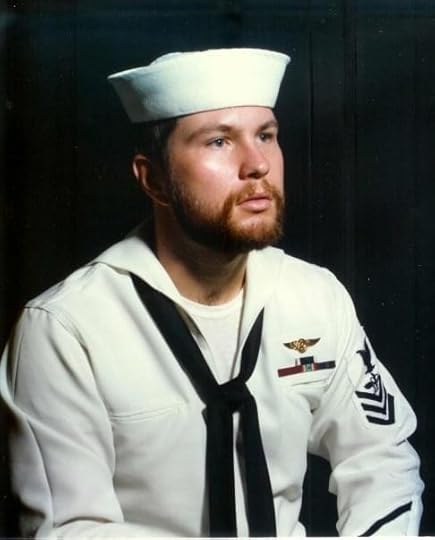 AW1 Carl F. Mottern, U.S. Navy (Retired)
AW1 Carl F. Mottern, U.S. Navy (Retired)While Carl’s active duty career had ended, his Reserve career was just beginning. A friend of his from HS-15, Tom Hayes, recommended he try VP-93, a Reserve P-3 squadron located at Naval Air Facility Detroit onboard Selfridge Air National Guard Base. This worked great for Carl as it would allow him to pursue a civilian career and keep his family in Buffalo, while still serving in the Navy. He made it official on May 16, 1985, enlisting in the Reserves after a break of only eleven days since his discharge from active duty.
VP-93 made the Navy fun again. Carl drilled one weekend each month and an additional two weeks each year, plus as many extra drills and active duty periods as he could get, honing his Navy skills. His duties took him to Hawaii, the Mediterranean, and the Caribbean, not only hunting Soviet submarines, but also searching for drug smugglers trying to bring illegal drugs into the United States by sea. Even drilling proved easy because the squadron flew a plane from Selfridge to Buffalo to pick Carl up. Such pickups, which were routine for squadron members, served the dual purpose of giving the P-3 pilots the cross-country flight time they needed and alleviating the need for the aircrew to take off time from their civilian jobs to fly or drive to Detroit.
Even more important, the squadron members were tight with one another, just like the camaraderie Carl experienced at HS-15. They looked out for one another and cared about each other’s families. If someone needed a place to stay when they came into town, they opened their doors to each other rather than requiring them to stay in a hotel. Carl enjoyed the duty so much, he told himself he would stay with VP-93 until they forced him to leave.
Unfortunately, in 1994, VP-93 was slated to be disestablished and Naval Air Facility Detroit closed as part of the post-Cold War drawdown. Accordingly, in March 1994, Carl transferred to another Reserve P-3 squadron, VP-64, at Naval Air Station, Willow Grove, in Pennsylvania, but it wasn’t the same. Not only did he have to drive 375 miles to Willow Grove for each drill weekend, but he also learned he was not selected for Chief as part of the 1995 promotion cycle. As a result, Carl retired from the Navy Reserves on February 1, 1996, ending his Navy career. After the ceremony, he reminded his mother of what she said in 1974 when he told her he was enlisting in the Navy. “You said I would quit, and I never did.” His statement closed a loop that had been open for over twenty years.
[image error]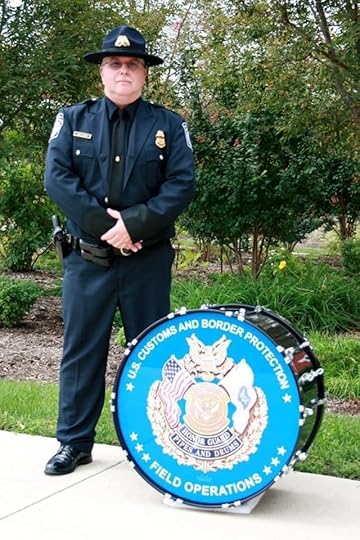 Carl Mottern in his U.S. Customs and Border Protection uniform
Carl Mottern in his U.S. Customs and Border Protection uniformNow out of the Navy, Carl focused on his civilian career. He’d been working for the Veterans Administration since 1993, but in 1997 he found exactly the job he’d been looking for. A U.S Customs Service supervisor, Mike Rozyczko, spotted Carl wearing a VP-64 ballcap at an airshow and introduced himself. He told Carl the U.S. Customs Service was looking for customs inspectors and he encouraged Carl to apply. Carl did and, in January 1997, received notice he had been hired to work as a customs inspector for the Port of Buffalo. One of his bosses was none other than Mike Rozyczko and they became the best of friends. Carl’s Navy experience proved instrumental to his U.S. Customs Service success. He especially enjoyed serving on the Port of Buffalo Honor Guard team, which required him to use the drill and ceremonial skills he’d learned in the Navy. Carl finally retired from U.S. Customs and Border Protection on April 29, 2017.
Carl and Ronnie are now enjoying retirement in Buffalo, New York. They keep busy with their three adult children and three grandchildren, who all live nearby, and they travel extensively and take cruises. Carl even began umpiring local baseball games in 2017. He also is a member of the VP-93 Alumni Association and an associate member of the USS Little Rock Association, which sponsors the museum ship in Buffalo’s Naval Park.
One other passion of Carl’s is the USS America Carrier Veterans Association. Carl joined in 1996 after going on a tour of the ship as it was being decommissioned. He soon became one of the organization’s governing board members and has been active in the 600-member organization ever since. Perhaps his most meaningful activity with the Association occurred in 1999 when he reconnected with the former commanding officer of the USS America, now Rear Admiral Robert B. Fuller. Carl interviewed him and wrote several stories about him for the Association’s newsletter, and escorted him when he attended the Association’s reunion in Jacksonville in 2008. There Carl relayed to him the story of when he’d conducted his first search and rescue swim and then-Captain Fuller had announced “simulated rescue, simulated brandy.” Admiral Fuller responded, “Well, how about I buy you that drink now?” Carl notes the opportunity to share the drink with the Admiral was worth the thirty-year wait. After Admiral Fuller passed away in 2019, Carl attended his funeral at Arlington National Cemetery.
Voices to Veterans is proud to salute Naval Aviation Anti-Submarine Warfare Operator First Class Carl F. Mottern, U.S. Navy Reserve (Retired), for his twenty years of devoted service to our country. His never give up attitude helped him realize his dream of becoming a Navy search and rescue swimmer, setting an example for all those around him. Despite long separations from his family, he went whenever and wherever the Navy called, patrolling the oceans for adversary submarines and drug smugglers and keeping our country safe. We thank him for all he has done and wish him fair winds and following seas.
If you enjoyed Carl’s story, please sign up for the Voices to Veterans Spotlight monthly newsletter by clicking here. Once each month, you’ll receive a new written veteran’s story directly in your mailbox. Best of all, it’s free and you can unsubscribe at any time.
[image error]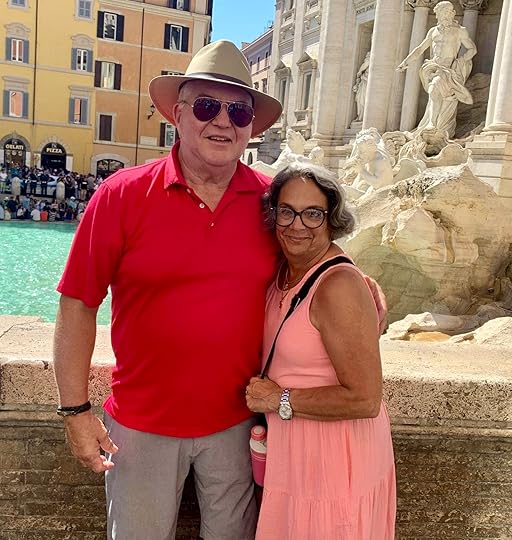 Carl and Ronnie Mottern at Trevi Fountain in Rome, Italy, in August 2023
Carl and Ronnie Mottern at Trevi Fountain in Rome, Italy, in August 2023 The post AW1 Carl F. Mottern, U.S. Navy Reserve (Retired) – Dedication and Hard Work Pays Off first appeared on David E. Grogan.



